Paul van Yperen's Blog, page 74
September 17, 2023
Fanny Ardant
Elegant brunette Fanny Ardant (1949) appeared in more than fifty films since 1976. Initially, her youthful beauty brought her popularity in two films by François Truffaut, but over time her sophistication and acting skills have made her one of France's most admired actresses. She was four times nominated for a César, the French Oscar, and won for Pédale douce (1997). Fluent in English, Spanish and Italian, Ardant has also starred in several international films.
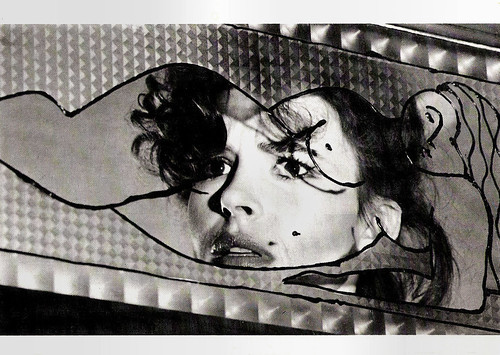
French postcard in the Collection Cinéma by Editions La Malibran, Paris, no. CF 68, 1990. Fanny Ardant in Vivement dimanche!/Confidentially Yours (François Truffaut, 1983).

French postcard by Editions Atlas, Evreux, no. 36. Photo: Gérard Letallier / Télé 7 jours Fanny Ardant and Francis Huster in the TV Mini-Series Les Dames de la Côte (Nina Companeez, 1979).
Tragic lovers
Fanny Marguerite Judith Ardant was born in Saumur, France in 1949. Her father Jean Ardant was a military attaché. Fanny grew up in Monaco where her father worked as an adviser for the royal family. She subsequently spent much of her childhood moving around Europe. At 17, she moved to Aix-en-Provence to study political science at the Institut d'études politiques d'Aix-en-Provence. But she was more passionate about the theatre and took drama classes from Jean Périmony.
In 1974 she made her first stage appearance in 'Polyeucte' by Pierre Corneille. The play was directed by Dominique Leverd, who would be the father of her first daughter, Lumir. Roles in plays by Henry de Montherlant, Jean Racine and Jean Giraudoux followed.
Her film debut was a small part in Marie-poupée/Marie, the Doll (Joël Séria, 1976). For TV she played one of the leading roles in the prestigious Mini-series Les Dames de la Côte/The ladies of the coast (Nina Companéez, 1979) starring Edwige Feuillère .
Legendary film director François Truffaut saw the series and noticed her. Truffaut was captivated by Ardant’s unconventional beauty - her dark eyes, her wide mouth, her triangular face and her deep voice. He invited her to a lunch with Gérard Depardieu , with whom he had just made Le Dernier metro/The Last Metro (François Truffaut, 1980). Dépardieu and Ardant had earlier acted together in the film Les chiens/The Dogs (Alain Jessua, 1979). Truffaut then cast Dépardieu and Ardant as tragic lovers in La Femme d'à côté/The Woman Next Door (François Truffaut, 1981).
Tom Wiener at AllMovie : “The Woman Next Door has a story line right out of a soap opera. Fortunately, it plays like variations of a half-dozen other intelligent Truffaut films on the vagaries of love. Depardieu and Ardant evince such potent chemistry that it's hard not to root for their characters, Bernard and Mathilde, even as you see them slide toward tragedy.” Her role became her international breakthrough and Ardant received her first César nomination for Best Actress in 1982. During the production of the film, the director and actress had fallen in love. Ardant became the last muse and partner of Truffaut. In 1983 she gave birth to their daughter, Joséphine.
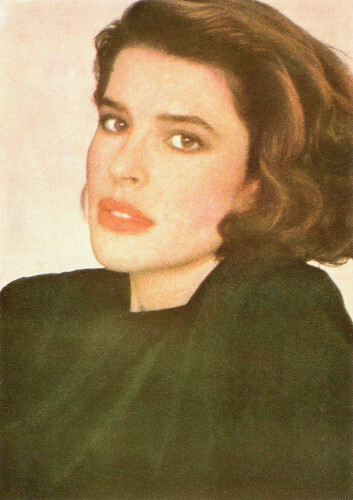
Romanian postcard by Casa Filmului Acin, no. 43034.
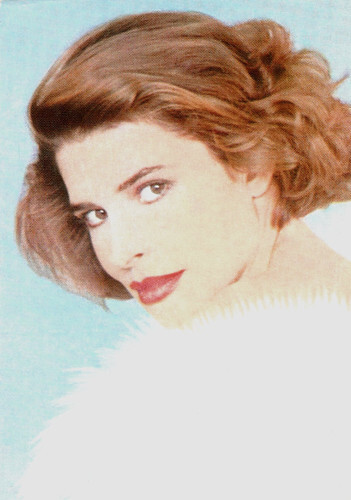
Romanian postcard by Casa Filmului Acin no. C.P.C.S. 43034.
Devastated
By the early 1980s, Fanny Ardant had turned into a major European film star. Fluent in English, Spanish and Italian, she played serious, passionate roles in several international films. In Italy she worked with director André Delvaux at Benvenuta (1983) as a pianist unhappy in love with Vittorio Gassman , and with Ettore Scola at the award winning family drama La famiglia/The Family (1987).
In France, she worked with Truffaut again at the comedy Vivement dimanche!/Confidentially Yours (François Truffaut, 1984), a homage to the Film Noir, shot in black & white. She played a self-assured secretary who helps a murder suspect ( Jean-Louis Trintignant ) to prove his innocence.
James Travers at Films de France : "Stylistically, Vivement dimanche! is an almost faultless pastiche of the classic film noir (laden with countless references to the films of Alfred Hitchcock , Truffaut’s personal hero), but what most gives it its charm is a persistent vein of downbeat humour, which is so wonderfully incongruous with the theme and style of the film. The comic highpoint is the scene in which Fanny Ardant interviews a dumb blonde as her replacement - it has nothing to do with the plot but it is one of the funniest asides in Truffaut’s entire oeuvre."
For her role she received her second César nomination. In 1984, Truffaut died from a cancerous brain tumour, and left Ardant devastated. However, her career flourished. She played several plum roles for major directors. For Volker Schlöndorff, she appeared in his Marcel Proust adaptation Un amour de Swann/Swan in Love (1984) opposite Jeremy Irons , for Alain Resnais in L’Amour à mort/Love Unto Death (1984) with Sabine Azéma, and in Mélo/Melodrama (1986), for Costa-Gavras in Le conseil de famille/Family Business (1986) with Johnny Hallyday .
Later she acted for Michelangelo Antonioni and Wim Wenders in Al di là delle nuvole/Beyond the Clouds (1995). Among her English language roles were Afraid of the Dark (Mark Peploe, 1991) with James Fox, and Sabrina (Sydney Pollack, 1995) with Harrison Ford . Over time, her sophistication and acting skills have made Ardant one of France's most admired and popular actresses.
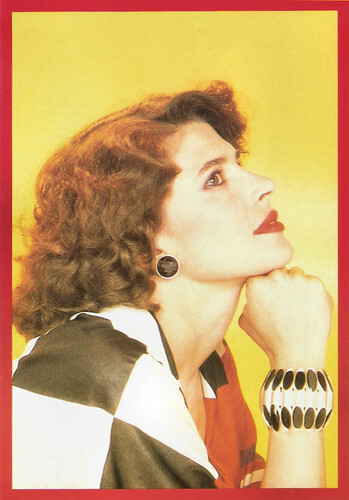
French postcard by Humour a la Carte, no. ST-157.
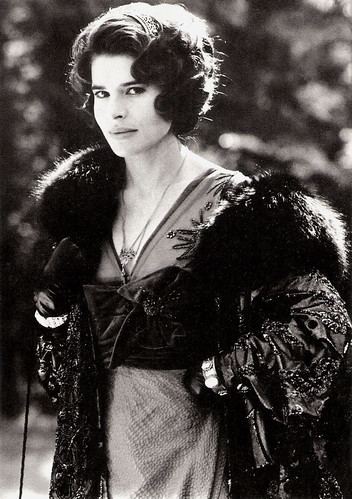
French postcard by Humour a la Carte, Paris, no. 3713.
Acidic noblewoman
In 1996, Fanny Ardant proved her versatility, playing a comedic role in Pédale douce/What a Drag (Gabriel Aghion, 1996) for which she won the 1997 César Award for Best Actress. She spoofed her sophisticated screen image as the confidante of a gay businessman who agrees to pose as his wife to impress a banker and then finds herself romantically pursued by the banker.Another major success was her role as the acidic noblewoman Madame de Blayac at the court of Louis XVI in Ridicule (Patrice Leconte, 1996). This historic film was also very popular with the public, won the César for Best Film and was nominated for an Oscar for Best Foreign Film.
She was then directed by Roman Polanski as Maria Callas in Terrence McNally's play 'Master Class', at the Théâtre de la Porte Saint-Martin. For her portrayal, Ardant was nominated for the Molière award as Best Stage Actress. She portrayed the opera diva again in the English-language film Callas Forever (Franco Zeffirelli, 2003).
A year earlier, she was nominated for another César for 8 Femmes/8 Women (François Ozon, 2002), again a commercial and critical hit. In this whodunit, she got to wrestle Catherine Deneuve . James Travers at Films de France : "Fanny Ardant is stunning (and worryingly convincing) in her role of a totally liberated lesbian prostitute – relishing her stereotypical rendition of the French pute whilst subtly exposing a tragic vulnerability. She is only narrowly eclipsed by Catherine Deneuve , whose portrayal of the self-centred bourgeois husband-cheater is the perfect caricature of the kind of roles which have earned Deneuve her name. Her over-the-top reactions to such revelations as her daughter’s pregnancy and her negro maid’s lesbianism - totally appropriate for the era in which the film is set – are the stuff of classic vaudeville."
Other films were La cena/The diner (Ettore Scola, 1998), Elizabeth (Shekhar Kapur, 1998) featuring Cate Blanchett, Le libertine/The Libertine (Gabriel Aghion, 2000) with Vincent Pérez , Paris, je t'aime (2006) containing 18 seemingly unrelated vignettes by 18 different directors about love in the city of lights, and Roman de gare/Crossed Tracks (Claude Lelouch, 2007). In a 2007 interview, she expressed admiration for Renato Curcio, ex-leader of the militant Brigate Rosse (Red Brigades), saying that it was good of him to adhere to his principles. She later discovered that it would be difficult to attend a film festival in Venice, as her declaration had created a scandal in Italy. The Governor of Veneto declared that he preferred that Ardant would not visit his region. She pleaded for forgiveness from victims of terrorism, and the affair ended.
Fanny Ardant has three daughters: Lumir (1975) with Dominique Leverd, Josephine (1983) with François Truffaut , and Baladine (1990) with cameraman Fabio Conversi. Her later films included Interno giorno (2011), directed by Tommaso Rossellini, grandson of Roberto Rossellini and Ingrid Bergman , and Les beaux jours/The Beautiful Days (Marion Vernoux, 2012). She was three times nominated for the César for her roles in the romantic comedy-drama La Belle Époque (Nicolas Bedos, 2019) with Daniel Auteuil, the drama ADN/DNA (Maïwenn, 2020) and Les Jeunes Amants/The Young Lovers (Carine Tardieu, 2021). She also stars in the upcoming black comedy film The Palace (2023) directed by Roman Polanski.
Trailer for Vivement dimanche!/Confidentially Yours (1984). Source: UmbrellaEntAU (YouTube).
Trailer for Afraid of the Dark (1991). Source: CoolestMovies (YouTube).
French trailer for Cendres et sang/Ashes and Blood (2009). Source: Ardantgroup (YouTube).
Sources: Rebecca Flint Marx (AllMovie), Tom Wiener (AllMovie), James Travers (Films de France), Films de France, Yahoo Movies (now defunct), Wikipedia (French, German and English) and .

French postcard in the Collection Cinéma by Editions La Malibran, Paris, no. CF 68, 1990. Fanny Ardant in Vivement dimanche!/Confidentially Yours (François Truffaut, 1983).

French postcard by Editions Atlas, Evreux, no. 36. Photo: Gérard Letallier / Télé 7 jours Fanny Ardant and Francis Huster in the TV Mini-Series Les Dames de la Côte (Nina Companeez, 1979).
Tragic lovers
Fanny Marguerite Judith Ardant was born in Saumur, France in 1949. Her father Jean Ardant was a military attaché. Fanny grew up in Monaco where her father worked as an adviser for the royal family. She subsequently spent much of her childhood moving around Europe. At 17, she moved to Aix-en-Provence to study political science at the Institut d'études politiques d'Aix-en-Provence. But she was more passionate about the theatre and took drama classes from Jean Périmony.
In 1974 she made her first stage appearance in 'Polyeucte' by Pierre Corneille. The play was directed by Dominique Leverd, who would be the father of her first daughter, Lumir. Roles in plays by Henry de Montherlant, Jean Racine and Jean Giraudoux followed.
Her film debut was a small part in Marie-poupée/Marie, the Doll (Joël Séria, 1976). For TV she played one of the leading roles in the prestigious Mini-series Les Dames de la Côte/The ladies of the coast (Nina Companéez, 1979) starring Edwige Feuillère .
Legendary film director François Truffaut saw the series and noticed her. Truffaut was captivated by Ardant’s unconventional beauty - her dark eyes, her wide mouth, her triangular face and her deep voice. He invited her to a lunch with Gérard Depardieu , with whom he had just made Le Dernier metro/The Last Metro (François Truffaut, 1980). Dépardieu and Ardant had earlier acted together in the film Les chiens/The Dogs (Alain Jessua, 1979). Truffaut then cast Dépardieu and Ardant as tragic lovers in La Femme d'à côté/The Woman Next Door (François Truffaut, 1981).
Tom Wiener at AllMovie : “The Woman Next Door has a story line right out of a soap opera. Fortunately, it plays like variations of a half-dozen other intelligent Truffaut films on the vagaries of love. Depardieu and Ardant evince such potent chemistry that it's hard not to root for their characters, Bernard and Mathilde, even as you see them slide toward tragedy.” Her role became her international breakthrough and Ardant received her first César nomination for Best Actress in 1982. During the production of the film, the director and actress had fallen in love. Ardant became the last muse and partner of Truffaut. In 1983 she gave birth to their daughter, Joséphine.

Romanian postcard by Casa Filmului Acin, no. 43034.

Romanian postcard by Casa Filmului Acin no. C.P.C.S. 43034.
Devastated
By the early 1980s, Fanny Ardant had turned into a major European film star. Fluent in English, Spanish and Italian, she played serious, passionate roles in several international films. In Italy she worked with director André Delvaux at Benvenuta (1983) as a pianist unhappy in love with Vittorio Gassman , and with Ettore Scola at the award winning family drama La famiglia/The Family (1987).
In France, she worked with Truffaut again at the comedy Vivement dimanche!/Confidentially Yours (François Truffaut, 1984), a homage to the Film Noir, shot in black & white. She played a self-assured secretary who helps a murder suspect ( Jean-Louis Trintignant ) to prove his innocence.
James Travers at Films de France : "Stylistically, Vivement dimanche! is an almost faultless pastiche of the classic film noir (laden with countless references to the films of Alfred Hitchcock , Truffaut’s personal hero), but what most gives it its charm is a persistent vein of downbeat humour, which is so wonderfully incongruous with the theme and style of the film. The comic highpoint is the scene in which Fanny Ardant interviews a dumb blonde as her replacement - it has nothing to do with the plot but it is one of the funniest asides in Truffaut’s entire oeuvre."
For her role she received her second César nomination. In 1984, Truffaut died from a cancerous brain tumour, and left Ardant devastated. However, her career flourished. She played several plum roles for major directors. For Volker Schlöndorff, she appeared in his Marcel Proust adaptation Un amour de Swann/Swan in Love (1984) opposite Jeremy Irons , for Alain Resnais in L’Amour à mort/Love Unto Death (1984) with Sabine Azéma, and in Mélo/Melodrama (1986), for Costa-Gavras in Le conseil de famille/Family Business (1986) with Johnny Hallyday .
Later she acted for Michelangelo Antonioni and Wim Wenders in Al di là delle nuvole/Beyond the Clouds (1995). Among her English language roles were Afraid of the Dark (Mark Peploe, 1991) with James Fox, and Sabrina (Sydney Pollack, 1995) with Harrison Ford . Over time, her sophistication and acting skills have made Ardant one of France's most admired and popular actresses.

French postcard by Humour a la Carte, no. ST-157.

French postcard by Humour a la Carte, Paris, no. 3713.
Acidic noblewoman
In 1996, Fanny Ardant proved her versatility, playing a comedic role in Pédale douce/What a Drag (Gabriel Aghion, 1996) for which she won the 1997 César Award for Best Actress. She spoofed her sophisticated screen image as the confidante of a gay businessman who agrees to pose as his wife to impress a banker and then finds herself romantically pursued by the banker.Another major success was her role as the acidic noblewoman Madame de Blayac at the court of Louis XVI in Ridicule (Patrice Leconte, 1996). This historic film was also very popular with the public, won the César for Best Film and was nominated for an Oscar for Best Foreign Film.
She was then directed by Roman Polanski as Maria Callas in Terrence McNally's play 'Master Class', at the Théâtre de la Porte Saint-Martin. For her portrayal, Ardant was nominated for the Molière award as Best Stage Actress. She portrayed the opera diva again in the English-language film Callas Forever (Franco Zeffirelli, 2003).
A year earlier, she was nominated for another César for 8 Femmes/8 Women (François Ozon, 2002), again a commercial and critical hit. In this whodunit, she got to wrestle Catherine Deneuve . James Travers at Films de France : "Fanny Ardant is stunning (and worryingly convincing) in her role of a totally liberated lesbian prostitute – relishing her stereotypical rendition of the French pute whilst subtly exposing a tragic vulnerability. She is only narrowly eclipsed by Catherine Deneuve , whose portrayal of the self-centred bourgeois husband-cheater is the perfect caricature of the kind of roles which have earned Deneuve her name. Her over-the-top reactions to such revelations as her daughter’s pregnancy and her negro maid’s lesbianism - totally appropriate for the era in which the film is set – are the stuff of classic vaudeville."
Other films were La cena/The diner (Ettore Scola, 1998), Elizabeth (Shekhar Kapur, 1998) featuring Cate Blanchett, Le libertine/The Libertine (Gabriel Aghion, 2000) with Vincent Pérez , Paris, je t'aime (2006) containing 18 seemingly unrelated vignettes by 18 different directors about love in the city of lights, and Roman de gare/Crossed Tracks (Claude Lelouch, 2007). In a 2007 interview, she expressed admiration for Renato Curcio, ex-leader of the militant Brigate Rosse (Red Brigades), saying that it was good of him to adhere to his principles. She later discovered that it would be difficult to attend a film festival in Venice, as her declaration had created a scandal in Italy. The Governor of Veneto declared that he preferred that Ardant would not visit his region. She pleaded for forgiveness from victims of terrorism, and the affair ended.
Fanny Ardant has three daughters: Lumir (1975) with Dominique Leverd, Josephine (1983) with François Truffaut , and Baladine (1990) with cameraman Fabio Conversi. Her later films included Interno giorno (2011), directed by Tommaso Rossellini, grandson of Roberto Rossellini and Ingrid Bergman , and Les beaux jours/The Beautiful Days (Marion Vernoux, 2012). She was three times nominated for the César for her roles in the romantic comedy-drama La Belle Époque (Nicolas Bedos, 2019) with Daniel Auteuil, the drama ADN/DNA (Maïwenn, 2020) and Les Jeunes Amants/The Young Lovers (Carine Tardieu, 2021). She also stars in the upcoming black comedy film The Palace (2023) directed by Roman Polanski.
Trailer for Vivement dimanche!/Confidentially Yours (1984). Source: UmbrellaEntAU (YouTube).
Trailer for Afraid of the Dark (1991). Source: CoolestMovies (YouTube).
French trailer for Cendres et sang/Ashes and Blood (2009). Source: Ardantgroup (YouTube).
Sources: Rebecca Flint Marx (AllMovie), Tom Wiener (AllMovie), James Travers (Films de France), Films de France, Yahoo Movies (now defunct), Wikipedia (French, German and English) and .
Published on September 17, 2023 22:00
September 16, 2023
Benoît-Constant Coquelin
Benoît-Constant Coquelin (1841-1909), known as Coquelin aîné (Coquelin the Elder), was a French actor, who was known as one of the greatest theatrical figures of the age.
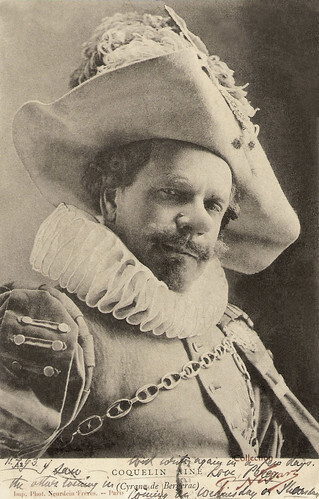
French postcard by Neurdein Frères, Paris, no. 42. Photo: P. Nadar. Constant Coquelin as Cyrano de Bergerac. Sent by mail in 1903.
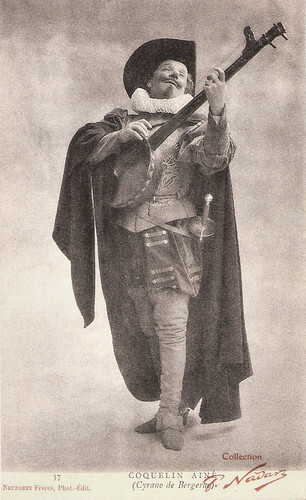
French postcard by Neurdein Frères Photo-Edit, no. 37. Photo: P. Nadar. Caption: Coquelin Ainé (Cyrano de Bergerac).
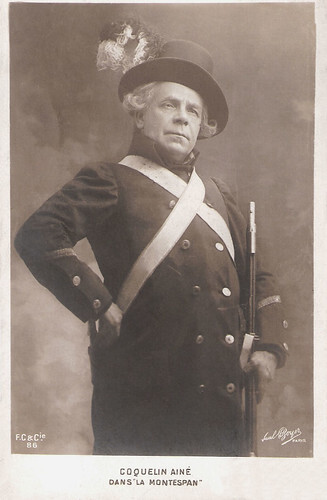
French postcard by F.C. & Cie., no. 86. Photo: Paul Boyer, Paris. Caption: Coquelin Ainé in the play 'La Montespan'.
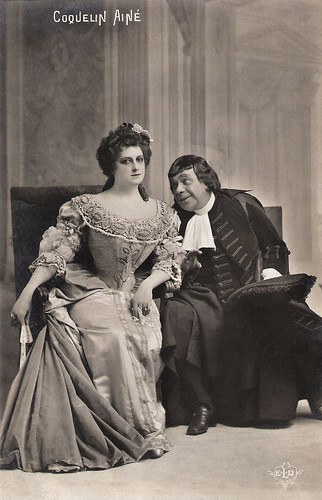
French postcard by ELD. Coquelin with unidentified actress, probably in a Molière play.
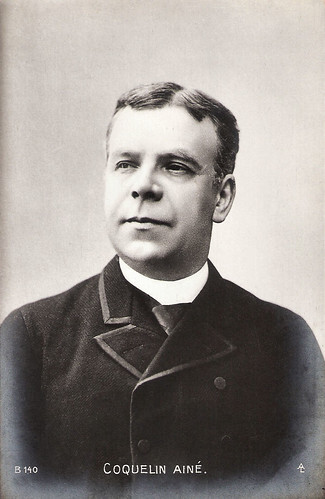
French postcard, no B140. Photo: AL. Caption: Coquelin Ainé.
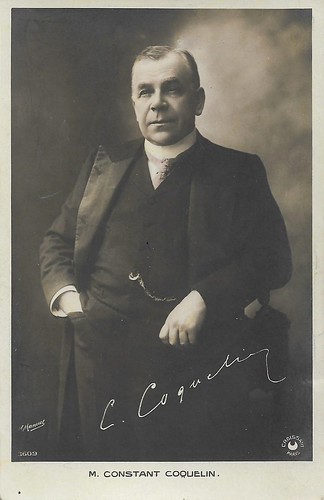
French postcard by Croissant, Paris, no. 3609. Photo: Henri Manuel. Caption: M. Constant Coquelin.
A triumph with 'Cyrano de Bergerac'
Benoît-Constant Coquelin was born in Boulogne-sur-Mer, Pas-de-Calais in 1841. He originally intended to follow his father's trade of baking (he was once called "un boulanger manqué" – "a failed baker" – by a hostile critic), but his love of acting led him to the Conservatoire, where he entered Régnier's class in 1859. He won the first prize for comedy within a year.
Coquelin entered the Comédie-Française in 1860. He made his début on 7 December 1860 as the comic valet, Gros-René, in Molière's 'Le Dépit amoureux', but his first great success was as Figaro in 'The Barber of Seville', in 1861. It was an honour for Coquelin to be a part of the Comédie-Française at such a young age. This company had already been in existence for around 150 years.
He became Sociétaire at the Comédie-Française in 1864. The sociétaires co-manage, choose plays, and share profits. He left in 1887 to go on European and American tours and returned as Pensionnaire between 1890 and 1892. Despite the strict rules of the Comédie not playing afterwards on other stages, Coquelin had a triumph in 1897 with Edmond Rostand's 'Cyrano de Bergerac' and would play it many times.
In 1900, when he was almost sixty, Coquelin toured in America with Sarah Bernhardt and appeared on Broadway's Garden Theatre in a production of 'Cyrano de Bergerac' (Bernhardt played Roxane). On their return to France, he continued with his old colleague to appear in 'L'Aiglon', at the Théâtre Sarah Bernhardt.
For his booming voice and his lyrical and fiery temperament, Rostand wrote 'Chantecler', but the actor died in 1909 before it could be performed by him.
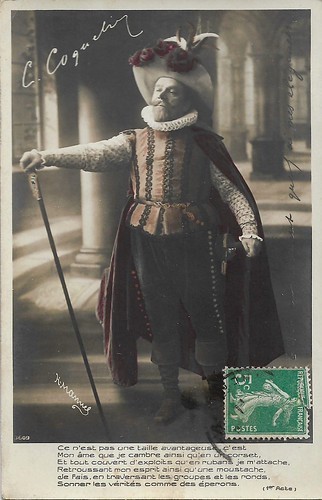
French postcard by Croissant, Paris, no. 3609. Photo: Henri Manuel, Paris. Constant Coquelin in the play 'Cyrano de Bergerac'.
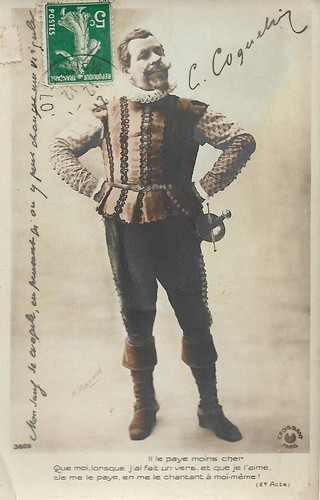
French postcard by Croissant, Paris, no. 3609. Photo: Henri Manuel, Paris. Constant Coquelin in the play 'Cyrano de Bergerac'.
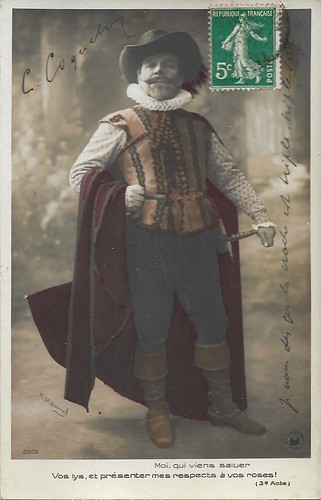
French postcard by Croissant, Paris, no. 3509. Photo: Henri Manuel, Paris. Constant Coquelin in the play 'Cyrano de Bergerac'.
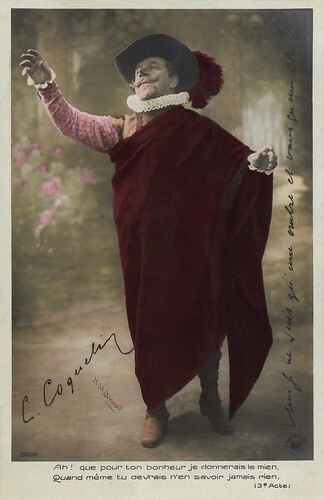
French postcard by Croissant, Paris, no. 3609. Photo: Henri Manuel, Paris. Constant Coquelin in the play 'Cyrano de Bergerac'.
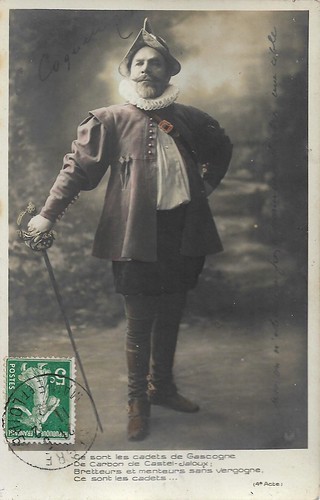
French postcard by Croissant, Paris, no. 3609. Photo: Henri Manuel, Paris. Constant Coquelin in the play 'Cyrano de Bergerac'.
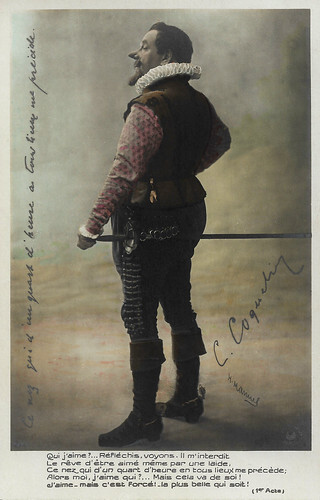
French postcard by Croissant, no. 3609. Photo: Henri Manuel, Paris. Constant Coquelin in the play 'Cyrano de Bergerac'.
His only film
In 1892 Benoît-Constant Coquelin broke definitively with the Comédie-Française and toured for some time through the capitals of Europe with a company of his own. In New York, he performed at Abbey's Theatre in 1894, playing the lead in 'Tartuffe (his son Jean played Orgon) and Mascarille in 'Les Précieuses ridicules'. In 1895 he joined the Renaissance theatre in Paris and played there until he became director of the Théâtre de la Porte Saint-Martin in 1897.
The only film of Benoît-Constant Coquelin was an early sound film shot by Lumiere brothers operator Felix Mesguich in 1900, though others state Clement Maurice as the responsible. It was a scene from Edmond Rostand's 'Cyrano de Bergerac's duel scene, the role Coquelin Sr. had created in 1897.
The film contained sound recording on a phonograph cylinder. The film is thought to be the first ever made with both colour and sound. It was shown at the Phono-Cinema Theatre in Paris during the famous 1900 Exposition. After the exposition closed, Mesguich took the films on a three-month tour all over Europe.
Coquelin was rehearsing for the creation of the title role in Edmond Rostand's 'Chantecler', which he was to produce when he died suddenly in Paris in 1909. The New York Times printed an obituary, in which it described many tributes to the dead actor, including a visit by the personal secretary of the President of the Republic, Armand Fallières. His brother, Ernest, and his son, Jean, were also actors.
Benoît-Constant Coquelin was an Officier de l'Instruction Publique and of the Legion of Honour. In 1930 his only film was found back, together with early sound films; in 1952 it was inserted in the film Cinema Parlant 1900.
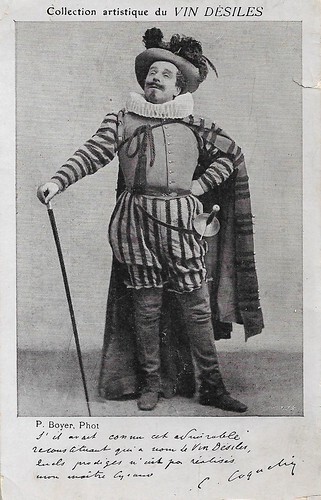
Vintage French postcard. Series Collection Artistique du Vin Désiles. S.I.P. Photo by Paul Boyer. Caption: S'il avait connu cet admirable reconstituant qui a nom de Vin Désiles, quels prodiges n'ait pas réalisés mon maître Cyrano.
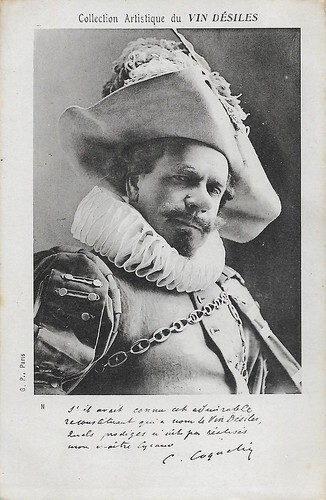
Vintage French postcard. Series Collection Artistique du Vin Désiles. S.I.P. Photo by G.P., Paris. Caption: S'il avait connu cet admirable reconstituant qui a nom de Vin Désiles, quels prodiges n'ait pas réalisés mon maître Cyrano.
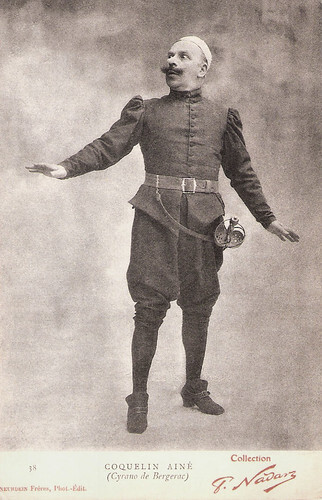
French postcard by Neurdein Frères Photo-Edit, no. 38. Photo: P. Nadar. Caption: Coquelin Ainé (Cyrano de Bergerac).
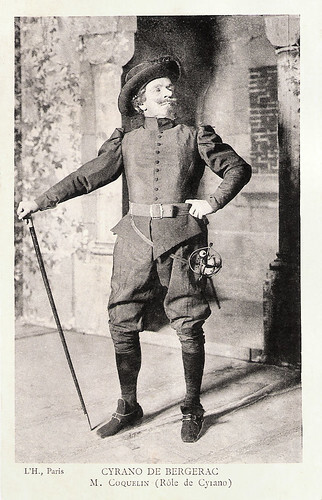
French postcard by L'H, Paris. M. Coquelin Ainé in the role of Cyrano in 'Cyrano de Bergerac'.
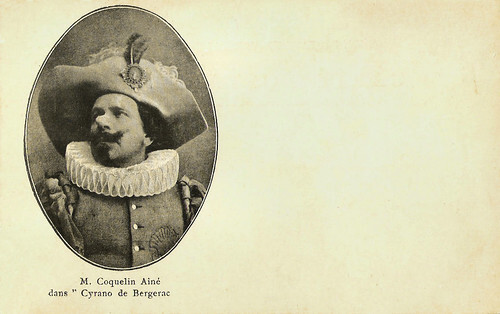
French postcard. Caption: M. Coquelin Ainé dans "Cyrano de Bergerac".
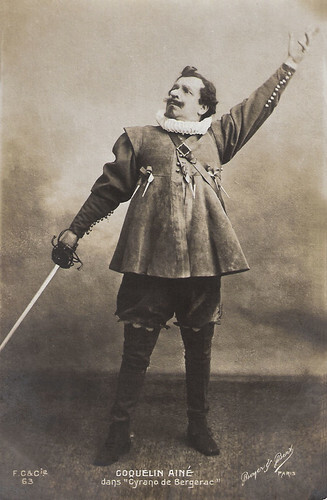
French postcard by F.C. & Cie., no. 63. Photo: Boyer & Bert, Paris Caption: Coquelin Ainé dans "Cyrano de Bergerac".
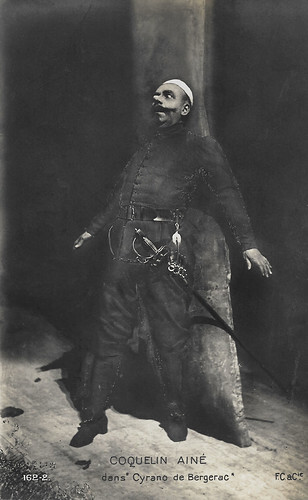
French postcard by F.C. & Cie., no. 162-2. Coquelin Ainé in 'Cyrano de Bergerac'.
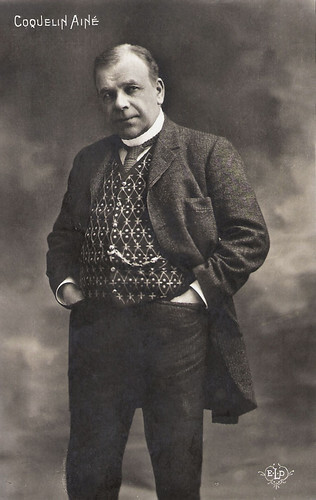
French postcard by ELD.
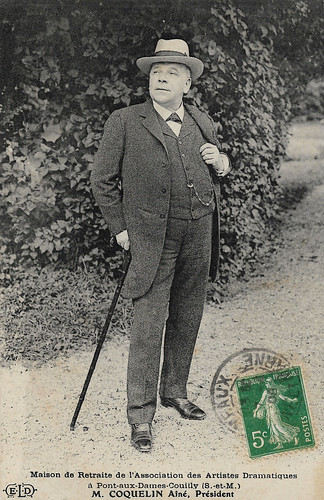
French postcard by ELD. Retirement home of the Association des Artistes Dramatiques in Pont-aux-Dames-Couilly (S.- and M.) M. Coquelin Ainé, Président. Coquelin founded the instution in 1903. In 1902, he said about his idea: "I want to see my old white-haired comedians, grouped together in a flowery asylum, like bees in a hive, with the difference that the bees are working and they won't be doing anything. I want to see them, without a hint of melancholy, in their sunny house, chatting about their former successes, under the green boughs of their shady park. And I even want them to continue acting, as a hobby, to distract themselves, these theatre veterans. I want them to have a naïve, charming little theatre where, from time to time, they will give a performance and the few profits they make will help to meet their meagre needs.".
Sources: Comedie Francaise and Wikipedia (French and English).

French postcard by Neurdein Frères, Paris, no. 42. Photo: P. Nadar. Constant Coquelin as Cyrano de Bergerac. Sent by mail in 1903.

French postcard by Neurdein Frères Photo-Edit, no. 37. Photo: P. Nadar. Caption: Coquelin Ainé (Cyrano de Bergerac).

French postcard by F.C. & Cie., no. 86. Photo: Paul Boyer, Paris. Caption: Coquelin Ainé in the play 'La Montespan'.

French postcard by ELD. Coquelin with unidentified actress, probably in a Molière play.

French postcard, no B140. Photo: AL. Caption: Coquelin Ainé.

French postcard by Croissant, Paris, no. 3609. Photo: Henri Manuel. Caption: M. Constant Coquelin.
A triumph with 'Cyrano de Bergerac'
Benoît-Constant Coquelin was born in Boulogne-sur-Mer, Pas-de-Calais in 1841. He originally intended to follow his father's trade of baking (he was once called "un boulanger manqué" – "a failed baker" – by a hostile critic), but his love of acting led him to the Conservatoire, where he entered Régnier's class in 1859. He won the first prize for comedy within a year.
Coquelin entered the Comédie-Française in 1860. He made his début on 7 December 1860 as the comic valet, Gros-René, in Molière's 'Le Dépit amoureux', but his first great success was as Figaro in 'The Barber of Seville', in 1861. It was an honour for Coquelin to be a part of the Comédie-Française at such a young age. This company had already been in existence for around 150 years.
He became Sociétaire at the Comédie-Française in 1864. The sociétaires co-manage, choose plays, and share profits. He left in 1887 to go on European and American tours and returned as Pensionnaire between 1890 and 1892. Despite the strict rules of the Comédie not playing afterwards on other stages, Coquelin had a triumph in 1897 with Edmond Rostand's 'Cyrano de Bergerac' and would play it many times.
In 1900, when he was almost sixty, Coquelin toured in America with Sarah Bernhardt and appeared on Broadway's Garden Theatre in a production of 'Cyrano de Bergerac' (Bernhardt played Roxane). On their return to France, he continued with his old colleague to appear in 'L'Aiglon', at the Théâtre Sarah Bernhardt.
For his booming voice and his lyrical and fiery temperament, Rostand wrote 'Chantecler', but the actor died in 1909 before it could be performed by him.

French postcard by Croissant, Paris, no. 3609. Photo: Henri Manuel, Paris. Constant Coquelin in the play 'Cyrano de Bergerac'.

French postcard by Croissant, Paris, no. 3609. Photo: Henri Manuel, Paris. Constant Coquelin in the play 'Cyrano de Bergerac'.

French postcard by Croissant, Paris, no. 3509. Photo: Henri Manuel, Paris. Constant Coquelin in the play 'Cyrano de Bergerac'.

French postcard by Croissant, Paris, no. 3609. Photo: Henri Manuel, Paris. Constant Coquelin in the play 'Cyrano de Bergerac'.

French postcard by Croissant, Paris, no. 3609. Photo: Henri Manuel, Paris. Constant Coquelin in the play 'Cyrano de Bergerac'.

French postcard by Croissant, no. 3609. Photo: Henri Manuel, Paris. Constant Coquelin in the play 'Cyrano de Bergerac'.
His only film
In 1892 Benoît-Constant Coquelin broke definitively with the Comédie-Française and toured for some time through the capitals of Europe with a company of his own. In New York, he performed at Abbey's Theatre in 1894, playing the lead in 'Tartuffe (his son Jean played Orgon) and Mascarille in 'Les Précieuses ridicules'. In 1895 he joined the Renaissance theatre in Paris and played there until he became director of the Théâtre de la Porte Saint-Martin in 1897.
The only film of Benoît-Constant Coquelin was an early sound film shot by Lumiere brothers operator Felix Mesguich in 1900, though others state Clement Maurice as the responsible. It was a scene from Edmond Rostand's 'Cyrano de Bergerac's duel scene, the role Coquelin Sr. had created in 1897.
The film contained sound recording on a phonograph cylinder. The film is thought to be the first ever made with both colour and sound. It was shown at the Phono-Cinema Theatre in Paris during the famous 1900 Exposition. After the exposition closed, Mesguich took the films on a three-month tour all over Europe.
Coquelin was rehearsing for the creation of the title role in Edmond Rostand's 'Chantecler', which he was to produce when he died suddenly in Paris in 1909. The New York Times printed an obituary, in which it described many tributes to the dead actor, including a visit by the personal secretary of the President of the Republic, Armand Fallières. His brother, Ernest, and his son, Jean, were also actors.
Benoît-Constant Coquelin was an Officier de l'Instruction Publique and of the Legion of Honour. In 1930 his only film was found back, together with early sound films; in 1952 it was inserted in the film Cinema Parlant 1900.

Vintage French postcard. Series Collection Artistique du Vin Désiles. S.I.P. Photo by Paul Boyer. Caption: S'il avait connu cet admirable reconstituant qui a nom de Vin Désiles, quels prodiges n'ait pas réalisés mon maître Cyrano.

Vintage French postcard. Series Collection Artistique du Vin Désiles. S.I.P. Photo by G.P., Paris. Caption: S'il avait connu cet admirable reconstituant qui a nom de Vin Désiles, quels prodiges n'ait pas réalisés mon maître Cyrano.

French postcard by Neurdein Frères Photo-Edit, no. 38. Photo: P. Nadar. Caption: Coquelin Ainé (Cyrano de Bergerac).

French postcard by L'H, Paris. M. Coquelin Ainé in the role of Cyrano in 'Cyrano de Bergerac'.

French postcard. Caption: M. Coquelin Ainé dans "Cyrano de Bergerac".

French postcard by F.C. & Cie., no. 63. Photo: Boyer & Bert, Paris Caption: Coquelin Ainé dans "Cyrano de Bergerac".

French postcard by F.C. & Cie., no. 162-2. Coquelin Ainé in 'Cyrano de Bergerac'.

French postcard by ELD.

French postcard by ELD. Retirement home of the Association des Artistes Dramatiques in Pont-aux-Dames-Couilly (S.- and M.) M. Coquelin Ainé, Président. Coquelin founded the instution in 1903. In 1902, he said about his idea: "I want to see my old white-haired comedians, grouped together in a flowery asylum, like bees in a hive, with the difference that the bees are working and they won't be doing anything. I want to see them, without a hint of melancholy, in their sunny house, chatting about their former successes, under the green boughs of their shady park. And I even want them to continue acting, as a hobby, to distract themselves, these theatre veterans. I want them to have a naïve, charming little theatre where, from time to time, they will give a performance and the few profits they make will help to meet their meagre needs.".
Sources: Comedie Francaise and Wikipedia (French and English).
Published on September 16, 2023 22:00
September 15, 2023
Eagle-Lion Films
Eagle-Lion Films was the name of two distinct, though related, British-American film companies. Eagle-Lion Films was a film production company founded by American railway magnate Robert R. Young and UK film magnate J. Arthur Rank. In 1947, Eagle-Lion Films acquired Producers Releasing Corporation (PRC) studio, a small American company, and became one of the most highly regarded producers of B films of Poverty Row. In 1944, J. Arthur Rank also created an American distribution company to handle his British films under the name Eagle-Lion Distributors Limited in the United Kingdom and Eagle-Lion Films Inc. in the United States. Some of the producers working at Eagle-Lion included Aubrey Schenck, Jack Schwarz and briefly, Walter Wanger and George Pal. Directors included Anthony Mann. Cinematographer John Alton also worked on its productions.
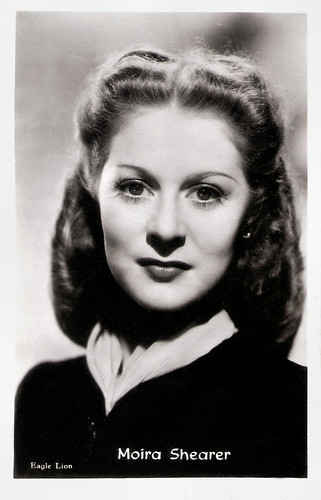
Belgian postcard. Photo: Eagle Lion.
Red-headed Moira Shearer (1926-2006) was a luminous star of British ballet. She became an international film idol with her unforgettable debut as the young ballerina Vicky in The Red Shoes (1948), a classic of British cinema and probably the most popular film about ballet ever.
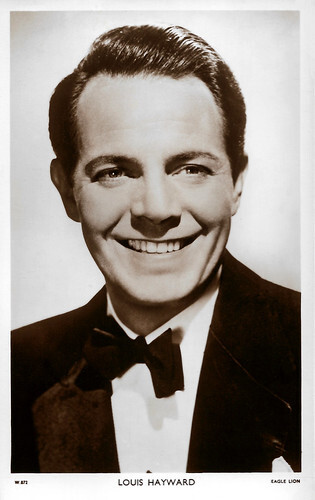
British postcard in the Picturegoer Series, London, no. W. 872. Photo: Eagle Lion.
British-American actor Louis Hayward (1909-1985) was a protégé of Noël Coward and began his career in London in such plays as 'Dracula' and in British films. After appearing on Broadway, he had a long career in Hollywood. Hayward was the first screen incarnation of Simon Templar in Leslie Charteris' The Saint in New York (1938) and had a dual role in The Man in the Iron Mask (1939) under the direction of James Whale. His debonair charm and athletic good looks made him one of Hollywood’s most successful swashbuckling heroes of the 1930s and 1940s.
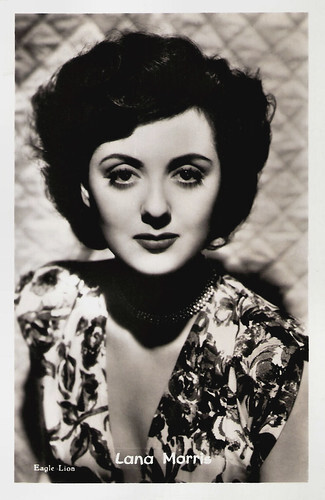
Dutch card. Photo: Eagle Lion.
Lana Morris (1930-1998) was a stylish and gifted British actress who appeared in films during the late 1940s and 1950s and continued her career on stage and television. She is best known for her two comedies with Norman Wisdom, Trouble in Store (1953) and Man of the Moment (1955).
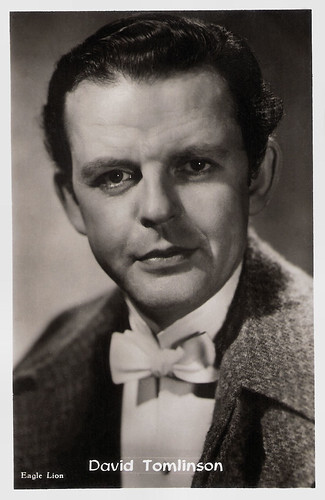
Dutch autograph card. Photo: Eagle Lion.
British actor David Tomlinson (1917-2000) was both a leading man, a character actor and a comedian. He is best remembered for his roles in the Walt Disney successes Mary Poppins (1964) as authority figure George Banks, The Love Bug (1968) as hapless antagonist Peter Thorndyke, and Bedknobs and Broomsticks (1971) as fraudulent magician Professor Emelius Browne.
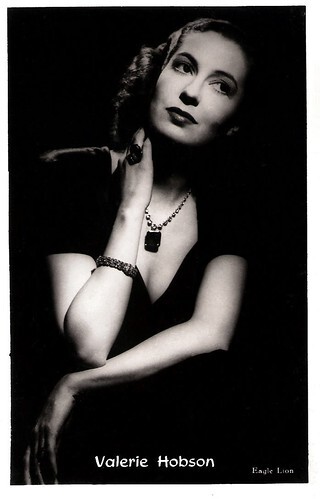
British postcard. Photo: Eagle Lion.
Elegant, redheaded Valerie Hobson (1917-1998) was a great beauty who became an impressive actress. The British actress landed some very choice roles in the later 1940s and was at her best in those films in which she could exercise her comedy talent.
Poverty Row
Pathé Industries' Eagle-Lion Films subsidiary was founded in December 1945. American railway magnate Robert R. Young already owned PRC Pictures, a studio on Hollywood's so-called 'Poverty Row', the companies that mainly made B-movies. Young made a deal with J. Arthur Rank which led to the creation of the distribution company Eagle-Lion Films and the studio Eagle-Lion Studios. From 1946 to 1949, Eagle-Lion was led by Arthur B. Krim. In addition to releasing films by Rank and reissues of David O. Selznick films, it produced its own B-movies. Bryan Foy the former head of the B-picture unit at Warner Bros., was in charge of production.
The initial arrangement was that Rank and Eagle-Lion would each produce five films a year. Costs were initially kept to less than $500,000 per film. Their first year of films was financed with $8 million in loans from the Bank of America which Young personally guaranteed. The company recorded a loss of $2.2 million in 1947. Krim later attributed this to them paying too much money for stars who were scarcely good enough to prevent insufficient box-office returns.
This encouraged Eagle-Lion to change its mode of production, using more independent producers as a source for new films. Bryan Foy resigned as head of production to become an independent producer for the company and Arthur Krim became studio chief. Eagle-Lion would help finance the films and offer facilities, although producers would find their own money too.
Along with Foy, other independent producers who worked for Eagle-Lion included Edward Small, Walter Wanger and George Pal. They began making lower-budgeted films, enjoying particular success with Film Noir. Eagle-Lion had acquired the film studio of Producers Releasing Corporation (PRC), which had acquired the building from the no-longer extant Grand National Pictures. PRC was dissolved in August 1947 and its product was shifted to Eagle-Lion.
By 1947–1948, the studio had completed 14 productions. By the spring of 1949, ten were in release, five of which earned a substantial profit – T-Men, Raw Deal, Canon City, He Walked By Night and The Noose Hangs High. Two others broke even and two others showed losses. If the company had completely financed these films it would have made $1.2 million but as it was it made $200,000. However, because of its unsuccessful first year, the company still owed money and closed its studio in November 1948.
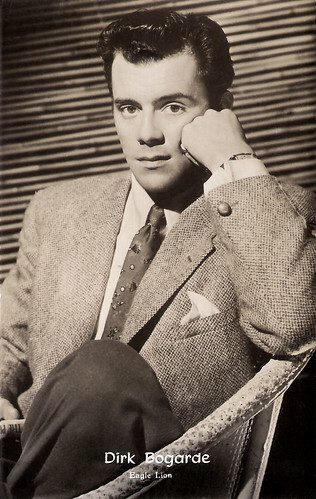
British card. Photo: Eagle Lion.
Distinguished British actor and novelist Sir Dirk Bogarde (1921-1999) was Britain's number one box office draw of the 1950s, gaining the title of ‘The Matinee Idol of the Odeon’. In the 1960s, he abandoned his heart-throb image for more challenging parts in films by Joseph Losey, John Schlesinger, Luchino Visconti, Liliane Cavani and Rainer Werner Fassbinder. Bogarde made a total of 63 films between 1939 and 1991.
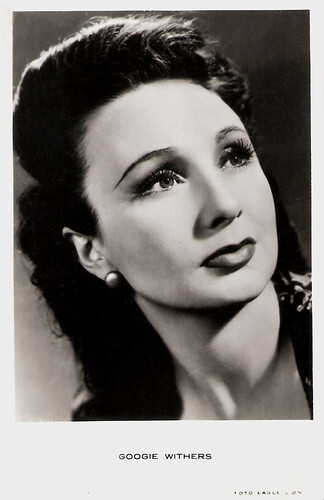
Dutch postcard by Hemo. Photo: Eagle Lion.
British entertainer Georgette 'Googie' Withers (1917-2011) had a long career in theatre, film, and television. She was a well-known actress during the war and post-war years. During the 1930s, Withers was constantly in demand for lead roles in minor films and supporting roles in more prestigious productions. Her best-known work of the period was as one of Margaret Lockwood's friends in Alfred Hitchcock's The Lady Vanishes (1938). Among her successes of the 1940s, and a departure from her previous roles, was the Powell and Pressburger film One of Our Aircraft Is Missing (1942), a topical World War II drama in which she played a Dutch resistance fighter who helps British airmen return to safety from behind enemy lines. In 1948 British exhibitors voted her the 8th most popular British star in the country. She is also remembered for her role as the devious Helen Nosseross in the classic Film Noir Night and the City (1950). Googie Withers was a longtime resident of Australia with her husband, the actor John McCallum, with whom she often appeared.
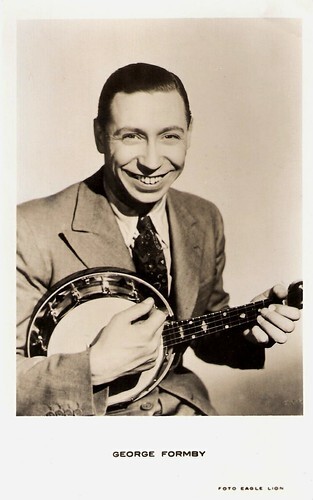
Dutch postcard by Hemo. Photo: Eagle Lion.
George Formby (1904–1961) was Britain's most popular film comedian between 1934 and 1945 and one of the highest-paid stars. He appeared in 21 hit films, cut over 230 records, and entertained an estimated three million Allied Servicemen during World War II. His trademark was the ukulele - along with his buck-toothed grin.
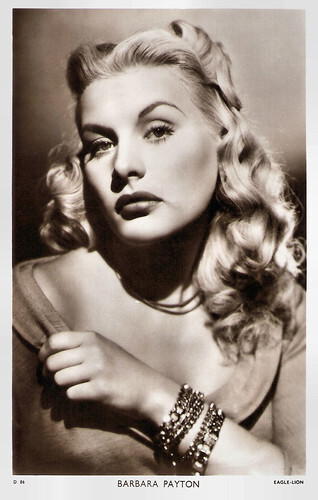
British postcard in the Picturegoer Series, London, no. D 86. Photo: Eagle-Lion.
American film actress Barbara Payton (1927-1967) was a blue-eyed, peroxide-blonde sexpot, less known for her films than for her stormy social life and eventual battles with alcohol and drug addiction. Her tale is one of the saddest ever to come out of Hollywood.
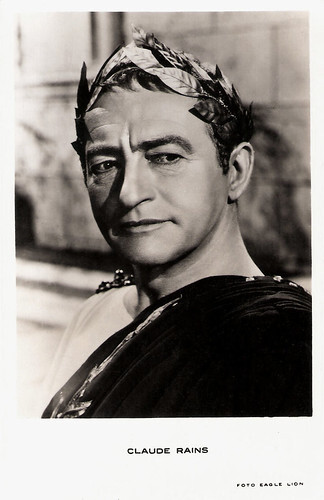
Dutch postcard by HEMO. Photo: Eagle Lion. Publicity still for Caesar and Cleopatra (1945).
The career of English stage and film actor Claude Rains (1889-1967) spanned 47 years. In Hollywood, he was a supporting actor who achieved A-list stardom. With his smooth distinguished voice, he could portray a wide variety of roles, ranging from villains to sympathetic gentlemen. He is best known as the title figure in The Invisible Man (1933), as wicked Prince John in The Adventures of Robin Hood (1938), as a corrupt senator in Mr. Smith Goes to Washington (1939), and, of course, as Captain Renault in Casablanca (1942).
Unsuccessful at the American box office
Eagle-Lion released a series of British films, most of which were unsuccessful at the American box office. There were some exceptions, such as the drama The Red Shoes (Michael Powell, Emeric Pressburger, 1948). It marked the feature film debut of Moira Shearer , an established ballerina, and also features Robert Helpmann , Léonide Massine, and Ludmilla Tchérina , other renowned dancers from the ballet world. The film earned rentals of $5 million and was their only release which was nominated for the Academy Award for Best Picture.
Another success was T-Men (Anthony Mann, 1947), a semidocumentary and police procedural-style Film Noir about United States Treasury agents. The film was shot by noted Noir cameraman John Alton and features Dennis O'Keefe. The company suffered increasing financial difficulties throughout 1949. Arthur Krim resigned in May and the company ceased production at the end of the year. Eagle-Lion merged with Film Classics in 1950 to become Eagle-Lion Classics.
Another interesting film was the American police procedural Film Noir He Walked by Night (Alfred L. Werker, Anthony Mann, 1948), shot in a semidocumentary tone. It was loosely based on the real-life actions of Erwin "Machine-Gun" Walker, played by Richard Basehart , a former Glendale, California police department employee and World War II veteran who unleashed a crime spree of burglaries, robberies and shootouts in the Los Angeles area in 1945 and 1946. Assistant director Reggie Callow felt that the studio would have survived longer had they kept producing this kind of low-budget films rather than attempting to compete with the major studios by making higher-budgeted films.
When PRC shut down in 1948, its distribution exchanges were assumed by Eagle-Lion Films. In 1950, Pathé merged Eagle-Lion with an independent reissue distributor, Film Classics, to create Eagle-Lion Classics. The latter was acquired by and merged into United Artists a year later. Rank also released films in the United Kingdom through Eagle-Lion Distributors Limited.
In 1951, Arthur Krim was offered the leadership of United Artists. In April of that year, UA took over the distribution of Eagle-Lion's current releases. Eagle-Lion terminated the release pact with Rank and ceased distributing films. Their studios were sold. In 1954, Frederick Ziv bought Eagle-Lion for the production of his syndicated Ziv television programme. Its relatively small studio was located at 7950 Santa Monica Boulevard, Hollywood, and has since been demolished.
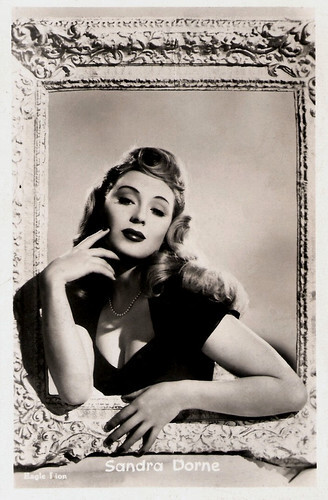
Dutch postcard. Photo: Eagle Lion.
British actress Sandra Dorne (1924-1992) was a sexy and glamorous bombshell. She was a popular pin-up early in her career, played leads in the 1950s and later appeared in supporting roles.
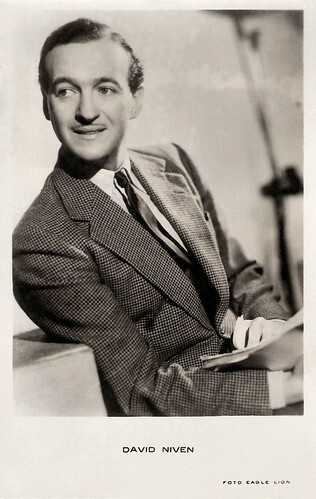
Dutch postcard by HEMO. Photo: Eagle Lion.
British Academy Award-winning actor David Niven (1910-1983) impersonated the archetypal English gentleman, witty, naturally charming, and immaculate in dress and behaviour, but he also had a dash of light-hearted sexual roguishness. He is probably best known for his role as the punctuality-obsessed adventurer Phileas Fogg in Around the World in 80 Days (1956).
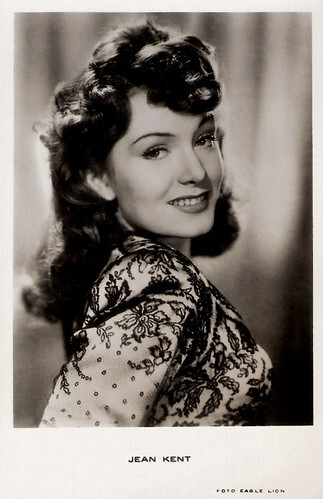
Dutch postcard by Hemo. Photo: Eagle Lion.
Jean Kent (1921-2013) was a strawberry-blonde British actress who played spiteful hussies or femmes fatales in British films of the 1940s and 1950s.
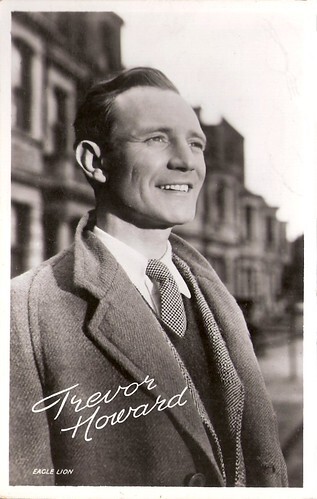
Dutch postcard. Photo: Eagle Lion.
English film, stage and television actor Trevor Howard (1913-1988) is best known as the doctor in the classic romantic drama Brief Encounter (David Lean, 1945), in which his co-star was Celia Johnson. In the 1940s and 1950s, he often played the slightly dry, slightly crusty but capable British military officer, and in the 1960s he became one of England's finest character actors.
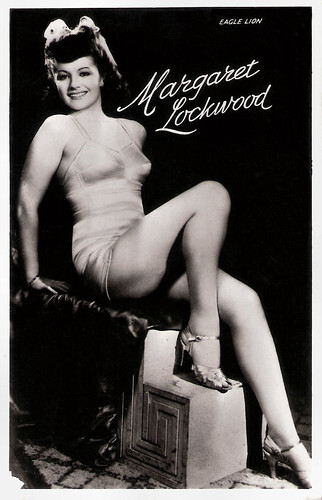
Dutch postcard by Uitgeverij Takken, Utrecht, no. 3239. Photo: Eagle Lion.
Beautiful stage and film actress Margaret Lockwood (1916-1990) was the female lead of the early Hitchcock classic The Lady Vanishes (1938). In the 1940s she became Britain's leading box-office star specialising in beautiful but diabolical adventuresses.
Sources: Wikipedia (English and Swedish) and IMDb.

Belgian postcard. Photo: Eagle Lion.
Red-headed Moira Shearer (1926-2006) was a luminous star of British ballet. She became an international film idol with her unforgettable debut as the young ballerina Vicky in The Red Shoes (1948), a classic of British cinema and probably the most popular film about ballet ever.

British postcard in the Picturegoer Series, London, no. W. 872. Photo: Eagle Lion.
British-American actor Louis Hayward (1909-1985) was a protégé of Noël Coward and began his career in London in such plays as 'Dracula' and in British films. After appearing on Broadway, he had a long career in Hollywood. Hayward was the first screen incarnation of Simon Templar in Leslie Charteris' The Saint in New York (1938) and had a dual role in The Man in the Iron Mask (1939) under the direction of James Whale. His debonair charm and athletic good looks made him one of Hollywood’s most successful swashbuckling heroes of the 1930s and 1940s.

Dutch card. Photo: Eagle Lion.
Lana Morris (1930-1998) was a stylish and gifted British actress who appeared in films during the late 1940s and 1950s and continued her career on stage and television. She is best known for her two comedies with Norman Wisdom, Trouble in Store (1953) and Man of the Moment (1955).

Dutch autograph card. Photo: Eagle Lion.
British actor David Tomlinson (1917-2000) was both a leading man, a character actor and a comedian. He is best remembered for his roles in the Walt Disney successes Mary Poppins (1964) as authority figure George Banks, The Love Bug (1968) as hapless antagonist Peter Thorndyke, and Bedknobs and Broomsticks (1971) as fraudulent magician Professor Emelius Browne.

British postcard. Photo: Eagle Lion.
Elegant, redheaded Valerie Hobson (1917-1998) was a great beauty who became an impressive actress. The British actress landed some very choice roles in the later 1940s and was at her best in those films in which she could exercise her comedy talent.
Poverty Row
Pathé Industries' Eagle-Lion Films subsidiary was founded in December 1945. American railway magnate Robert R. Young already owned PRC Pictures, a studio on Hollywood's so-called 'Poverty Row', the companies that mainly made B-movies. Young made a deal with J. Arthur Rank which led to the creation of the distribution company Eagle-Lion Films and the studio Eagle-Lion Studios. From 1946 to 1949, Eagle-Lion was led by Arthur B. Krim. In addition to releasing films by Rank and reissues of David O. Selznick films, it produced its own B-movies. Bryan Foy the former head of the B-picture unit at Warner Bros., was in charge of production.
The initial arrangement was that Rank and Eagle-Lion would each produce five films a year. Costs were initially kept to less than $500,000 per film. Their first year of films was financed with $8 million in loans from the Bank of America which Young personally guaranteed. The company recorded a loss of $2.2 million in 1947. Krim later attributed this to them paying too much money for stars who were scarcely good enough to prevent insufficient box-office returns.
This encouraged Eagle-Lion to change its mode of production, using more independent producers as a source for new films. Bryan Foy resigned as head of production to become an independent producer for the company and Arthur Krim became studio chief. Eagle-Lion would help finance the films and offer facilities, although producers would find their own money too.
Along with Foy, other independent producers who worked for Eagle-Lion included Edward Small, Walter Wanger and George Pal. They began making lower-budgeted films, enjoying particular success with Film Noir. Eagle-Lion had acquired the film studio of Producers Releasing Corporation (PRC), which had acquired the building from the no-longer extant Grand National Pictures. PRC was dissolved in August 1947 and its product was shifted to Eagle-Lion.
By 1947–1948, the studio had completed 14 productions. By the spring of 1949, ten were in release, five of which earned a substantial profit – T-Men, Raw Deal, Canon City, He Walked By Night and The Noose Hangs High. Two others broke even and two others showed losses. If the company had completely financed these films it would have made $1.2 million but as it was it made $200,000. However, because of its unsuccessful first year, the company still owed money and closed its studio in November 1948.

British card. Photo: Eagle Lion.
Distinguished British actor and novelist Sir Dirk Bogarde (1921-1999) was Britain's number one box office draw of the 1950s, gaining the title of ‘The Matinee Idol of the Odeon’. In the 1960s, he abandoned his heart-throb image for more challenging parts in films by Joseph Losey, John Schlesinger, Luchino Visconti, Liliane Cavani and Rainer Werner Fassbinder. Bogarde made a total of 63 films between 1939 and 1991.

Dutch postcard by Hemo. Photo: Eagle Lion.
British entertainer Georgette 'Googie' Withers (1917-2011) had a long career in theatre, film, and television. She was a well-known actress during the war and post-war years. During the 1930s, Withers was constantly in demand for lead roles in minor films and supporting roles in more prestigious productions. Her best-known work of the period was as one of Margaret Lockwood's friends in Alfred Hitchcock's The Lady Vanishes (1938). Among her successes of the 1940s, and a departure from her previous roles, was the Powell and Pressburger film One of Our Aircraft Is Missing (1942), a topical World War II drama in which she played a Dutch resistance fighter who helps British airmen return to safety from behind enemy lines. In 1948 British exhibitors voted her the 8th most popular British star in the country. She is also remembered for her role as the devious Helen Nosseross in the classic Film Noir Night and the City (1950). Googie Withers was a longtime resident of Australia with her husband, the actor John McCallum, with whom she often appeared.

Dutch postcard by Hemo. Photo: Eagle Lion.
George Formby (1904–1961) was Britain's most popular film comedian between 1934 and 1945 and one of the highest-paid stars. He appeared in 21 hit films, cut over 230 records, and entertained an estimated three million Allied Servicemen during World War II. His trademark was the ukulele - along with his buck-toothed grin.

British postcard in the Picturegoer Series, London, no. D 86. Photo: Eagle-Lion.
American film actress Barbara Payton (1927-1967) was a blue-eyed, peroxide-blonde sexpot, less known for her films than for her stormy social life and eventual battles with alcohol and drug addiction. Her tale is one of the saddest ever to come out of Hollywood.

Dutch postcard by HEMO. Photo: Eagle Lion. Publicity still for Caesar and Cleopatra (1945).
The career of English stage and film actor Claude Rains (1889-1967) spanned 47 years. In Hollywood, he was a supporting actor who achieved A-list stardom. With his smooth distinguished voice, he could portray a wide variety of roles, ranging from villains to sympathetic gentlemen. He is best known as the title figure in The Invisible Man (1933), as wicked Prince John in The Adventures of Robin Hood (1938), as a corrupt senator in Mr. Smith Goes to Washington (1939), and, of course, as Captain Renault in Casablanca (1942).
Unsuccessful at the American box office
Eagle-Lion released a series of British films, most of which were unsuccessful at the American box office. There were some exceptions, such as the drama The Red Shoes (Michael Powell, Emeric Pressburger, 1948). It marked the feature film debut of Moira Shearer , an established ballerina, and also features Robert Helpmann , Léonide Massine, and Ludmilla Tchérina , other renowned dancers from the ballet world. The film earned rentals of $5 million and was their only release which was nominated for the Academy Award for Best Picture.
Another success was T-Men (Anthony Mann, 1947), a semidocumentary and police procedural-style Film Noir about United States Treasury agents. The film was shot by noted Noir cameraman John Alton and features Dennis O'Keefe. The company suffered increasing financial difficulties throughout 1949. Arthur Krim resigned in May and the company ceased production at the end of the year. Eagle-Lion merged with Film Classics in 1950 to become Eagle-Lion Classics.
Another interesting film was the American police procedural Film Noir He Walked by Night (Alfred L. Werker, Anthony Mann, 1948), shot in a semidocumentary tone. It was loosely based on the real-life actions of Erwin "Machine-Gun" Walker, played by Richard Basehart , a former Glendale, California police department employee and World War II veteran who unleashed a crime spree of burglaries, robberies and shootouts in the Los Angeles area in 1945 and 1946. Assistant director Reggie Callow felt that the studio would have survived longer had they kept producing this kind of low-budget films rather than attempting to compete with the major studios by making higher-budgeted films.
When PRC shut down in 1948, its distribution exchanges were assumed by Eagle-Lion Films. In 1950, Pathé merged Eagle-Lion with an independent reissue distributor, Film Classics, to create Eagle-Lion Classics. The latter was acquired by and merged into United Artists a year later. Rank also released films in the United Kingdom through Eagle-Lion Distributors Limited.
In 1951, Arthur Krim was offered the leadership of United Artists. In April of that year, UA took over the distribution of Eagle-Lion's current releases. Eagle-Lion terminated the release pact with Rank and ceased distributing films. Their studios were sold. In 1954, Frederick Ziv bought Eagle-Lion for the production of his syndicated Ziv television programme. Its relatively small studio was located at 7950 Santa Monica Boulevard, Hollywood, and has since been demolished.

Dutch postcard. Photo: Eagle Lion.
British actress Sandra Dorne (1924-1992) was a sexy and glamorous bombshell. She was a popular pin-up early in her career, played leads in the 1950s and later appeared in supporting roles.

Dutch postcard by HEMO. Photo: Eagle Lion.
British Academy Award-winning actor David Niven (1910-1983) impersonated the archetypal English gentleman, witty, naturally charming, and immaculate in dress and behaviour, but he also had a dash of light-hearted sexual roguishness. He is probably best known for his role as the punctuality-obsessed adventurer Phileas Fogg in Around the World in 80 Days (1956).

Dutch postcard by Hemo. Photo: Eagle Lion.
Jean Kent (1921-2013) was a strawberry-blonde British actress who played spiteful hussies or femmes fatales in British films of the 1940s and 1950s.

Dutch postcard. Photo: Eagle Lion.
English film, stage and television actor Trevor Howard (1913-1988) is best known as the doctor in the classic romantic drama Brief Encounter (David Lean, 1945), in which his co-star was Celia Johnson. In the 1940s and 1950s, he often played the slightly dry, slightly crusty but capable British military officer, and in the 1960s he became one of England's finest character actors.

Dutch postcard by Uitgeverij Takken, Utrecht, no. 3239. Photo: Eagle Lion.
Beautiful stage and film actress Margaret Lockwood (1916-1990) was the female lead of the early Hitchcock classic The Lady Vanishes (1938). In the 1940s she became Britain's leading box-office star specialising in beautiful but diabolical adventuresses.
Sources: Wikipedia (English and Swedish) and IMDb.
Published on September 15, 2023 22:00
Neil Hamilton (1899-1984) was an American screen actor, w...
Neil Hamilton (1899-1984) was an American screen actor, who was a popular Hollywood actor in the 1920s and early 1930s. Later he had a fruitful career in television, in particular as Commissioner Gordon in the Batman TV series.
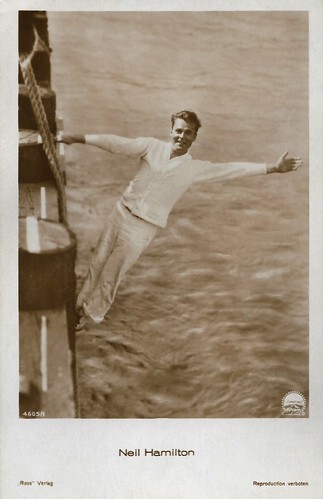
German postcard by Ross Verlag, no. 4605/1, 1929-1930. Photo: Paramount.
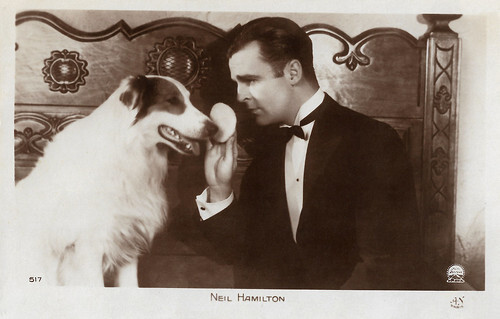
French postcard by A.N., Paris, no. 517. Photo: Paramount.
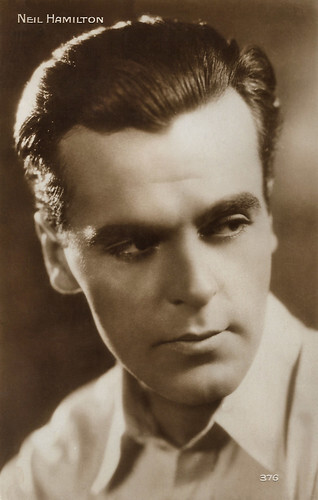
French postcard by Cinémagazine-Edition, no. 376.
Colleen Moore's boss
James Neil Hamilton was born in 1899 in Lynn Massachusetts.
Hamilton began his career as a model and came to acting through this. At first, he played in some repertory theatres and got his first film role in The Beloved Impostor (1918).
His breakthrough came in 1923 with The White Rose, directed by D. W. Griffith . He also starred the following year in Griffith's social drama Isn't Life Wonderful (D.W. Griffith, 1924), which was about the difficult living conditions in 1920s Germany and was also largely filmed in Germany and Austria.
Other appearances followed, for example as Nick Carraway opposite Warner Baxter and Lois Wilson in the first - now lost - film version of The Great Gatsby (Herbert Brenon, 1926), or opposite Victor McLaglen in John Ford's drama Mother Machree (1928) about an Irish immigrant family in America.
In the late 1920s, he signed a studio contract with Paramount Pictures, where he was one of the most popular leading actors, e.g. as Crown Prince Alexander in The Patriot (Ernst Lubitsch, 1928), starring Emil Jannings . Yet, he also acted at other companies such as First National/Warner, e.g. as Colleen Moore 's boss in the flapper comedy Why Be Good? (William A. Seiter, 1929).
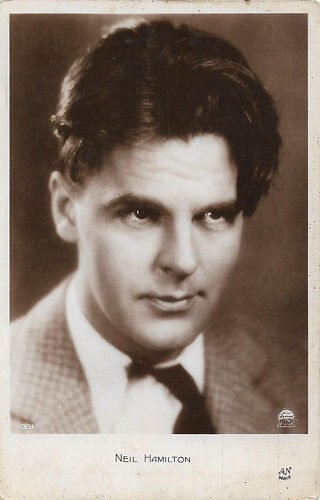
French postcard by A.N., Paris, no. 391. Photo: Paramount.
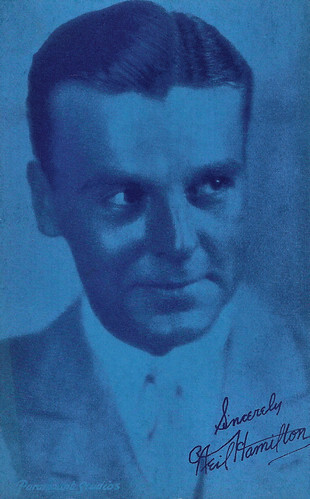
American Arcade card. Photo: Paramount.
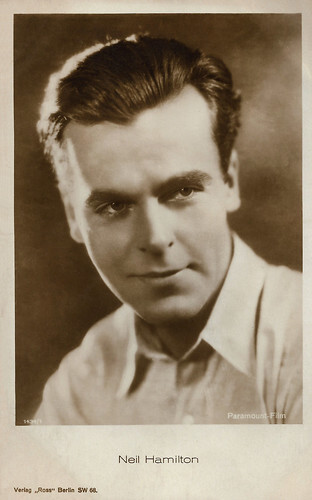
German postcard by Verlag Ross, Berlin, no. 1434/1, 1927-1928. Photo: Paramount-Film.
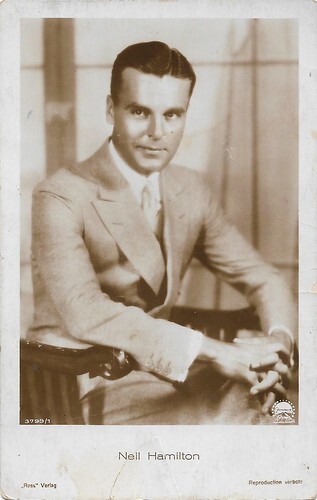
German postcard by Ross Verlag, no. 3799/1, 1928-1929. Photo: Paramount.
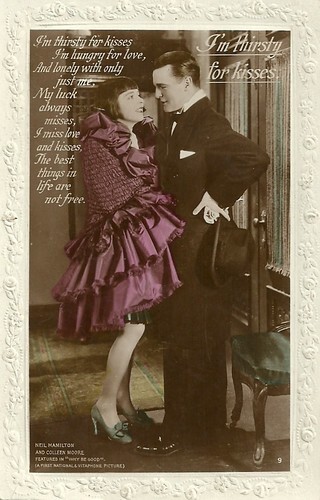
British postcard, no. 9. Photo: First National Pictures. Colleen Moore and Neil Hamilton in Why Be Good? (William A. Seiter, 1929).
Tarzan's antagonist
Neil Hamilton made the transition to talkies without any problems and continued his acting career until the early 1970s. He co-acted with Douglas Fairbanks Jr. and Richard Barthelmess in the Flying Aces war drama The Dawn Patrol (Howard Hawks, 1930), and twice he acted as Dr. Jack Petrie in two Fu Manchu films, The Mysterious Dr. Fu Manchu (Rowland V. Lee, 1929), and The Return of Dr. Fu Manchu (Rowland V. Lee, 1930), both starring Warner Oland.
He played the lover of such stars as Joan Crawford in Laughing Sinners (Harry Beaumont, 1931) or Constance Bennett in What Price Hollywood? (George Cukor, 1932).
In the first two Tarzan films with Johnny Weissmuller , Tarzan the Ape Man (W.S. Van Dyke, 1932) and Tarzan and His Mate (W.S. Van Dyke, 1934), he played his antagonist Harry Holt, who is killed at the end of the second film.
However, Neil Hamilton's success began to wane in the mid-1930s, he was given only a few leading roles and increasingly found himself in insignificant B-movies. In hindsight, Hamilton said this happened because he had insulted a studio executive. In 1936-1937 he went to the UK to make five films there. Yet, it was television that brought him new popularity, where he played numerous guest roles and also hosted the talent show Hollywood Screen Test between 1948 and 1953.
In the 1960s, Hamilton played the role of Commissioner James Gordon in the popular television series Batman (1966–1968), which brought him new notoriety. Hamilton appeared in all 120 episodes of the series as well as in the film version, Batman (Leslie H. Martinson, 1966). Neil Hamilton had his last role in a television film in 1971, after which he retired to private life. He was married to Elsa Cozetta Whitmer for over 62 years from 1922 until his death, they had one child. Neil Hamilton died of asthma in 1984 in Escondido, California at the age of 85. After his cremation, his ashes were later scattered into the Pacific Ocean.
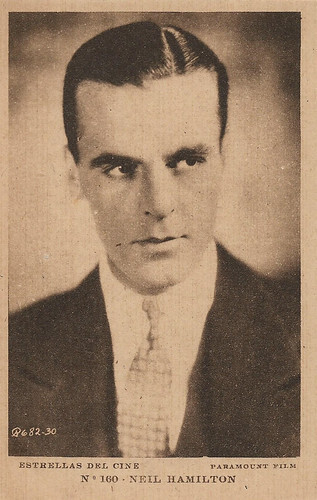
Spanish postcard by Editorial Grafica, Barcelona, in the Series Estrellas del cine, no. 160. Photo: Paramount.
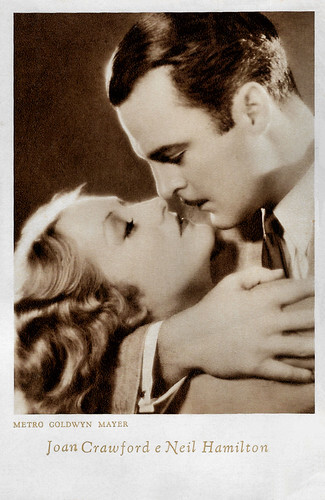
Italian postcard by Cinema-Illustrazione, Milano, series 2, no. 11. Photo: Metro-Goldwyn-Mayer. Joan Crawford and Neil Hamilton in Laughing Sinners (Harry Beaumont, 1931).
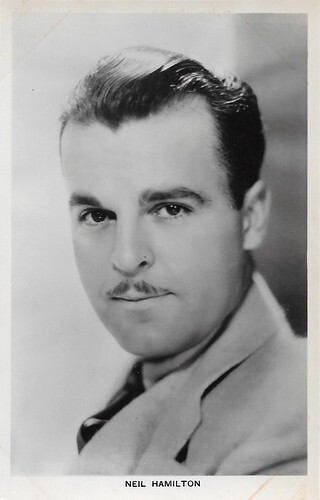
British postcard in the Picturegoer Series, London.
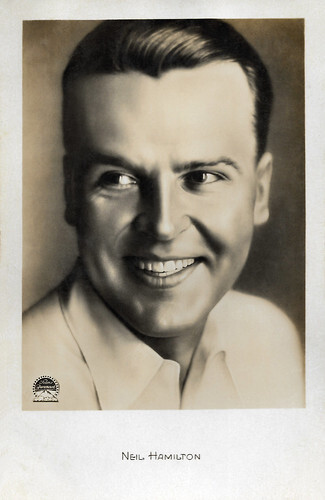
Vintage postcard. Photo: Paramount-Film.
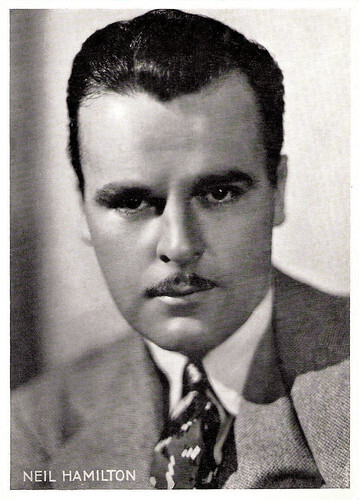
Vintage postcard.
Sources: Wikipedia (German and English), and .

German postcard by Ross Verlag, no. 4605/1, 1929-1930. Photo: Paramount.

French postcard by A.N., Paris, no. 517. Photo: Paramount.

French postcard by Cinémagazine-Edition, no. 376.
Colleen Moore's boss
James Neil Hamilton was born in 1899 in Lynn Massachusetts.
Hamilton began his career as a model and came to acting through this. At first, he played in some repertory theatres and got his first film role in The Beloved Impostor (1918).
His breakthrough came in 1923 with The White Rose, directed by D. W. Griffith . He also starred the following year in Griffith's social drama Isn't Life Wonderful (D.W. Griffith, 1924), which was about the difficult living conditions in 1920s Germany and was also largely filmed in Germany and Austria.
Other appearances followed, for example as Nick Carraway opposite Warner Baxter and Lois Wilson in the first - now lost - film version of The Great Gatsby (Herbert Brenon, 1926), or opposite Victor McLaglen in John Ford's drama Mother Machree (1928) about an Irish immigrant family in America.
In the late 1920s, he signed a studio contract with Paramount Pictures, where he was one of the most popular leading actors, e.g. as Crown Prince Alexander in The Patriot (Ernst Lubitsch, 1928), starring Emil Jannings . Yet, he also acted at other companies such as First National/Warner, e.g. as Colleen Moore 's boss in the flapper comedy Why Be Good? (William A. Seiter, 1929).

French postcard by A.N., Paris, no. 391. Photo: Paramount.

American Arcade card. Photo: Paramount.

German postcard by Verlag Ross, Berlin, no. 1434/1, 1927-1928. Photo: Paramount-Film.

German postcard by Ross Verlag, no. 3799/1, 1928-1929. Photo: Paramount.

British postcard, no. 9. Photo: First National Pictures. Colleen Moore and Neil Hamilton in Why Be Good? (William A. Seiter, 1929).
Tarzan's antagonist
Neil Hamilton made the transition to talkies without any problems and continued his acting career until the early 1970s. He co-acted with Douglas Fairbanks Jr. and Richard Barthelmess in the Flying Aces war drama The Dawn Patrol (Howard Hawks, 1930), and twice he acted as Dr. Jack Petrie in two Fu Manchu films, The Mysterious Dr. Fu Manchu (Rowland V. Lee, 1929), and The Return of Dr. Fu Manchu (Rowland V. Lee, 1930), both starring Warner Oland.
He played the lover of such stars as Joan Crawford in Laughing Sinners (Harry Beaumont, 1931) or Constance Bennett in What Price Hollywood? (George Cukor, 1932).
In the first two Tarzan films with Johnny Weissmuller , Tarzan the Ape Man (W.S. Van Dyke, 1932) and Tarzan and His Mate (W.S. Van Dyke, 1934), he played his antagonist Harry Holt, who is killed at the end of the second film.
However, Neil Hamilton's success began to wane in the mid-1930s, he was given only a few leading roles and increasingly found himself in insignificant B-movies. In hindsight, Hamilton said this happened because he had insulted a studio executive. In 1936-1937 he went to the UK to make five films there. Yet, it was television that brought him new popularity, where he played numerous guest roles and also hosted the talent show Hollywood Screen Test between 1948 and 1953.
In the 1960s, Hamilton played the role of Commissioner James Gordon in the popular television series Batman (1966–1968), which brought him new notoriety. Hamilton appeared in all 120 episodes of the series as well as in the film version, Batman (Leslie H. Martinson, 1966). Neil Hamilton had his last role in a television film in 1971, after which he retired to private life. He was married to Elsa Cozetta Whitmer for over 62 years from 1922 until his death, they had one child. Neil Hamilton died of asthma in 1984 in Escondido, California at the age of 85. After his cremation, his ashes were later scattered into the Pacific Ocean.

Spanish postcard by Editorial Grafica, Barcelona, in the Series Estrellas del cine, no. 160. Photo: Paramount.

Italian postcard by Cinema-Illustrazione, Milano, series 2, no. 11. Photo: Metro-Goldwyn-Mayer. Joan Crawford and Neil Hamilton in Laughing Sinners (Harry Beaumont, 1931).

British postcard in the Picturegoer Series, London.

Vintage postcard. Photo: Paramount-Film.

Vintage postcard.
Sources: Wikipedia (German and English), and .
Published on September 15, 2023 01:33
September 14, 2023
Sandra Bullock
German-American film star and producer Sandra Bullock (1964) is known for her charming, somewhat chaotic characters in popular action films such as Speed (1994) and the comedies While You Were Sleeping (1995) and Miss Congeniality (2000). These hit films made her one of Hollywood's highest-paid actresses. She won an Oscar for best actress, a Golden Globe and a Screen Actors Guild Award for her dramatic turn in The Blind Side (2009).
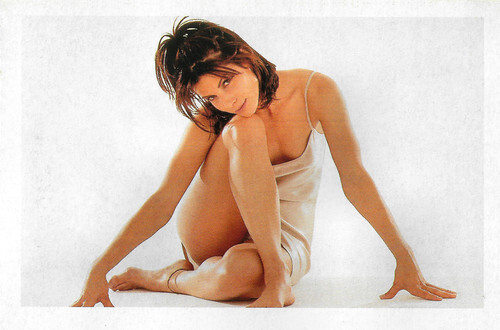
Belgian postcard in the 'De 50 mooiste vrouwen van de eeuw' (The 50 most beautiful women of the century) series by P-Magazine, no. 13. Photo: Kate Garner / Outline.
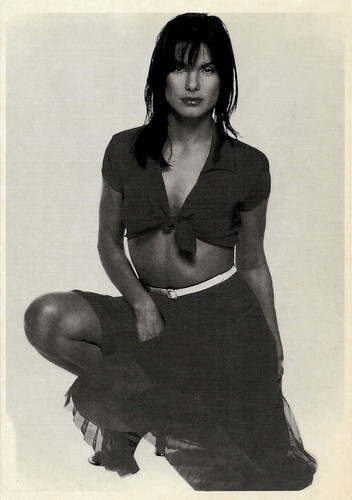
Canadian postcard By Canadian Postcard, no. A-370.
A bomb on board
Sandra Annette Bullock was born in Arlington, a Virginia suburb of Washington, D.C., in 1964. She is the daughter of German opera singer Helga Meyer and an American voice teacher, John Bullock, who later became Sandra's manager. Her parents met in Nüremberg, Germany, while her father was doing civil work for the Pentagon and her mother was his secretary. Sandra lived with her parents and younger sister, chef Gesine Bullock-Prado, in Nüremberg where her mother performed at the Staatstheater Nürnberg until she was 12 years old. She often performed in the children's chorus of whatever production her mother was in. In 1976, the family moved to Washington D.C. She still holds German and American citizenship and can speak fluent English and German.
Bullock did ballet and in high school, she was a cheerleader. That singing talent later came in handy for her role as an aspiring country singer in The Thing Called Love (Peter Bogdanovich, 1993). She studied at East Carolina University in Greenville, North Carolina, but interrupted her studies to pursue acting. She left for Manhattan to audition and had several jobs to earn a living in the meantime. Bullock later resumed her studies and obtained a bachelor's degree from East Carolina University. In 1987, Bullock made her official film debut in Hangmen (J. Christian Ingvordsen, 1987). Her performance in the off-Broadway play, 'No Time Flat', got her an agent and an audition for Bionic Showdown: The Six Million Dollar Man and the Bionic Woman (Alan J. Levi, 1989) with Lee Majors and Lindsay Wagner. It was a pilot for a never-produced spin-off series.
Her first major film followed in the form of the Sci-Fi action film Demolition Man (Marco Brambilla, 1993), in which she starred alongside Sylvester Stallone and Wesley Snipes. That same year, she also starred in the mystery-thriller The Vanishing (George Sluizer, 1993), a film based on Tim Krabbé's 'The Golden Egg' and in Wrestling Ernest Hemingway (Randa Haines, 1993), with Robert Duvall, Richard Harris and Shirley MacLaine .
Sandra Bullock had her big breakthrough in Speed (Jan de Bont, 1994), in which she and Keanu Reeves try to save the passengers of a public bus from a bomb explosion. The bus races through Los Angeles rush hour traffic without stopping because of a bomb on board. The film grossed 350.4 million US dollars worldwide in 1994. The following year, she starred with Bill Pullman in the romantic comedy While You Were Sleeping (Jon Turteltaub, 1995). The film was another box office success and earned Bullock her first Golden Globe nomination. She established herself as one of Hollywood's most popular and highest-paid actresses with the thriller The Net (Irwin Winkler, 1995).
Bullock appeared with Matthew McConaughey and Samuel Jackson in the thriller A Time to Kill (Joel Schumacher, 1996), based on the book by John Grisham. She actually played only a supporting role, but due to her popularity, her name was mentioned first on film posters. Bullock received a fee of six million US dollars for the role. Then followed the war film In Love and War (Richard Attenborough, 1996), about the young Ernest Hemingway played by Chris O'Donnell. The sequel Speed 2: Cruise Control (Jan de Bont, 1997) was massively criticised and received a Golden Raspberry Award for the worst sequel to a film. However, it did well at the box office. Bullock was paid 12.5 million US dollars. A year later, Bullock co-starred with Nicole Kidman as a witch in the fantasy comedy Practical Magic (Griffin Dunne, 1998). She also voiced Miriam in the animated film The Prince of Egypt (Brenda Chapman, 1998). In Forces of Nature (Bronwen Hughes, 1999), she co-starred with Ben Affleck.
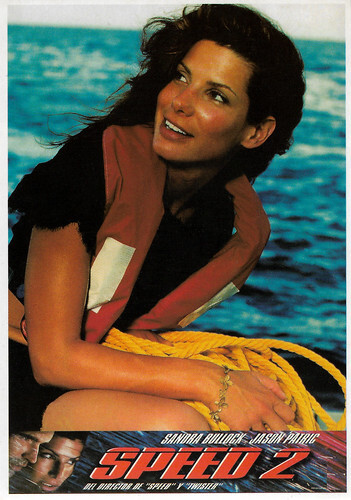
Spanish postcard by Memory Card, no. 387. Image: Spanish Lobby card with Sandra Bullock in Speed 2 - Cruise Control (Jan de Bont, 1997).
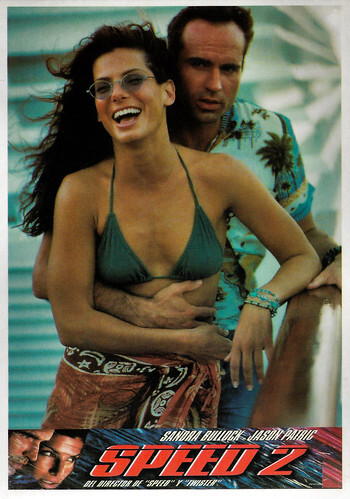
Spanish postcard by Memory Card, no. 388. Image: Spanish Lobby card with Sandra Bullock and Jason Patric in Speed 2 - Cruise Control (Jan de Bont, 1997).
A stylistic departure from her charming, somewhat chaotic characters
Sandra Bullock received positive reactions for her role as FBI agent Gracie Hart in the comedy Miss Congeniality (Donald Petrie, 2000). That same year, she played an alcoholic who is sentenced to a stay in a rehab clinic after a drunken car accident in 28 Days (Betty Thomas, 2000). After a one-year break, Bullock played a police officer trying to solve a seemingly perfect crime in the thriller Murder by Numbers (Barbet Schroeder, 2002), inspired by the authentic Leopold and Loeb murder case.
Then she acted in the comedy Divine Secrets of the Ya-Ya Sisterhood (Callie Khouri, 2002) and the very successful romantic comedy Two Weeks Notice (Marc Lawrence, 2002) with Hugh Grant . In 2004, she starred in the drama Crash (Paul Haggis, 2004), which deals with racism and social tensions in Los Angeles and won an Oscar for best film. Her role as a racist woman in the film is a stylistic departure from the charming, somewhat chaotic characters she usually played.
Then, she again played Gracie Hart in the sequel Miss Congeniality 2: Armed & Fabulous (John Pasquin, 2005). She received a record fee of 17.5 million US dollars, but the comedy did not match the success of the first part. Bullock then reunited with Keanu Reeves for The Lake House (Alejandro Agresti, 2006), a new version of the South Korean film Siworae/Il Mare (Lee Hyun-Seung, 2000). She also featured in another remake, the thriller Premonition (Mennan Yapo, 2007).
In 2009, Sandra Bullock starred in three films, the hit comedy The Proposal (Anne Fletcher, 2009), All About Steve (Phil Traill, 2009) and The Blind Side (John Lee Hancock, 2009). The latter is the film adaptation of the life of Michael Oher, who grew up as a child in various foster families, then was adopted by Sean and Leigh Anne Tuohy and eventually became a successful American football player. The film grossed US$309.2 million worldwide and received an Oscar nomination for Best Picture. Bullock received critical acclaim for her portrayal of the adoptive mother, winning the Oscar, Golden Globe, Critics' Choice Award and Screen Actors Guild Award for Best Actress in a Leading Role. In 2010, she became the first to receive a Golden Raspberry Award for worst actress (All About Steve) and an Oscar for best actress (The Blind Side) in the same year.
In 2011 she made the drama Extremely Loud & Incredibly Close alongside Tom Hanks, based on the bestseller of the same name by Jonathan Safran Foer. Despite mixed reviews, the film was nominated for several film awards, including the Oscar for Best Picture. Her later successes include the Science-Fiction thriller Gravity (Alfonso Cuarón, 2013) with George Clooney , and the successful buddy comedy The Heat (Paul Feig, 2013), alongside Melissa McCarthy. Gravity had box-office takings of US $716.3 million - and was by far the most successful of her career. Gravity also received excellent reviews, with Bullock's performance receiving particular praise. For the role, she received numerous nominations for Best Actress in a Leading Role, including the Academy Award, Golden Globe, Critics' Choice Award, Screen Actors Guild Award and British Academy Film Award. Gravity won seven categories, including Best Director.
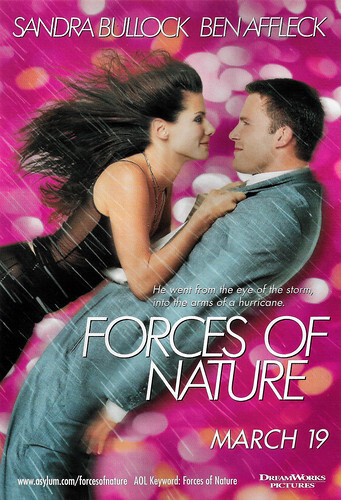
American Freecard by Hotstamp. Image: DreamWorks Pictures. Sandra Bullock and Ben Affleck in Forces of Nature (Bronwen Hughes, 1999).
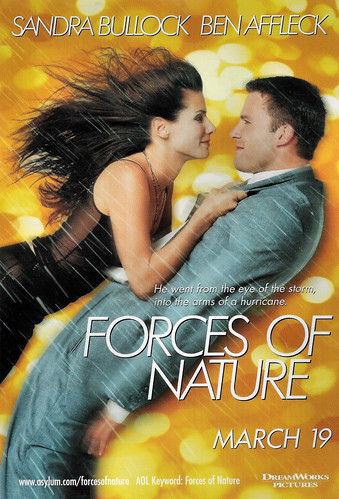
American Freecard by Hotstamp. Image: DreamWorks Pictures. Sandra Bullock and Ben Affleck in Forces of Nature (Bronwen Hughes, 1999).
One of the best female roles of the last 10 years
Sandra Bullock provided her voice for Scarlet Overkill, the villainous character, in the animated film Minions (Pierre Coffin, Kyle Balda, 2015), which became her highest-grossing film to date with a worldwide gross of over $1.1 billion. In 2015, she served as an executive producer and starred, as a political consultant hired to help win a Bolivian presidential election, in the drama Our Brand Is Crisis, based on the 2005 documentary film of the same name by Rachel Boynton. Peter Debruge of Variety found Bullock's portrayal to be "easily one of the best female roles of the last 10 years", but the film had the worst wide-release opening of her career.
In Ocean's 8 (Gary Ross, 2018), an all-female spin-off of the Ocean's Eleven franchise, Bullock played Debbie Ocean, the sister of Danny Ocean, who helps plan a sophisticated heist of the annual Met Gala in New York City. Writing for The Hollywood Reporter , Josh Spieger called the film a "welcome return to the big screen for Bullock" and observed: "She has reached a point in her career where she chooses her roles with care (...) Ocean's 8 is Bullock’s first true franchise film in decades. Ocean's 8 had the best debut for the franchise and ultimately made $297 million globally.
Her next role was that of Malorie, a woman who must find a way to guide herself and her children to safety despite the potential threat from an unseen adversary, in the Netflix post-apocalyptic horror film Bird Box (Susanne Bier, 2018), based on the novel of the same name. She received acclaim for her performance, and Bird Box was the most-watched film on Netflix within 28 days of its release until 2021. In another production for Netflix, the drama The Unforgivable (Nora Fingscheidt, 2021), Bullock played a woman who is released from prison after serving a sentence for a violent crime. It became the fifth most-streamed film on the platform at the time of its release.
She took on the role of a successful yet depressed best-selling romance novelist in The Lost City (Adam and Aaron Nee, 2022), a Romancing the Stone-style romantic comedy–adventure film, opposite Channing Tatum and Daniel Radcliffe. The film was favourably received by critics, who praised the chemistry between Bullock and Tatum and grossed $190.8 million globally. It made Bullock "the first actress to have $100 million earners in live-action star vehicles over four different decades", according to Forbes. In 2022, she also appeared in the Brad Pitt action thriller Bullet Train (2022), in a mostly vocal performance.
Sandra Bullock married once. She met Jesse Gregory James, host of the television show Monster Garage, whom she married in 2005. Together they adopted a young baby boy, Louis Bardo Bullock, in 2010. Following Bullock and James' divorce in 2010, she had full custody of the boy. Bullock announced in 2015 that she had adopted a second child, Laila Bullock, and appeared on the cover of People magazine with her then-three-year-old new daughter. Since mid-2015, Bullock has been in a relationship with photographer Bryan Randall.
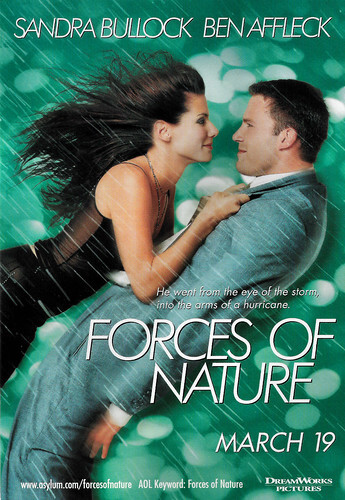
American Freecard by Hotstamp. Image: DreamWorks Pictures. Sandra Bullock and Ben Affleck in Forces of Nature (Bronwen Hughes, 1999).
Sources: Wikipedia (Dutch) and .

Belgian postcard in the 'De 50 mooiste vrouwen van de eeuw' (The 50 most beautiful women of the century) series by P-Magazine, no. 13. Photo: Kate Garner / Outline.

Canadian postcard By Canadian Postcard, no. A-370.
A bomb on board
Sandra Annette Bullock was born in Arlington, a Virginia suburb of Washington, D.C., in 1964. She is the daughter of German opera singer Helga Meyer and an American voice teacher, John Bullock, who later became Sandra's manager. Her parents met in Nüremberg, Germany, while her father was doing civil work for the Pentagon and her mother was his secretary. Sandra lived with her parents and younger sister, chef Gesine Bullock-Prado, in Nüremberg where her mother performed at the Staatstheater Nürnberg until she was 12 years old. She often performed in the children's chorus of whatever production her mother was in. In 1976, the family moved to Washington D.C. She still holds German and American citizenship and can speak fluent English and German.
Bullock did ballet and in high school, she was a cheerleader. That singing talent later came in handy for her role as an aspiring country singer in The Thing Called Love (Peter Bogdanovich, 1993). She studied at East Carolina University in Greenville, North Carolina, but interrupted her studies to pursue acting. She left for Manhattan to audition and had several jobs to earn a living in the meantime. Bullock later resumed her studies and obtained a bachelor's degree from East Carolina University. In 1987, Bullock made her official film debut in Hangmen (J. Christian Ingvordsen, 1987). Her performance in the off-Broadway play, 'No Time Flat', got her an agent and an audition for Bionic Showdown: The Six Million Dollar Man and the Bionic Woman (Alan J. Levi, 1989) with Lee Majors and Lindsay Wagner. It was a pilot for a never-produced spin-off series.
Her first major film followed in the form of the Sci-Fi action film Demolition Man (Marco Brambilla, 1993), in which she starred alongside Sylvester Stallone and Wesley Snipes. That same year, she also starred in the mystery-thriller The Vanishing (George Sluizer, 1993), a film based on Tim Krabbé's 'The Golden Egg' and in Wrestling Ernest Hemingway (Randa Haines, 1993), with Robert Duvall, Richard Harris and Shirley MacLaine .
Sandra Bullock had her big breakthrough in Speed (Jan de Bont, 1994), in which she and Keanu Reeves try to save the passengers of a public bus from a bomb explosion. The bus races through Los Angeles rush hour traffic without stopping because of a bomb on board. The film grossed 350.4 million US dollars worldwide in 1994. The following year, she starred with Bill Pullman in the romantic comedy While You Were Sleeping (Jon Turteltaub, 1995). The film was another box office success and earned Bullock her first Golden Globe nomination. She established herself as one of Hollywood's most popular and highest-paid actresses with the thriller The Net (Irwin Winkler, 1995).
Bullock appeared with Matthew McConaughey and Samuel Jackson in the thriller A Time to Kill (Joel Schumacher, 1996), based on the book by John Grisham. She actually played only a supporting role, but due to her popularity, her name was mentioned first on film posters. Bullock received a fee of six million US dollars for the role. Then followed the war film In Love and War (Richard Attenborough, 1996), about the young Ernest Hemingway played by Chris O'Donnell. The sequel Speed 2: Cruise Control (Jan de Bont, 1997) was massively criticised and received a Golden Raspberry Award for the worst sequel to a film. However, it did well at the box office. Bullock was paid 12.5 million US dollars. A year later, Bullock co-starred with Nicole Kidman as a witch in the fantasy comedy Practical Magic (Griffin Dunne, 1998). She also voiced Miriam in the animated film The Prince of Egypt (Brenda Chapman, 1998). In Forces of Nature (Bronwen Hughes, 1999), she co-starred with Ben Affleck.

Spanish postcard by Memory Card, no. 387. Image: Spanish Lobby card with Sandra Bullock in Speed 2 - Cruise Control (Jan de Bont, 1997).

Spanish postcard by Memory Card, no. 388. Image: Spanish Lobby card with Sandra Bullock and Jason Patric in Speed 2 - Cruise Control (Jan de Bont, 1997).
A stylistic departure from her charming, somewhat chaotic characters
Sandra Bullock received positive reactions for her role as FBI agent Gracie Hart in the comedy Miss Congeniality (Donald Petrie, 2000). That same year, she played an alcoholic who is sentenced to a stay in a rehab clinic after a drunken car accident in 28 Days (Betty Thomas, 2000). After a one-year break, Bullock played a police officer trying to solve a seemingly perfect crime in the thriller Murder by Numbers (Barbet Schroeder, 2002), inspired by the authentic Leopold and Loeb murder case.
Then she acted in the comedy Divine Secrets of the Ya-Ya Sisterhood (Callie Khouri, 2002) and the very successful romantic comedy Two Weeks Notice (Marc Lawrence, 2002) with Hugh Grant . In 2004, she starred in the drama Crash (Paul Haggis, 2004), which deals with racism and social tensions in Los Angeles and won an Oscar for best film. Her role as a racist woman in the film is a stylistic departure from the charming, somewhat chaotic characters she usually played.
Then, she again played Gracie Hart in the sequel Miss Congeniality 2: Armed & Fabulous (John Pasquin, 2005). She received a record fee of 17.5 million US dollars, but the comedy did not match the success of the first part. Bullock then reunited with Keanu Reeves for The Lake House (Alejandro Agresti, 2006), a new version of the South Korean film Siworae/Il Mare (Lee Hyun-Seung, 2000). She also featured in another remake, the thriller Premonition (Mennan Yapo, 2007).
In 2009, Sandra Bullock starred in three films, the hit comedy The Proposal (Anne Fletcher, 2009), All About Steve (Phil Traill, 2009) and The Blind Side (John Lee Hancock, 2009). The latter is the film adaptation of the life of Michael Oher, who grew up as a child in various foster families, then was adopted by Sean and Leigh Anne Tuohy and eventually became a successful American football player. The film grossed US$309.2 million worldwide and received an Oscar nomination for Best Picture. Bullock received critical acclaim for her portrayal of the adoptive mother, winning the Oscar, Golden Globe, Critics' Choice Award and Screen Actors Guild Award for Best Actress in a Leading Role. In 2010, she became the first to receive a Golden Raspberry Award for worst actress (All About Steve) and an Oscar for best actress (The Blind Side) in the same year.
In 2011 she made the drama Extremely Loud & Incredibly Close alongside Tom Hanks, based on the bestseller of the same name by Jonathan Safran Foer. Despite mixed reviews, the film was nominated for several film awards, including the Oscar for Best Picture. Her later successes include the Science-Fiction thriller Gravity (Alfonso Cuarón, 2013) with George Clooney , and the successful buddy comedy The Heat (Paul Feig, 2013), alongside Melissa McCarthy. Gravity had box-office takings of US $716.3 million - and was by far the most successful of her career. Gravity also received excellent reviews, with Bullock's performance receiving particular praise. For the role, she received numerous nominations for Best Actress in a Leading Role, including the Academy Award, Golden Globe, Critics' Choice Award, Screen Actors Guild Award and British Academy Film Award. Gravity won seven categories, including Best Director.

American Freecard by Hotstamp. Image: DreamWorks Pictures. Sandra Bullock and Ben Affleck in Forces of Nature (Bronwen Hughes, 1999).

American Freecard by Hotstamp. Image: DreamWorks Pictures. Sandra Bullock and Ben Affleck in Forces of Nature (Bronwen Hughes, 1999).
One of the best female roles of the last 10 years
Sandra Bullock provided her voice for Scarlet Overkill, the villainous character, in the animated film Minions (Pierre Coffin, Kyle Balda, 2015), which became her highest-grossing film to date with a worldwide gross of over $1.1 billion. In 2015, she served as an executive producer and starred, as a political consultant hired to help win a Bolivian presidential election, in the drama Our Brand Is Crisis, based on the 2005 documentary film of the same name by Rachel Boynton. Peter Debruge of Variety found Bullock's portrayal to be "easily one of the best female roles of the last 10 years", but the film had the worst wide-release opening of her career.
In Ocean's 8 (Gary Ross, 2018), an all-female spin-off of the Ocean's Eleven franchise, Bullock played Debbie Ocean, the sister of Danny Ocean, who helps plan a sophisticated heist of the annual Met Gala in New York City. Writing for The Hollywood Reporter , Josh Spieger called the film a "welcome return to the big screen for Bullock" and observed: "She has reached a point in her career where she chooses her roles with care (...) Ocean's 8 is Bullock’s first true franchise film in decades. Ocean's 8 had the best debut for the franchise and ultimately made $297 million globally.
Her next role was that of Malorie, a woman who must find a way to guide herself and her children to safety despite the potential threat from an unseen adversary, in the Netflix post-apocalyptic horror film Bird Box (Susanne Bier, 2018), based on the novel of the same name. She received acclaim for her performance, and Bird Box was the most-watched film on Netflix within 28 days of its release until 2021. In another production for Netflix, the drama The Unforgivable (Nora Fingscheidt, 2021), Bullock played a woman who is released from prison after serving a sentence for a violent crime. It became the fifth most-streamed film on the platform at the time of its release.
She took on the role of a successful yet depressed best-selling romance novelist in The Lost City (Adam and Aaron Nee, 2022), a Romancing the Stone-style romantic comedy–adventure film, opposite Channing Tatum and Daniel Radcliffe. The film was favourably received by critics, who praised the chemistry between Bullock and Tatum and grossed $190.8 million globally. It made Bullock "the first actress to have $100 million earners in live-action star vehicles over four different decades", according to Forbes. In 2022, she also appeared in the Brad Pitt action thriller Bullet Train (2022), in a mostly vocal performance.
Sandra Bullock married once. She met Jesse Gregory James, host of the television show Monster Garage, whom she married in 2005. Together they adopted a young baby boy, Louis Bardo Bullock, in 2010. Following Bullock and James' divorce in 2010, she had full custody of the boy. Bullock announced in 2015 that she had adopted a second child, Laila Bullock, and appeared on the cover of People magazine with her then-three-year-old new daughter. Since mid-2015, Bullock has been in a relationship with photographer Bryan Randall.

American Freecard by Hotstamp. Image: DreamWorks Pictures. Sandra Bullock and Ben Affleck in Forces of Nature (Bronwen Hughes, 1999).
Sources: Wikipedia (Dutch) and .
Published on September 14, 2023 22:00
September 13, 2023
Scott Brady
American actor Scott Brady (1924-1985) had the manly good looks and rugged appeal to make it to top stardom in Hollywood and succeeded quite well with tough-guy roles on film and TV.
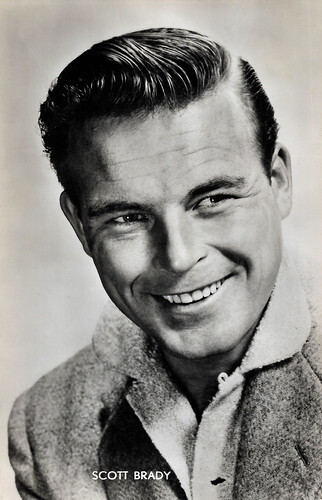
Vintage postcard.
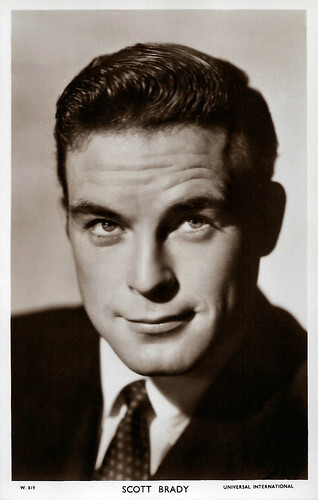
British postcard in the Picturegoer Series, London, no. W. 819. Photo: Universal International.
Handsome, blue-eyed looker
Irish-American Scott Brady was born in Brooklyn in 1924 as Gerard Kenneth Tierney (called Jerry). His parents were Lawrence and Maria Tierney. His father, chief of New York's aqueduct police force, had always had show business intentions and after retiring from the force he got, through his sons, some work in print advertising.
Both Scott's older and younger brothers, Lawrence Tierney and Edward Tierney went on to become actors as well. Lawrence's promising Film Noir 'bad guy' career was sabotaged by a severe drinking disorder that led to numerous skirmishes with the law. Scott himself faced a narcotics charge in 1957 (charges were dropped, Scott maintained that he was framed) and in 1963, he was involved in illegal bookmaking activities.
Gary Brumburgh at IMDb : "Fortunately, Scott was more cool-headed and wound up avoiding the pitfalls that befell his older brother, making a very lucrative living for himself in Hollywood throughout the 1950s and early 1960s."
Scott Brady grew up in Westchester County and attended Roosevelt and St. Michael's High Schools. Like his older brother Lawrence, Scott was an all-around athlete in school and earned letters for basketball, football and track and expressed early designs on becoming a football coach or radio announcer. Instead, he enlisted before graduating from high school and served as a naval aviation mechanic overseas. During his term of duty, he earned a light heavyweight boxing medal.
He was discharged in 1946 and decided to head for Los Angeles where his older brother Lawrence was making encouraging strides as an actor. Toiling in menial jobs as a cabbie and day-time labourer, the handsome, blue-eyed looker was noticed having lunch in a café by producer Hal B. Wallis and offered a screen test. The test did not fare well but, not giving up, he enrolled in the Bliss-Hayden drama school under his G.I. Bill, studied acting, and managed to rid himself of his thick Brooklyn accent.
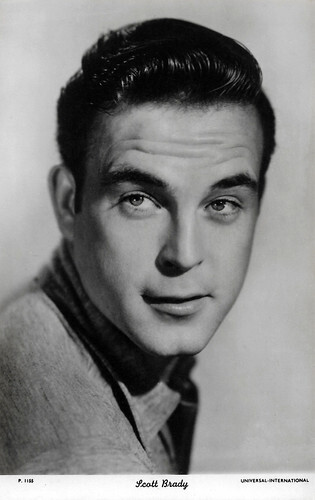
British postcard in the Film Star Series by "The People" Show Parade Picture Service, London, no. P. 1155. Photo: Universal International.
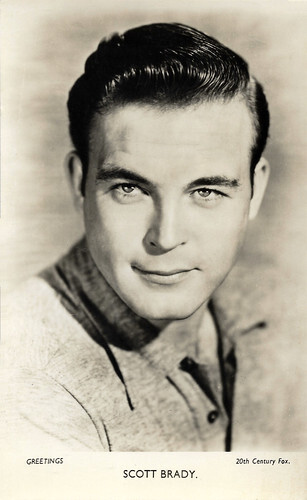
British postcard in the Greetings Series. Photo: 20th Century Fox.
Minor cult status as a bad hombre
Scott Brady signed with a minor league studio, Eagle-Lion, and debuted in the poverty-row programmer In This Corner (Charles Reisner, 1948), utilising his boxing skills from his early days in the service. He showed more promise with his second and third films Canon City (Crane Wilbur, 1948) and He Walked by Night (Alfred L. Werker, 1948), the latter as a detective who aids in nabbing psychotic killer Richard Basehart .
Scott switched over to higher-grade action stories for Fox and Universal over time. Westerns and crime stories would be his bread-winning genres with The Gal Who Took the West (Frederick De Cordova, 1949) opposite Yvonne De Carlo and Charles Coburn, and Undertow (William Castle, 1949), with John Russell, being prime examples.
He frequently switched from hero to heavy during his peak years. In one film he would romance a Jeanne Crain in The Model and the Marriage Broker (George Cukor, 1951) or a Mitzi Gaynor in Bloodhounds of Broadway (Harmon Jones, 1952), while in the next beat Shelley Winters to a pulp in Untamed Frontier (Hugo Fregonese, 1952).
A favourite pin-up hunk in his early years, he hit minor cult status as a bad hombre, The Dancin' Kid, in the offbeat Western Johnny Guitar (Nicholas Ray, 1954). He and the other manly men, however, were somewhat overshadowed in the film by the Freudian-tinged gunplay between Joan Crawford and Mercedes McCambridge.
Other roles had him sturdily handling the action scenes while giving the glance over to such diverting female costars as Barbara Stanwyck , Mala Powers and Anne Bancroft.
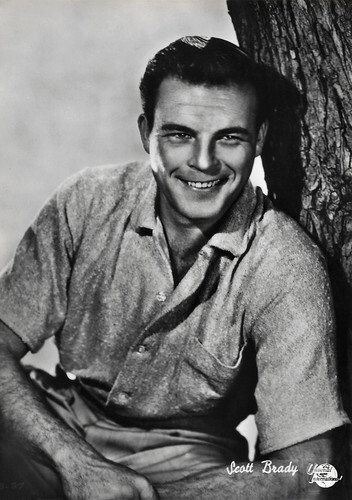
Italian postcard by Bromofoto, Milano, no. 315. Photo: Universal International.
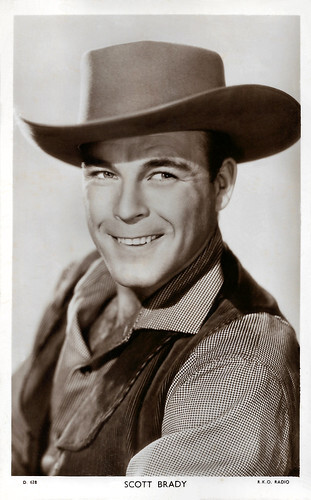
British postcard in the Picturegoer Series, London, no. D. 628. Photo: RKO Radio. Scott Brady in Montana Belle (Allan Dwan, 1952).
A character heavy or hard-ass cop
Scott Brady would mark the same territory in TV - Westerns and crime films - finding steadier work on the smaller screen into the 1960s. He starred as the title hero in the Western series Shotgun Slade (1959). The stage was also a sporadic source of income with such productions as 'The Moon Is Blue', 'Detective Story' and 'Picnic'.
He made his Broadway debut as a slick card sharpie opposite Andy Griffith and Dolores Gray in the short-lived musical 'Destry Rides Again' in 1959. Scott played the villainous role Brian Donlevy played in the original.
He later did the national company of the heavyweight political drama 'The Best Man' with his portrayal of a senator. The seemingly one-time confirmed bachelor decided to settle down after meeting and marrying Mary Tirony in 1967 at age 43. Prior to this, he had been linked with such luminous beauties as Gwen Verdon and Dorothy Malone. The couple had two sons: Timothy and Terence.
Parts dwindled down in size in later years and he gained considerable weight as he grew older and balder, but he still appeared here and there as an occasional character heavy or hard-ass cop in less-important films such as Doctors' Wives (George Schaefer, 1971), $ (Richard Brooks, 1971) with Warren Beatty, The Loners (Sutton Roley, 1972) and Wicked, Wicked (Richard L. Bare, 1973). Minor TV roles in mini-movies also came his way at a fair pace. Towards the end, he was seen in such high-profile big-screen movies as The China Syndrome (James Bridges, 1979) and Gremlins (Joe Dante, 1984).
Scott had a collapse in 1981 and was diagnosed with pulmonary fibrosis, a progressive respiratory disease. He later relied on an oxygen tank. He died of the disease four years later and was interred at the Holy Cross Cemetery in Culver City, California. Scott's brother Edward Tierney became a building contractor after quitting as an actor, and Scott financed several of his projects. One of these included the apartment building where the infamous Wonderland murders took place. According to Scott's son Tim, Scott had a falling out with brother Lawrence Tierney in the late 1960s that lasted nearly two decades. His son Terence also became an actor.
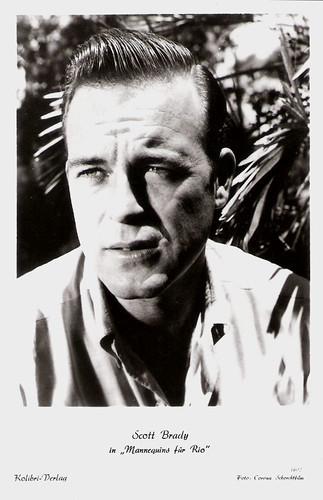
German postcard by Kolibri-Verlag, no. 1102. Photo: Corona / Schorchtfilm. Scott Brady in Mannequins für Rio/They were so Young (Kurt Neumann, 1954).
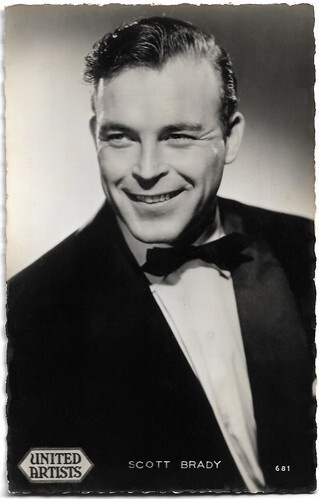
French postcard by Editions P.I., Paris, offered by Les Carbones Korès "Carboplane", no. 681. Photo: United Artists.
Sources: (IMDb), Wikipedia and .

Vintage postcard.

British postcard in the Picturegoer Series, London, no. W. 819. Photo: Universal International.
Handsome, blue-eyed looker
Irish-American Scott Brady was born in Brooklyn in 1924 as Gerard Kenneth Tierney (called Jerry). His parents were Lawrence and Maria Tierney. His father, chief of New York's aqueduct police force, had always had show business intentions and after retiring from the force he got, through his sons, some work in print advertising.
Both Scott's older and younger brothers, Lawrence Tierney and Edward Tierney went on to become actors as well. Lawrence's promising Film Noir 'bad guy' career was sabotaged by a severe drinking disorder that led to numerous skirmishes with the law. Scott himself faced a narcotics charge in 1957 (charges were dropped, Scott maintained that he was framed) and in 1963, he was involved in illegal bookmaking activities.
Gary Brumburgh at IMDb : "Fortunately, Scott was more cool-headed and wound up avoiding the pitfalls that befell his older brother, making a very lucrative living for himself in Hollywood throughout the 1950s and early 1960s."
Scott Brady grew up in Westchester County and attended Roosevelt and St. Michael's High Schools. Like his older brother Lawrence, Scott was an all-around athlete in school and earned letters for basketball, football and track and expressed early designs on becoming a football coach or radio announcer. Instead, he enlisted before graduating from high school and served as a naval aviation mechanic overseas. During his term of duty, he earned a light heavyweight boxing medal.
He was discharged in 1946 and decided to head for Los Angeles where his older brother Lawrence was making encouraging strides as an actor. Toiling in menial jobs as a cabbie and day-time labourer, the handsome, blue-eyed looker was noticed having lunch in a café by producer Hal B. Wallis and offered a screen test. The test did not fare well but, not giving up, he enrolled in the Bliss-Hayden drama school under his G.I. Bill, studied acting, and managed to rid himself of his thick Brooklyn accent.

British postcard in the Film Star Series by "The People" Show Parade Picture Service, London, no. P. 1155. Photo: Universal International.

British postcard in the Greetings Series. Photo: 20th Century Fox.
Minor cult status as a bad hombre
Scott Brady signed with a minor league studio, Eagle-Lion, and debuted in the poverty-row programmer In This Corner (Charles Reisner, 1948), utilising his boxing skills from his early days in the service. He showed more promise with his second and third films Canon City (Crane Wilbur, 1948) and He Walked by Night (Alfred L. Werker, 1948), the latter as a detective who aids in nabbing psychotic killer Richard Basehart .
Scott switched over to higher-grade action stories for Fox and Universal over time. Westerns and crime stories would be his bread-winning genres with The Gal Who Took the West (Frederick De Cordova, 1949) opposite Yvonne De Carlo and Charles Coburn, and Undertow (William Castle, 1949), with John Russell, being prime examples.
He frequently switched from hero to heavy during his peak years. In one film he would romance a Jeanne Crain in The Model and the Marriage Broker (George Cukor, 1951) or a Mitzi Gaynor in Bloodhounds of Broadway (Harmon Jones, 1952), while in the next beat Shelley Winters to a pulp in Untamed Frontier (Hugo Fregonese, 1952).
A favourite pin-up hunk in his early years, he hit minor cult status as a bad hombre, The Dancin' Kid, in the offbeat Western Johnny Guitar (Nicholas Ray, 1954). He and the other manly men, however, were somewhat overshadowed in the film by the Freudian-tinged gunplay between Joan Crawford and Mercedes McCambridge.
Other roles had him sturdily handling the action scenes while giving the glance over to such diverting female costars as Barbara Stanwyck , Mala Powers and Anne Bancroft.

Italian postcard by Bromofoto, Milano, no. 315. Photo: Universal International.

British postcard in the Picturegoer Series, London, no. D. 628. Photo: RKO Radio. Scott Brady in Montana Belle (Allan Dwan, 1952).
A character heavy or hard-ass cop
Scott Brady would mark the same territory in TV - Westerns and crime films - finding steadier work on the smaller screen into the 1960s. He starred as the title hero in the Western series Shotgun Slade (1959). The stage was also a sporadic source of income with such productions as 'The Moon Is Blue', 'Detective Story' and 'Picnic'.
He made his Broadway debut as a slick card sharpie opposite Andy Griffith and Dolores Gray in the short-lived musical 'Destry Rides Again' in 1959. Scott played the villainous role Brian Donlevy played in the original.
He later did the national company of the heavyweight political drama 'The Best Man' with his portrayal of a senator. The seemingly one-time confirmed bachelor decided to settle down after meeting and marrying Mary Tirony in 1967 at age 43. Prior to this, he had been linked with such luminous beauties as Gwen Verdon and Dorothy Malone. The couple had two sons: Timothy and Terence.
Parts dwindled down in size in later years and he gained considerable weight as he grew older and balder, but he still appeared here and there as an occasional character heavy or hard-ass cop in less-important films such as Doctors' Wives (George Schaefer, 1971), $ (Richard Brooks, 1971) with Warren Beatty, The Loners (Sutton Roley, 1972) and Wicked, Wicked (Richard L. Bare, 1973). Minor TV roles in mini-movies also came his way at a fair pace. Towards the end, he was seen in such high-profile big-screen movies as The China Syndrome (James Bridges, 1979) and Gremlins (Joe Dante, 1984).
Scott had a collapse in 1981 and was diagnosed with pulmonary fibrosis, a progressive respiratory disease. He later relied on an oxygen tank. He died of the disease four years later and was interred at the Holy Cross Cemetery in Culver City, California. Scott's brother Edward Tierney became a building contractor after quitting as an actor, and Scott financed several of his projects. One of these included the apartment building where the infamous Wonderland murders took place. According to Scott's son Tim, Scott had a falling out with brother Lawrence Tierney in the late 1960s that lasted nearly two decades. His son Terence also became an actor.

German postcard by Kolibri-Verlag, no. 1102. Photo: Corona / Schorchtfilm. Scott Brady in Mannequins für Rio/They were so Young (Kurt Neumann, 1954).

French postcard by Editions P.I., Paris, offered by Les Carbones Korès "Carboplane", no. 681. Photo: United Artists.
Sources: (IMDb), Wikipedia and .
Published on September 13, 2023 22:00
September 12, 2023
Harry Baur
French film and stage actor Harry Baur (1880-1943) was directed by filmmakers as wide-ranging as Julien Duvivier, Abel Gance, Marcel L'Herbier, Robert Siodmak and Maurice Tourneur. He switched just as easily from Jean Valjean in Les Misérables to Commissaire Maigret, and from Judge Porphyre in Crime et Chatiment to amazing interpretations of Taras Bulba, Beethoven and Rasputin.
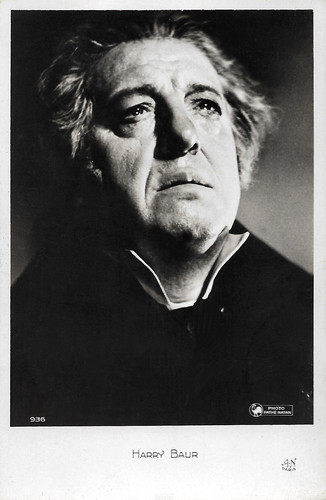
French postcard by A.N., Paris, no. 936. Photo: Pathé Natan. Harry Baur as Jean Valjean in Les Misérables (Raymond Bernard, 1934), based on the novel by Victor Hugo.
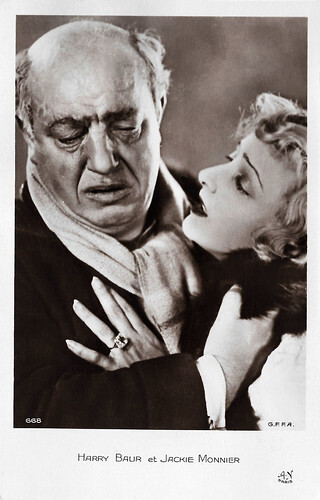
French postcard by A.N., Paris, no. 6684. Photo: Gaumont-Franco Film-Aubert (G.F.F.A). Harry Baur and Jackie Monnier in David Golder (Julien Duvivier, 1931).
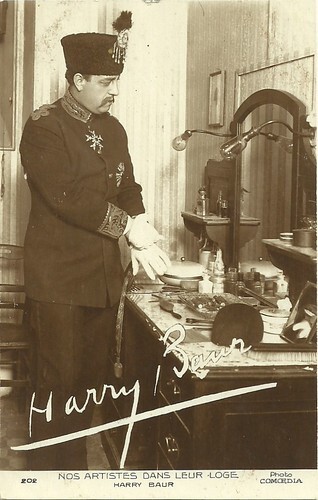
French postcard in the series Nos artistes dans leur loge, no. 202. Photo: Comoedia.
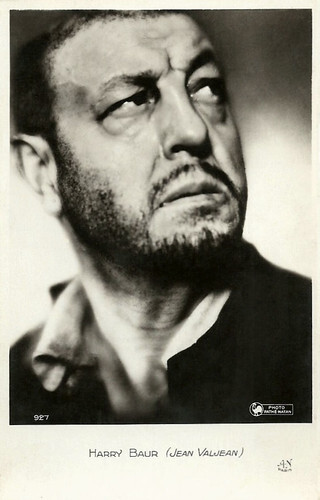
French postcard by A.N., Paris. Photo: Pathé Natan. Publicity still for Les Misérables (Raymond Bernard, 1934).
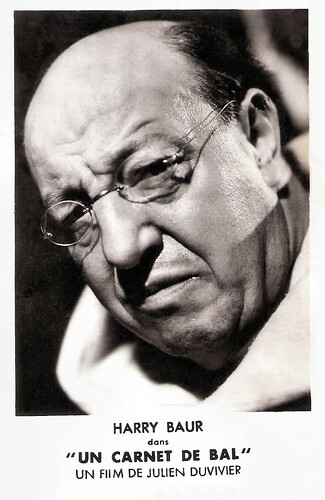
French postcard by Edition Chantal, Paris. Photo: publicity still for Un Carnet de Bal/Dance Program (Julien Duvivier, 1937).
A man of substance
Henri-Marie Rodolphe Baur, better known as Harry Baur, was born in Paris in 1880. His parents were Catholics from the Alsace; his father came from Mulhouse, and his mother from Bitche en Moselle. They were ruined after theft and had to move to ever more modest dwellings. Baur’s father died when Harry was 10, so his mother and his sister Blanche raised him.
He first did college at Saint-Nazaire. To escape the religious education his family wanted him to take, he fled to Marseille and joined the rugby team of the XVth Olympic Games in Marseille. Here he started studies at the École d'Hydrographie and enrolled in various odd jobs such as peddler, carter, braider of funeral wreaths etc. Slowly he managed to start a career as a stage actor.
As he was refused at the Conservatoire in Paris, he took private lessons. He first enlisted at the Comédie Mondaine in 'Le Filleul du 31'. He then received his first awards for tragedy in 'Le Cid' and for comedy with 'L'Avare' at the Conservatoire in Marseille, while he did military service in Le Mans. He became the secretary of the famous actor-director Mounet-Sully . From 1904 on, he played in numerous Parisian theatres: Comédie Mondaine, Grand Guignolalais-Royal, and Mathurins. Later he also played with Gémier and Antoine.
Because of a beginning facial paralysis, he didn’t have to do service when war broke out in 1914, so he continued to play at the Gaîté-Lyrique, the Ambigu, the Porte Saint-Martin, the Gymnase, the Édouard VII, the Variétés, etc. Baur also collaborated as a film reviewer for 'Crapouillot', under the pseudonym of Orido de Fhair. By the early 1910s, Baur had become not only a man of substance in the diversity of his career, but also physically. Between 1909 and 1914, Harry Baur also performed in almost 30 silent films. He started at Eclair with Beethoven (Victorin Jasset, 1908) from 1909 on he worked at Pathé as well, a.o. in the Vidoq films (1909-1911), and the Film d’Art films such as L’Assommoir/Drink (Albert Capellani, 1909) after Émile Zola . At Eclair he worked a.o. with director Maurice Tourneur in Monsieur Lecoq/Mr. Lecoq (1914).
With Mistinguett , Baur played in Fleur de Paris/Flower of Paris (André Hugon, 1916) and Chignon d’or/The Gold Chignon (André Hugon, 1916), and with Albert Dieudonné in Sous la griffe/Under the label (Albert Dieudonné, 1921). In La voyante/The Clairvoyant (Leon Abrams, Louis Mercanton, 1923) he played opposite the legendary Sarah Bernhardt . Between 1924 and the arrival of French sound film Baur was away from the screen and focused on the stage. In 1910 he married actress Rose Cremer, known as Rose Grande, and they had three children. In 1931 Rose died during a trip to Algeria. Baur then married Rika Radifé, a stage actress as well, and of Turkish origin (her real name was Rebecca Behar).
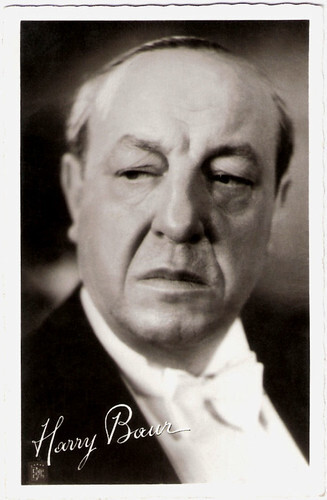
French postcard by Editions et Publications cinématographigues (EPC), no. 81.
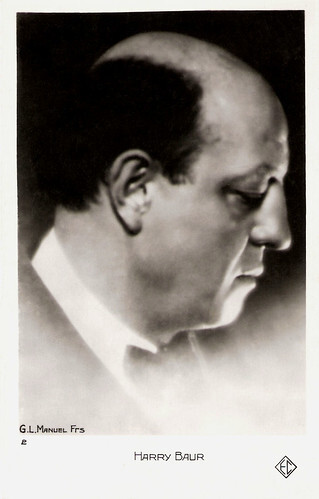
French postcard by Editions E.C., Paris, no. 2. Photo: G.L. Manuel Frères, Paris.
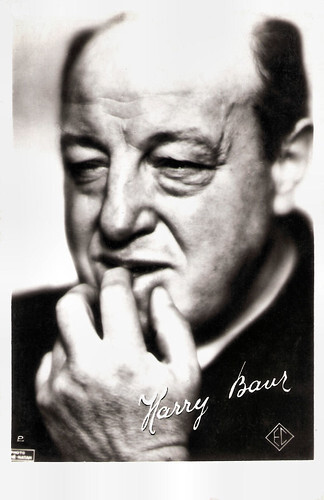
French postcard by EC, no. 2. Photo: Pathé-Natan.
Baur’s most important director during the 1930s
In 1931 Harry Baur had a triumph on stage with his interpretation of César in Marcel Pagnol’s play 'Fanny', the sequel to his 'Marius'. Baur had substituted the great Raimu in this role and would become a fierce competitor to the actor all through the 1930s, both on stage and on screen. Earlier in 1931, one of Baur’s first sound films had been released, the drama David Golder, directed by Julien Duvivier, who supposedly had brought Baur back to the screen. Duvivier would become Baur’s most important director during the 1930s. The timing of David Golder is not entirely clear, as in 1931 Baur also went to London to act in an early French talkie shot there at British International Pictures: the multilingual Le cap perdu (Ewald André Dupont, 1931). Le cap perdu/Cape Forlorn was quickly forgotten, but David Golder was a huge success in France at the time. The film about a betrayed Jewish banker was almost shot like a silent film at the Basque Coast. It was a clever streak of Duvivier to relaunch Harry Baur as a film actor with this topic. Baur had already been successful in a stage version at the Théâtre de la Porte Saint-Martin in Paris.
In March 1931, when David Golder was released in France, Baur started production for Le juif polonais/Polish Jew (Jean Kemm, 1931), about a man who is haunted by his murder. The film was especially created for Baur to excel but it wasn’t as lucrative as David Golder. After this followed Criminel/Criminal (Jack Forrester, 1932), an alternate language version of The Criminal Code (Howard Hawks, 1931). Baur played a prison warden, while Jean Servais made his film debut as an innocently condemned young man who is involved in a crime within the prison.
After this, Baur played in three films by Julien Duvivier. The first was Les cinq gentlemen maudits/Moon Over Morocco (1932) with René Lefèvre and Robert Le Vigan . Parallel Duvivier shot a German version with Adolf Wohlbruck , Camilla Horn and Jack Trevor . Exteriors were shot at Fez, Marrakech and Moulay-Idriss. The press praised Duvivier’s taste for atmosphere, picturesque and exoticism. Next was the adaptation of Jules Renard’s novel Poil de Carotte/The Red Head (Julien Duvivier, 1932), with Baur as the unforgettable Monsieur Lepic next to the young Robert Lynen (Both actors would share the same, tragic destiny, as Lynen was a member of the Resistance in the war, was imprisoned in 1943 and executed by the Germans in 1944). For his sound version of Poil de Carotte, Duvivier borrowed from other works of Renard as well, such as 'La Bigote' (The Bigote). In 1926 Duvivier had already made a silent version with André Heuzé as Poil de Carotte and Henry Krauss as M. Lepic. Baur had a very precise idea of how to play Lepic and was a perfectionist in his creation. Poil de Carotte had a prosperous release in Paris in 1932, with praise for Harry Baur.
Not wanting to let go of his star, Duvivier had him play commissaire Jules Maigret in La tête d’un homme/A Man's Neck (Julien Duvivier, 1932). While author Georges Simenon thought at the time that Baur was too old for the part and too tragic, the film is now considered one of the best adaptations of Simenon's novels. In 1932 Baur played Monsieur de Tréville, captain of the King’s guards in a very florishing sound version of Les trois mousquetaires/The Three Musketeers (1932). A decade earlier, director Henri Diamant-Berger had done a silent version, a serial in 12 episodes. Now it was a two-part sound version, entitled Les ferrets de la reine/The Queen's Studs and Milady.
Baur was coupled with Pierre Blanchar in Cette vieille canaille/The Old Devil (Anatole Litvak, 1933). While Baur did not convince as a clochard who is a distant relative of the Rothschild family in Rotchild (Marco de Gastyne, 1933), he came back full fling as Jean Valjean in Les Misérables (Raymond Bernard, 1933), an adaptation of Victor Hugo ’s classic novel. Costars were Charles Vanel as Javert and Josseline Gael as Cosette. Because of its length, the film was released in two parts. It became Baur’s best film performance and some say the best film interpretation of Hugo’s famous character. Because of the European success, Baur received offers from Hollywood, but he didn’t want to leave Paris and declined.
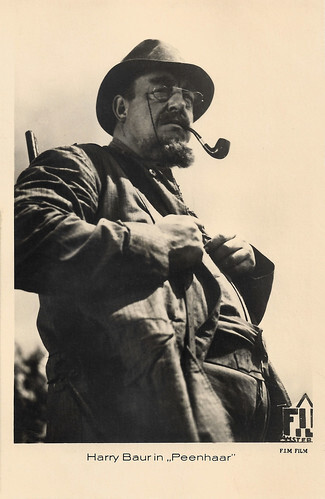
Dutch postcard. Photo: Fim Film, Amsterdam. Harry Baur in Poil de carotte/The Red Head (Julien Duvivier, 1932).
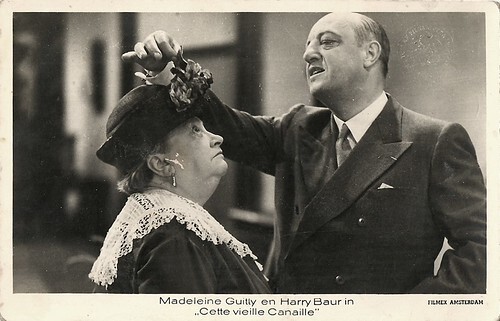 br />Dutch postcard. Photo: Filmex, Amsterdam. Madeleine Guitty and Harry Baur in Cette vieille canaille/The Old Devil (Anatole Litvak, 1933).
br />Dutch postcard. Photo: Filmex, Amsterdam. Madeleine Guitty and Harry Baur in Cette vieille canaille/The Old Devil (Anatole Litvak, 1933).
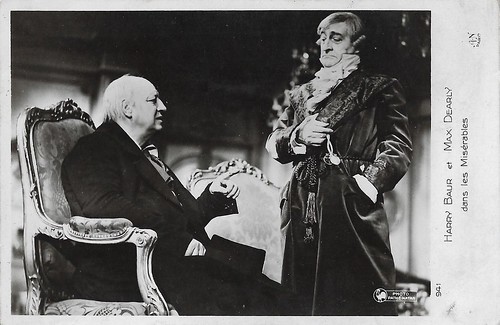
French postcard by A.N. Paris, no. 941. Photo Pathé Natan. Harry Baur as Jean Valjean and Max Dearly as Gillenormand in Les Misérables (Raymond Bernard, 1934).
A remake of an expressionist classic
After two lesser films, Harry Baur was back with Les nuits moscovites/Moscow Nights (Alexis Granowski, 1934), also the debut of Neapolitan singer-actor Tino Rossi . Harry Baur played a course, rich Russian wheat trader, opposite Annabella and Pierre-Richard Wilm . The success of the film caused producers to offer Baur one ‘Russian’ film after another. At the time films shot by and featuring fled White Russians were popular in France. After that it is time to play Herod in Golgotha (Julien Duvivier, 1935), co-starring Jean Gabin as Pontius Pilate, Robert le Vigan as Jesus and Edwige Feuillère as Claudia Procula.
General Production offered Baur the part of Judge Porphyre in Crime et chatiment/Crime and Punishment (Pierre Chenal, 1935), based on Dostoievski’s novel. The confrontation between Baur and his costar Pierre Blanchar was the climax of this thriving film, which launched the career of Chenal in the 1930s. The sets of the film were highly stylized, inspired by German Expressionism. This might have inspired Duvivier to do a remake of the Expressionist classic Der Golem by Paul Wegener : Le Golem/The Golem (Julien Duvivier, 1935), with Baur playing Emperor Rudolph and with shooting at studios in Prague, where the story takes place. Baur then went to London for an English version of Nuits moscovites, Moscow Nights (Anthony Asquith, 1935) with a young Laurence Olivier .
Maurice Tourneur, with whom Baur had worked together in the 1910s, then shot Samson (1936), a modern drama based on a play by Henry Bernstein. It had already been adapted for the silent cinema and involved adultery and the power of money. Gaby Morlay and Baur were the central couple whose silences were as telling as their words. Then it was imperial Russia time again with Les yeux noirs/Black Eyes (Viktor Tourjansky, 1936) with Baur and Simone Simon , before moving over to the Hungarian steppes for Tarass Boulba/Taras Bulba (Alexis Granowsky, 1936), based on Gogol’s novel. It was both critically and commercially Baur’s biggest success since Les Misérables. The wild and intense Boulba matched Baur perfectly and his performance impressed audiences. For Les hommes nouveaux/The New Men (1936), director Marcel L’Herbier shot the first documentary part on the pacification of Morocco with actor Gabriel Signoret made up as marshal Lyautey, whom all thought had a striking resemblance. Baur had a supporting part as Maurice de Tolly, inspector general. While the film was a clear colonial product, L’Herbier’s most important drive was to ignite the fire of national patriotism in light of the growing German military force. A young Jean Marais had one of his first roles here.
Abel Gance gave Baur a great part in the title role of Un grand amour de Beethoven (1936), a character that Baur already had played in his first film. After a break in Italy, Duvivier asked Baur to play a man turned Dominican monk in his well-known bitter film Un carnet de bal/Dance Program (Julien Duvivier, 1937). In the film, a young widow ( Marie Bell ) revisits the dancers from her old booklet, but they are all disappointments. The film was a worldwide success and was awarded the Coppa Mussolini for best foreign film in Venice. Next Baur took the boat to Algeria for the shooting of Sarati le Terrible/Sarati the Terrible (André Hugon, 1937) in which Baur played a sordid brute, who rules the underworld of the docks in Algiers. He remained within the exotic with his part of an Arabian sheikh in West Africa in Les secrets de la Mer Rouge/Secrets of the Red Sea (Richard Pottier, 1937).
Mollenard/Hatred (Robert Siodmak, 1938) was set in Shanghai but shot at Dunkerque, with the help of set designer Alexandre Trauner. Mollenard was one of the finest films of the era and meant another memorable part for Baur. Young Robert Lynen again played his son. Director Siodmak faced many problems during the making of this film: he lost good money over competition with Duvivier on the adaptation rights, he had trouble finding producers, and at the start of shooting Baur had a heart attack, though without consequences. La tragédie impériale/Rasputin (Marcel L'Herbier, 1938) was about the life of Rasputin and his power during the reign of the last Tsar Nicolas II. Baur had made considerable study of his character; he also wore false high heels in his shoes and lost considerable weight to look more like his character.
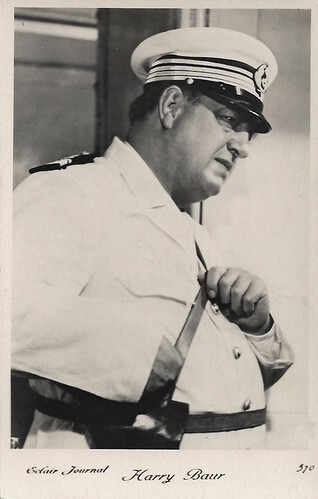
French postcard by Eclair Journal, no. 570. Photo: Mega Film Harry Baur as a submarine commander in Nitchevo (Jacques de Baroncelli, 1936). Eclair Journal was the distributor of the film.
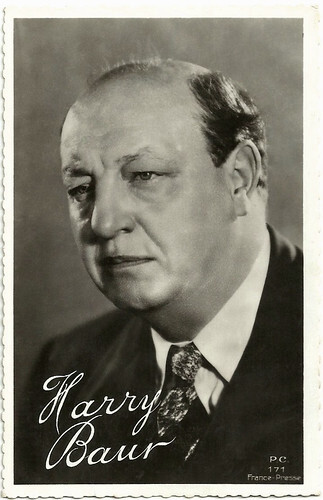
French postcard by P.C., no. 171. Photo: France Presse.
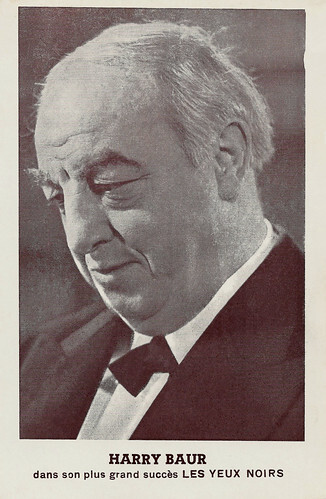
French card.
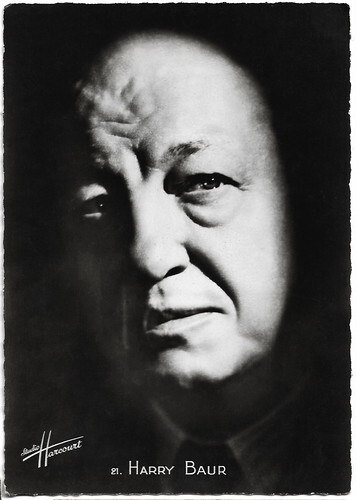
French postcard by Greff Editions, Paris, no. 21. Photo: Studio Harcourt.
Criticised by the right-wing anti-semitic press
While during the mid-1930s Harry Baur had been extremely active, in 1938 he did less, perhaps warned by his attack. That year he completed his cycle of ‘Russian’ films with Maurice Tourneur’s Le patriote/The Mad Emperor (1938), about the last days of the mad Tsar Paul I. Ten years earlier, Ernst Lubitsch had done a silent version with Emil Jannings in the lead, The Patriot (1928), which had won an Academy Award for Best Scenario. In March-April 1939 the exteriors for Jacques de Baroncelli’s film L’homme du Niger/Forbidden Love (1940) were shot in Sudan, under great difficulty. The film was selected for the first Cannes Film Festival of 1939, but because of the war that never took place.
Baur left Sudan to go to Casablanca where Jean Dréville waited for him to perform in Le président Haudecoeur/President Haudecoeur (1940). After that interiors were shot at the studios of Marcel Pagnol. The film came out on French screens on 11 April 1940. When France entered the Second World War most film shooting stopped temporarily. Many actors were mobilised but not all, so work could be done on the film Volpone (Maurice Tourneur, 1940), based on Ben Jonson’s classic text. The German army occupied Paris in June 1940. Film activities were slowed down but theatres reopened, so Baur went to the Théâtre du Gymnase for a reprisal of 'Jazz', directed by Pagnol.
During a large orchestrated campaign from late 1940-early 1941, Harry Baur was heavily criticised by the right-wing anti-semitic press, accusing him of being a Jew and a Freemason. As much as he could Baur explained his Christian roots. The first film produced by Continental Films, the German film company active in France during the war, was L’assassinat du père Noël/The Killing of Santa Claus (Christian Jaque, 1941). Hidden intentions were discovered in the dialogues written by Charles Spaak. Baur had a grand part in the film as père Cornusse, maker of maps of the world. His co-stars were Raymond Rouleau and Renée Faure. In 1941 Tourneur asked Baur a last time for his film Pechés de jeunesse/Sins of Youth.
Then things turned wrong when Baur went to Germany to play the male lead in Symphonie eines Lebens/Symphony of Life (Heinz Bertram, 1942), costarring Henny Porten . The shooting took place from February to May 1942. In the meantime, the French slander of Baur being a Jew reached Goebbels as well and in May 1942 Baur and his second wife were arrested. Baur was questioned, tortured and imprisoned. In September 1942 he was released, weighing just 40 kilos instead of around 100. He never recovered from his torture and died on 8 April 1943 in Paris.
Baur’s funeral took place at the church of St. Philippe du Roule and attracted the 'Tout-Paris' of screen and stage. He was buried at the cimetière Saint-Vincent in Montmartre, where his tomb still attracts visitors. Baur’s wife Rika Radifé survived the German maltreatment. In 1953 she took over the Theatre des Maturins in Paris and ran it for decades.
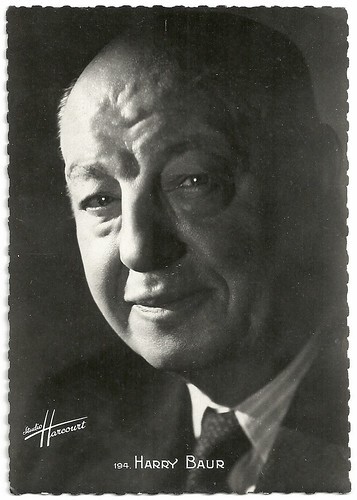
French postcard, no. 194. Photo: Studio Harcourt.
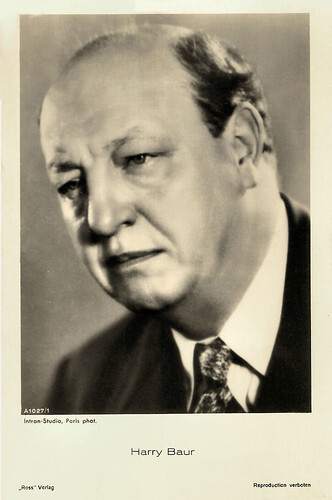
German postcard by Ross Verlag, no. A 1027/1, 1937-1938. Photo: Intran-Studio, Paris.
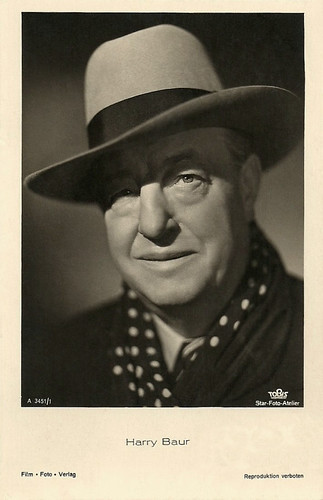
German postcard by Film-Foto-Verlag, no. A 3451/1, 1941-1944. Photo: Tobis Star-Foto-Atelier.
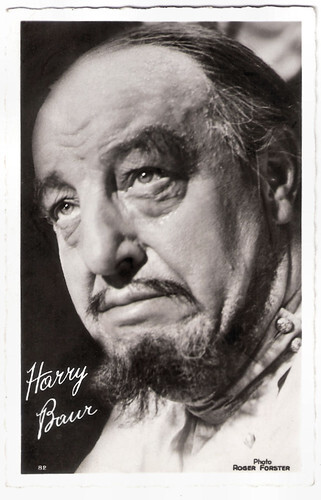
French postcard by Editions et publications cinematographiques, no. 82. Photo: Roger Forster.
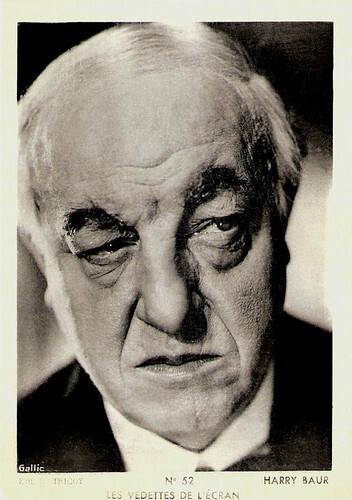
French collectors card by Editions Tricot in the series Les Vedettes de l'écran. Photo: Gallic.
Sources: Filmportal.de, cinememorial, Cinetom (now defunct), Wikipedia (French, German and English), and . CineTom has the most extensive biography, based on Hervé le Boterf’s published biography 'Harry Baur'

French postcard by A.N., Paris, no. 936. Photo: Pathé Natan. Harry Baur as Jean Valjean in Les Misérables (Raymond Bernard, 1934), based on the novel by Victor Hugo.

French postcard by A.N., Paris, no. 6684. Photo: Gaumont-Franco Film-Aubert (G.F.F.A). Harry Baur and Jackie Monnier in David Golder (Julien Duvivier, 1931).

French postcard in the series Nos artistes dans leur loge, no. 202. Photo: Comoedia.

French postcard by A.N., Paris. Photo: Pathé Natan. Publicity still for Les Misérables (Raymond Bernard, 1934).

French postcard by Edition Chantal, Paris. Photo: publicity still for Un Carnet de Bal/Dance Program (Julien Duvivier, 1937).
A man of substance
Henri-Marie Rodolphe Baur, better known as Harry Baur, was born in Paris in 1880. His parents were Catholics from the Alsace; his father came from Mulhouse, and his mother from Bitche en Moselle. They were ruined after theft and had to move to ever more modest dwellings. Baur’s father died when Harry was 10, so his mother and his sister Blanche raised him.
He first did college at Saint-Nazaire. To escape the religious education his family wanted him to take, he fled to Marseille and joined the rugby team of the XVth Olympic Games in Marseille. Here he started studies at the École d'Hydrographie and enrolled in various odd jobs such as peddler, carter, braider of funeral wreaths etc. Slowly he managed to start a career as a stage actor.
As he was refused at the Conservatoire in Paris, he took private lessons. He first enlisted at the Comédie Mondaine in 'Le Filleul du 31'. He then received his first awards for tragedy in 'Le Cid' and for comedy with 'L'Avare' at the Conservatoire in Marseille, while he did military service in Le Mans. He became the secretary of the famous actor-director Mounet-Sully . From 1904 on, he played in numerous Parisian theatres: Comédie Mondaine, Grand Guignolalais-Royal, and Mathurins. Later he also played with Gémier and Antoine.
Because of a beginning facial paralysis, he didn’t have to do service when war broke out in 1914, so he continued to play at the Gaîté-Lyrique, the Ambigu, the Porte Saint-Martin, the Gymnase, the Édouard VII, the Variétés, etc. Baur also collaborated as a film reviewer for 'Crapouillot', under the pseudonym of Orido de Fhair. By the early 1910s, Baur had become not only a man of substance in the diversity of his career, but also physically. Between 1909 and 1914, Harry Baur also performed in almost 30 silent films. He started at Eclair with Beethoven (Victorin Jasset, 1908) from 1909 on he worked at Pathé as well, a.o. in the Vidoq films (1909-1911), and the Film d’Art films such as L’Assommoir/Drink (Albert Capellani, 1909) after Émile Zola . At Eclair he worked a.o. with director Maurice Tourneur in Monsieur Lecoq/Mr. Lecoq (1914).
With Mistinguett , Baur played in Fleur de Paris/Flower of Paris (André Hugon, 1916) and Chignon d’or/The Gold Chignon (André Hugon, 1916), and with Albert Dieudonné in Sous la griffe/Under the label (Albert Dieudonné, 1921). In La voyante/The Clairvoyant (Leon Abrams, Louis Mercanton, 1923) he played opposite the legendary Sarah Bernhardt . Between 1924 and the arrival of French sound film Baur was away from the screen and focused on the stage. In 1910 he married actress Rose Cremer, known as Rose Grande, and they had three children. In 1931 Rose died during a trip to Algeria. Baur then married Rika Radifé, a stage actress as well, and of Turkish origin (her real name was Rebecca Behar).

French postcard by Editions et Publications cinématographigues (EPC), no. 81.

French postcard by Editions E.C., Paris, no. 2. Photo: G.L. Manuel Frères, Paris.

French postcard by EC, no. 2. Photo: Pathé-Natan.
Baur’s most important director during the 1930s
In 1931 Harry Baur had a triumph on stage with his interpretation of César in Marcel Pagnol’s play 'Fanny', the sequel to his 'Marius'. Baur had substituted the great Raimu in this role and would become a fierce competitor to the actor all through the 1930s, both on stage and on screen. Earlier in 1931, one of Baur’s first sound films had been released, the drama David Golder, directed by Julien Duvivier, who supposedly had brought Baur back to the screen. Duvivier would become Baur’s most important director during the 1930s. The timing of David Golder is not entirely clear, as in 1931 Baur also went to London to act in an early French talkie shot there at British International Pictures: the multilingual Le cap perdu (Ewald André Dupont, 1931). Le cap perdu/Cape Forlorn was quickly forgotten, but David Golder was a huge success in France at the time. The film about a betrayed Jewish banker was almost shot like a silent film at the Basque Coast. It was a clever streak of Duvivier to relaunch Harry Baur as a film actor with this topic. Baur had already been successful in a stage version at the Théâtre de la Porte Saint-Martin in Paris.
In March 1931, when David Golder was released in France, Baur started production for Le juif polonais/Polish Jew (Jean Kemm, 1931), about a man who is haunted by his murder. The film was especially created for Baur to excel but it wasn’t as lucrative as David Golder. After this followed Criminel/Criminal (Jack Forrester, 1932), an alternate language version of The Criminal Code (Howard Hawks, 1931). Baur played a prison warden, while Jean Servais made his film debut as an innocently condemned young man who is involved in a crime within the prison.
After this, Baur played in three films by Julien Duvivier. The first was Les cinq gentlemen maudits/Moon Over Morocco (1932) with René Lefèvre and Robert Le Vigan . Parallel Duvivier shot a German version with Adolf Wohlbruck , Camilla Horn and Jack Trevor . Exteriors were shot at Fez, Marrakech and Moulay-Idriss. The press praised Duvivier’s taste for atmosphere, picturesque and exoticism. Next was the adaptation of Jules Renard’s novel Poil de Carotte/The Red Head (Julien Duvivier, 1932), with Baur as the unforgettable Monsieur Lepic next to the young Robert Lynen (Both actors would share the same, tragic destiny, as Lynen was a member of the Resistance in the war, was imprisoned in 1943 and executed by the Germans in 1944). For his sound version of Poil de Carotte, Duvivier borrowed from other works of Renard as well, such as 'La Bigote' (The Bigote). In 1926 Duvivier had already made a silent version with André Heuzé as Poil de Carotte and Henry Krauss as M. Lepic. Baur had a very precise idea of how to play Lepic and was a perfectionist in his creation. Poil de Carotte had a prosperous release in Paris in 1932, with praise for Harry Baur.
Not wanting to let go of his star, Duvivier had him play commissaire Jules Maigret in La tête d’un homme/A Man's Neck (Julien Duvivier, 1932). While author Georges Simenon thought at the time that Baur was too old for the part and too tragic, the film is now considered one of the best adaptations of Simenon's novels. In 1932 Baur played Monsieur de Tréville, captain of the King’s guards in a very florishing sound version of Les trois mousquetaires/The Three Musketeers (1932). A decade earlier, director Henri Diamant-Berger had done a silent version, a serial in 12 episodes. Now it was a two-part sound version, entitled Les ferrets de la reine/The Queen's Studs and Milady.
Baur was coupled with Pierre Blanchar in Cette vieille canaille/The Old Devil (Anatole Litvak, 1933). While Baur did not convince as a clochard who is a distant relative of the Rothschild family in Rotchild (Marco de Gastyne, 1933), he came back full fling as Jean Valjean in Les Misérables (Raymond Bernard, 1933), an adaptation of Victor Hugo ’s classic novel. Costars were Charles Vanel as Javert and Josseline Gael as Cosette. Because of its length, the film was released in two parts. It became Baur’s best film performance and some say the best film interpretation of Hugo’s famous character. Because of the European success, Baur received offers from Hollywood, but he didn’t want to leave Paris and declined.

Dutch postcard. Photo: Fim Film, Amsterdam. Harry Baur in Poil de carotte/The Red Head (Julien Duvivier, 1932).
 br />Dutch postcard. Photo: Filmex, Amsterdam. Madeleine Guitty and Harry Baur in Cette vieille canaille/The Old Devil (Anatole Litvak, 1933).
br />Dutch postcard. Photo: Filmex, Amsterdam. Madeleine Guitty and Harry Baur in Cette vieille canaille/The Old Devil (Anatole Litvak, 1933).
French postcard by A.N. Paris, no. 941. Photo Pathé Natan. Harry Baur as Jean Valjean and Max Dearly as Gillenormand in Les Misérables (Raymond Bernard, 1934).
A remake of an expressionist classic
After two lesser films, Harry Baur was back with Les nuits moscovites/Moscow Nights (Alexis Granowski, 1934), also the debut of Neapolitan singer-actor Tino Rossi . Harry Baur played a course, rich Russian wheat trader, opposite Annabella and Pierre-Richard Wilm . The success of the film caused producers to offer Baur one ‘Russian’ film after another. At the time films shot by and featuring fled White Russians were popular in France. After that it is time to play Herod in Golgotha (Julien Duvivier, 1935), co-starring Jean Gabin as Pontius Pilate, Robert le Vigan as Jesus and Edwige Feuillère as Claudia Procula.
General Production offered Baur the part of Judge Porphyre in Crime et chatiment/Crime and Punishment (Pierre Chenal, 1935), based on Dostoievski’s novel. The confrontation between Baur and his costar Pierre Blanchar was the climax of this thriving film, which launched the career of Chenal in the 1930s. The sets of the film were highly stylized, inspired by German Expressionism. This might have inspired Duvivier to do a remake of the Expressionist classic Der Golem by Paul Wegener : Le Golem/The Golem (Julien Duvivier, 1935), with Baur playing Emperor Rudolph and with shooting at studios in Prague, where the story takes place. Baur then went to London for an English version of Nuits moscovites, Moscow Nights (Anthony Asquith, 1935) with a young Laurence Olivier .
Maurice Tourneur, with whom Baur had worked together in the 1910s, then shot Samson (1936), a modern drama based on a play by Henry Bernstein. It had already been adapted for the silent cinema and involved adultery and the power of money. Gaby Morlay and Baur were the central couple whose silences were as telling as their words. Then it was imperial Russia time again with Les yeux noirs/Black Eyes (Viktor Tourjansky, 1936) with Baur and Simone Simon , before moving over to the Hungarian steppes for Tarass Boulba/Taras Bulba (Alexis Granowsky, 1936), based on Gogol’s novel. It was both critically and commercially Baur’s biggest success since Les Misérables. The wild and intense Boulba matched Baur perfectly and his performance impressed audiences. For Les hommes nouveaux/The New Men (1936), director Marcel L’Herbier shot the first documentary part on the pacification of Morocco with actor Gabriel Signoret made up as marshal Lyautey, whom all thought had a striking resemblance. Baur had a supporting part as Maurice de Tolly, inspector general. While the film was a clear colonial product, L’Herbier’s most important drive was to ignite the fire of national patriotism in light of the growing German military force. A young Jean Marais had one of his first roles here.
Abel Gance gave Baur a great part in the title role of Un grand amour de Beethoven (1936), a character that Baur already had played in his first film. After a break in Italy, Duvivier asked Baur to play a man turned Dominican monk in his well-known bitter film Un carnet de bal/Dance Program (Julien Duvivier, 1937). In the film, a young widow ( Marie Bell ) revisits the dancers from her old booklet, but they are all disappointments. The film was a worldwide success and was awarded the Coppa Mussolini for best foreign film in Venice. Next Baur took the boat to Algeria for the shooting of Sarati le Terrible/Sarati the Terrible (André Hugon, 1937) in which Baur played a sordid brute, who rules the underworld of the docks in Algiers. He remained within the exotic with his part of an Arabian sheikh in West Africa in Les secrets de la Mer Rouge/Secrets of the Red Sea (Richard Pottier, 1937).
Mollenard/Hatred (Robert Siodmak, 1938) was set in Shanghai but shot at Dunkerque, with the help of set designer Alexandre Trauner. Mollenard was one of the finest films of the era and meant another memorable part for Baur. Young Robert Lynen again played his son. Director Siodmak faced many problems during the making of this film: he lost good money over competition with Duvivier on the adaptation rights, he had trouble finding producers, and at the start of shooting Baur had a heart attack, though without consequences. La tragédie impériale/Rasputin (Marcel L'Herbier, 1938) was about the life of Rasputin and his power during the reign of the last Tsar Nicolas II. Baur had made considerable study of his character; he also wore false high heels in his shoes and lost considerable weight to look more like his character.

French postcard by Eclair Journal, no. 570. Photo: Mega Film Harry Baur as a submarine commander in Nitchevo (Jacques de Baroncelli, 1936). Eclair Journal was the distributor of the film.

French postcard by P.C., no. 171. Photo: France Presse.

French card.

French postcard by Greff Editions, Paris, no. 21. Photo: Studio Harcourt.
Criticised by the right-wing anti-semitic press
While during the mid-1930s Harry Baur had been extremely active, in 1938 he did less, perhaps warned by his attack. That year he completed his cycle of ‘Russian’ films with Maurice Tourneur’s Le patriote/The Mad Emperor (1938), about the last days of the mad Tsar Paul I. Ten years earlier, Ernst Lubitsch had done a silent version with Emil Jannings in the lead, The Patriot (1928), which had won an Academy Award for Best Scenario. In March-April 1939 the exteriors for Jacques de Baroncelli’s film L’homme du Niger/Forbidden Love (1940) were shot in Sudan, under great difficulty. The film was selected for the first Cannes Film Festival of 1939, but because of the war that never took place.
Baur left Sudan to go to Casablanca where Jean Dréville waited for him to perform in Le président Haudecoeur/President Haudecoeur (1940). After that interiors were shot at the studios of Marcel Pagnol. The film came out on French screens on 11 April 1940. When France entered the Second World War most film shooting stopped temporarily. Many actors were mobilised but not all, so work could be done on the film Volpone (Maurice Tourneur, 1940), based on Ben Jonson’s classic text. The German army occupied Paris in June 1940. Film activities were slowed down but theatres reopened, so Baur went to the Théâtre du Gymnase for a reprisal of 'Jazz', directed by Pagnol.
During a large orchestrated campaign from late 1940-early 1941, Harry Baur was heavily criticised by the right-wing anti-semitic press, accusing him of being a Jew and a Freemason. As much as he could Baur explained his Christian roots. The first film produced by Continental Films, the German film company active in France during the war, was L’assassinat du père Noël/The Killing of Santa Claus (Christian Jaque, 1941). Hidden intentions were discovered in the dialogues written by Charles Spaak. Baur had a grand part in the film as père Cornusse, maker of maps of the world. His co-stars were Raymond Rouleau and Renée Faure. In 1941 Tourneur asked Baur a last time for his film Pechés de jeunesse/Sins of Youth.
Then things turned wrong when Baur went to Germany to play the male lead in Symphonie eines Lebens/Symphony of Life (Heinz Bertram, 1942), costarring Henny Porten . The shooting took place from February to May 1942. In the meantime, the French slander of Baur being a Jew reached Goebbels as well and in May 1942 Baur and his second wife were arrested. Baur was questioned, tortured and imprisoned. In September 1942 he was released, weighing just 40 kilos instead of around 100. He never recovered from his torture and died on 8 April 1943 in Paris.
Baur’s funeral took place at the church of St. Philippe du Roule and attracted the 'Tout-Paris' of screen and stage. He was buried at the cimetière Saint-Vincent in Montmartre, where his tomb still attracts visitors. Baur’s wife Rika Radifé survived the German maltreatment. In 1953 she took over the Theatre des Maturins in Paris and ran it for decades.

French postcard, no. 194. Photo: Studio Harcourt.

German postcard by Ross Verlag, no. A 1027/1, 1937-1938. Photo: Intran-Studio, Paris.

German postcard by Film-Foto-Verlag, no. A 3451/1, 1941-1944. Photo: Tobis Star-Foto-Atelier.

French postcard by Editions et publications cinematographiques, no. 82. Photo: Roger Forster.

French collectors card by Editions Tricot in the series Les Vedettes de l'écran. Photo: Gallic.
Sources: Filmportal.de, cinememorial, Cinetom (now defunct), Wikipedia (French, German and English), and . CineTom has the most extensive biography, based on Hervé le Boterf’s published biography 'Harry Baur'
Published on September 12, 2023 22:00
September 11, 2023
Aud's sisters: Gerd Egede-Nissen and Ada van Ehlers
Last week, EFSP did a post on Norwegian silent film star Aud Egede-Nissen, who had an impressive career in German cinema in films by Ernst Lubitsch and other great directors. Her two lesser-known sisters, Gerd Egede-Nissen (1895-1988) and Ada Nissen (1899-1981) a.k.a. Ada van Ehlers, both also worked in the film industry. Gerd was an actress and director who also became a recognised resistance fighter during the Second World War. Ada's stage and film career spanned more than six decades.
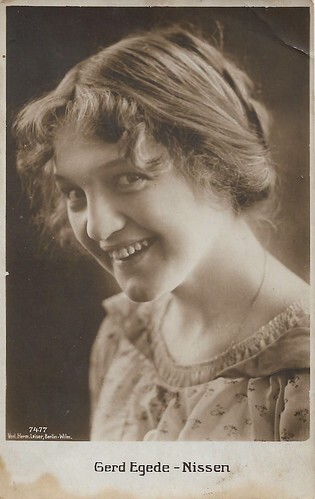
German postcard by Verlag Hermann Leiser, Berlin, no. 7477. Gerd Egede-Nissen.
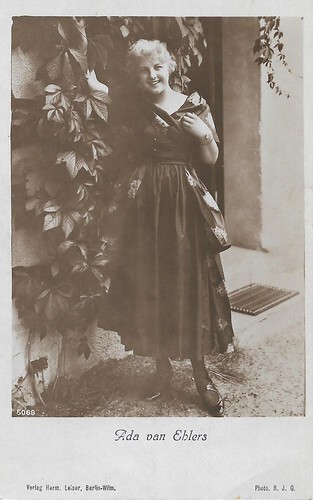
German postcard by Verlag Hermann Leiser, no. 5069. Photo: B.J.G. Ada van Ehlers.
Gerd Egede-Nissen
Gerd Egede-Nissen, later Gerd Grieg was born in 1895 in Bergen, Norway. Gerd was the daughter of NKP leader Adam Egede-Nissen and Goggi Egede-Nissen. She was the sister of actors Aud Richter (née Aud Egede-Nissen), Ada Kramm (née Ada Egede-Nissen ), Oscar Egede-Nissen, Stig Egede-Nissen, Lill Egede-Nissen, and Gøril Havrevold (née Gøril Egede-Nissen). Gerd made her debut at the National Theatre at the age of 15 in 1910, as Lersol in the fairytale play 'The King's Heart'. She made an immediate breakthrough and played a number of major roles on the main stage until 1917. In 1912-1913 she appeared in four short silent films made by the Danish August Blom, while in 1916 she acted in Holger-Madsen's crime film Den hvide Djævel.
In 1917 she started a five-year career in Berlin to make films for her sister Aud Egede-Nissen 's film company, in which Aud's husband Georg Alexander was involved. She was presented as Gerd Nissen. Yet, only a few films were made such as Die Rachegöttin (Georg Alexander, 1918), while it is unclear if she or her sister Aud had the lead in another film, Die Jugendsünde (Georg Alexander, 1918). She also acted in the Danish film En Fare for Samfundet (1918), with Valdemar Psilander , released after his death in 1917. Gerd returned to Norway in 1922, did only one last film there, Pan (Harald Schwenzen, 1922), and married. Now called Gerd Grieg, she had guest appearances at various theatres before returning to the National Theatre in 1928. She also had several guest appearances abroad, most notably at the Royal Theatre in Copenhagen in 1933 and 1946.
Gerd Grieg was one of the most important Henrik Ibsen actors of her generation, playing leading roles such as Hedda, Hilde Wangel, Irene, Svanhild, Ella Rentheim and Rebekka West. She was also a great Bjørnson interpreter, portraying characters such as Birgit Rømer and Tora Parsberg. In 1937 she gave a strong interpretation of Lucretia in Holberg's 'The Recalcitrant'. Grieg also played Schiller's 'Maria Stuart', Viola in Shakespeare's 'Twelfth Night', the title roles in Kjeld Abell's 'Anna Sophie Hedvig' and Amalie Skram's 'Agnete', as well as taking on demanding operetta roles such as Rosalinde in 'The Bat' and Hanna Glawari in 'The Merry Widow'. Gerd Grieg also staged plays, including five plays at the Icelandic National Theatre Þjóðleikhúsið, which was inaugurated in 1950.
From 1922 to 1940 Gerd Egede-Nissen was married to the surgeon Ragnvald Ingebrigtsen (1882-1975), who was much older. She gained a reputation as the femme fatale of Norwegian theatre, and her name was linked to several more or less piquant "society scandals" in the interwar period. Her relationship with her colleague Odd Frogg (1901-34) culminated in his suicide by jumping off a roof and leaving behind a piece of paper labelled "G.E.N.I.", which may have stood for "Gerd Egede-Nissen Ingebrigtsen".
From New Year 1935, Gerd had been dating the writer and later resistance fighter Nordahl Grieg (1902-1943), whom she had known since 1931. After divorcing the surgeon, the two married in 1940, but Grieg died in 1943 when the bomber he was travelling in was shot down over Berlin. Gerd and Nordahl had previously met Franklin D. Roosevelt in the United States. Gerd remained active in the Norwegian resistance movement in London and Iceland during World War II. Wartime nerves and the loss of her husband meant that after the war she only performed sporadically as an actress and director. She retired from the stage in 1955 and in 1957 published a book about her life with her husband: 'Nordahl Grieg as I Knew Him'. Gerd Egede-Nissen passed away in 1988.
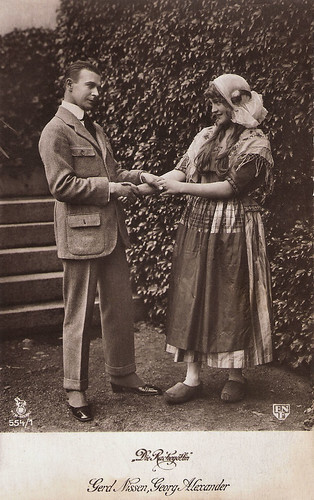
German postcard by Rotophot in the Film Sterne series, no. 554/1. Photo: ENF (Egede-Nissen-Film). Gerd Egede-Nissen and Georg Alexander in the German silent film Die Rachegöttin (Georg Alexander, 1918).
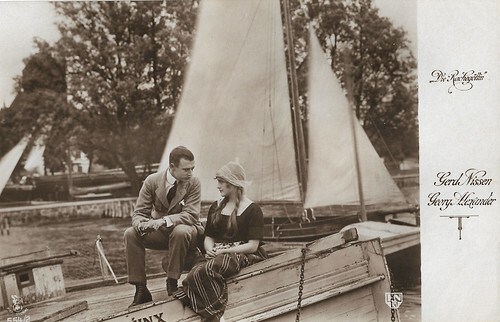
German postcard by Rotophot in the Film Sterne series, no. 554/2. Photo: ENF (Egede-Nissen-Film). Gerd Egede-Nissen and Georg Alexander in the German silent film Die Rachegöttin (Georg Alexander, 1918), produced by Egede-Nissen-Film, the company for which Aud Egede Nissen was the producer. Gerd Egede-Nissen aka Gerd Nissen was her sister. The film was shot at Waren/Mecklenburg and at the Fern Andra-Atelier studios in Berlin, Chausseestrasse.
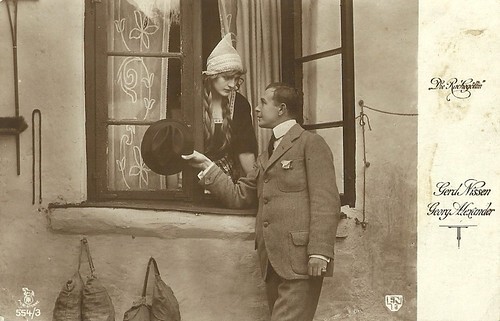
German postcard by Rotophot in the Film Sterne series, no. 554/3. Photo: ENF (Egede-Nissen-Film). Gerd Egede-Nissen and Georg Alexander in Die Rachegöttin (Georg Alexander, 1918).
Ada van Ehlers
Ada van Ehlers or Ada Kramm was born Ada Egede-Nissen in 1899 in Vardø, Finnmark, Norway. Six of her ten siblings, Aud Egede-Nissen , Gerd Grieg, Oscar Egede-Nissen, Stig Egede-Nissen, Lill Egede-Nissen and Gøril Havrevold, all became stage and film actors. When she was eleven years old, the family moved to Stavanger, where she began studying at the Stavanger Faste Scene (Stavanger Fixed Scene) theatre.
Ada Egede-Nissen made her stage début in 1916 in Selma Lagerlöf 's 'Dunungen'. In 1917, Kramm accompanied her two older sisters Aud and Gerd to Berlin, Germany where the three young women opened a small film production and distribution company called the Egede-Nissen Film Company (ENF). The trio used the studio to promote themselves in film roles directed by Georg Alexander from 1917 until 1920.
Ada appeared in a number of crime serials as Ada van Ehlers beginning in 1917, e.g. Ein Detektiv-Duell (Georg Alexander, 1917), Verkauftes Glück (Georg Alexander, 1918), and Erblich belastet (1919). All in all, she starred in eight films by Georg Alexander , almost always with the director himself as the male lead. In 1920 she married German violinist Hugo Kramm and started using her married name as a professional moniker and the young newly-weds returned to Norway. They later had a daughter together, actress Ilse Kramm (born 1934).
From 1921 until 1924 Kramm appeared at the Bergen and Den Nationale Scene. After her husband joined the Oslo Philharmonic Orchestra in 1924 they moved to Oslo and she worked at Det Nye Teater (The New Theatre) from 1925 until 1928, the Centralteatret (Central Theatre) from 1928 to 1934 and later at the Nationaltheatret (National Theatre). She also returned to film and appeared in roles in the Norwegian-German coproduction Schneeschuhbanditen/Snowshoe Bandits (Uwe Jens Krafft, 1928) opposite her sister Aud and Austrian actor Paul Richter and the film Eskimo (George Schnéevoigt, 1930), opposite Mona Mårtenson and again Paul Richter . The latter film was the first Norwegian sound film spoken in Norwegian, even if it was a Danish-Norwegian co-production. In 1932 a German version of Eskimo was released as Der weiße Gott, while also a French version was made.
Kramm spent the next several decades on Norwegian stages in productions by Henrik Ibsen, August Strindberg, Tennessee Williams and Arthur Miller. At age 72, she appeared in the role of Aunt Julie in 'Hedda Gabler' on a tour of Japan. After over six decades on stage, she went into semi-retirement and occasionally made appearances on Norwegian television. Her last role before her death was in the Palme d'Or nominated dramatic film Arven/Heritage (Anja Breien, 1978) with Espen Skjønberg, Anita Björk and Jan Hårstad. Ada Kramm died in 1981 in Oslo at age eighty-two and was buried in the Vestre Gravlund cemetery.
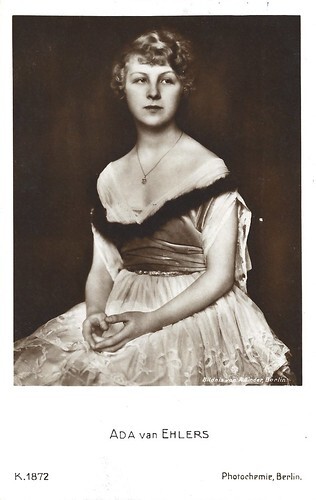
German postcard by Photochemie, no. K. 1872. Photo: Alex Binder, Berlin.
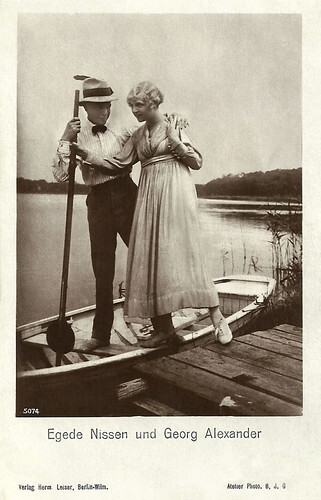
German postcard by Verlag Hermann Leiser, Berlin, no. 5074. Photo: Atelier B.J.G. Georg Alexander and Gerd or Aud Egede-Nissen .
Sources: Wikipedia (Norwegian and English), and Filmportal.

German postcard by Verlag Hermann Leiser, Berlin, no. 7477. Gerd Egede-Nissen.

German postcard by Verlag Hermann Leiser, no. 5069. Photo: B.J.G. Ada van Ehlers.
Gerd Egede-Nissen
Gerd Egede-Nissen, later Gerd Grieg was born in 1895 in Bergen, Norway. Gerd was the daughter of NKP leader Adam Egede-Nissen and Goggi Egede-Nissen. She was the sister of actors Aud Richter (née Aud Egede-Nissen), Ada Kramm (née Ada Egede-Nissen ), Oscar Egede-Nissen, Stig Egede-Nissen, Lill Egede-Nissen, and Gøril Havrevold (née Gøril Egede-Nissen). Gerd made her debut at the National Theatre at the age of 15 in 1910, as Lersol in the fairytale play 'The King's Heart'. She made an immediate breakthrough and played a number of major roles on the main stage until 1917. In 1912-1913 she appeared in four short silent films made by the Danish August Blom, while in 1916 she acted in Holger-Madsen's crime film Den hvide Djævel.
In 1917 she started a five-year career in Berlin to make films for her sister Aud Egede-Nissen 's film company, in which Aud's husband Georg Alexander was involved. She was presented as Gerd Nissen. Yet, only a few films were made such as Die Rachegöttin (Georg Alexander, 1918), while it is unclear if she or her sister Aud had the lead in another film, Die Jugendsünde (Georg Alexander, 1918). She also acted in the Danish film En Fare for Samfundet (1918), with Valdemar Psilander , released after his death in 1917. Gerd returned to Norway in 1922, did only one last film there, Pan (Harald Schwenzen, 1922), and married. Now called Gerd Grieg, she had guest appearances at various theatres before returning to the National Theatre in 1928. She also had several guest appearances abroad, most notably at the Royal Theatre in Copenhagen in 1933 and 1946.
Gerd Grieg was one of the most important Henrik Ibsen actors of her generation, playing leading roles such as Hedda, Hilde Wangel, Irene, Svanhild, Ella Rentheim and Rebekka West. She was also a great Bjørnson interpreter, portraying characters such as Birgit Rømer and Tora Parsberg. In 1937 she gave a strong interpretation of Lucretia in Holberg's 'The Recalcitrant'. Grieg also played Schiller's 'Maria Stuart', Viola in Shakespeare's 'Twelfth Night', the title roles in Kjeld Abell's 'Anna Sophie Hedvig' and Amalie Skram's 'Agnete', as well as taking on demanding operetta roles such as Rosalinde in 'The Bat' and Hanna Glawari in 'The Merry Widow'. Gerd Grieg also staged plays, including five plays at the Icelandic National Theatre Þjóðleikhúsið, which was inaugurated in 1950.
From 1922 to 1940 Gerd Egede-Nissen was married to the surgeon Ragnvald Ingebrigtsen (1882-1975), who was much older. She gained a reputation as the femme fatale of Norwegian theatre, and her name was linked to several more or less piquant "society scandals" in the interwar period. Her relationship with her colleague Odd Frogg (1901-34) culminated in his suicide by jumping off a roof and leaving behind a piece of paper labelled "G.E.N.I.", which may have stood for "Gerd Egede-Nissen Ingebrigtsen".
From New Year 1935, Gerd had been dating the writer and later resistance fighter Nordahl Grieg (1902-1943), whom she had known since 1931. After divorcing the surgeon, the two married in 1940, but Grieg died in 1943 when the bomber he was travelling in was shot down over Berlin. Gerd and Nordahl had previously met Franklin D. Roosevelt in the United States. Gerd remained active in the Norwegian resistance movement in London and Iceland during World War II. Wartime nerves and the loss of her husband meant that after the war she only performed sporadically as an actress and director. She retired from the stage in 1955 and in 1957 published a book about her life with her husband: 'Nordahl Grieg as I Knew Him'. Gerd Egede-Nissen passed away in 1988.

German postcard by Rotophot in the Film Sterne series, no. 554/1. Photo: ENF (Egede-Nissen-Film). Gerd Egede-Nissen and Georg Alexander in the German silent film Die Rachegöttin (Georg Alexander, 1918).

German postcard by Rotophot in the Film Sterne series, no. 554/2. Photo: ENF (Egede-Nissen-Film). Gerd Egede-Nissen and Georg Alexander in the German silent film Die Rachegöttin (Georg Alexander, 1918), produced by Egede-Nissen-Film, the company for which Aud Egede Nissen was the producer. Gerd Egede-Nissen aka Gerd Nissen was her sister. The film was shot at Waren/Mecklenburg and at the Fern Andra-Atelier studios in Berlin, Chausseestrasse.

German postcard by Rotophot in the Film Sterne series, no. 554/3. Photo: ENF (Egede-Nissen-Film). Gerd Egede-Nissen and Georg Alexander in Die Rachegöttin (Georg Alexander, 1918).
Ada van Ehlers
Ada van Ehlers or Ada Kramm was born Ada Egede-Nissen in 1899 in Vardø, Finnmark, Norway. Six of her ten siblings, Aud Egede-Nissen , Gerd Grieg, Oscar Egede-Nissen, Stig Egede-Nissen, Lill Egede-Nissen and Gøril Havrevold, all became stage and film actors. When she was eleven years old, the family moved to Stavanger, where she began studying at the Stavanger Faste Scene (Stavanger Fixed Scene) theatre.
Ada Egede-Nissen made her stage début in 1916 in Selma Lagerlöf 's 'Dunungen'. In 1917, Kramm accompanied her two older sisters Aud and Gerd to Berlin, Germany where the three young women opened a small film production and distribution company called the Egede-Nissen Film Company (ENF). The trio used the studio to promote themselves in film roles directed by Georg Alexander from 1917 until 1920.
Ada appeared in a number of crime serials as Ada van Ehlers beginning in 1917, e.g. Ein Detektiv-Duell (Georg Alexander, 1917), Verkauftes Glück (Georg Alexander, 1918), and Erblich belastet (1919). All in all, she starred in eight films by Georg Alexander , almost always with the director himself as the male lead. In 1920 she married German violinist Hugo Kramm and started using her married name as a professional moniker and the young newly-weds returned to Norway. They later had a daughter together, actress Ilse Kramm (born 1934).
From 1921 until 1924 Kramm appeared at the Bergen and Den Nationale Scene. After her husband joined the Oslo Philharmonic Orchestra in 1924 they moved to Oslo and she worked at Det Nye Teater (The New Theatre) from 1925 until 1928, the Centralteatret (Central Theatre) from 1928 to 1934 and later at the Nationaltheatret (National Theatre). She also returned to film and appeared in roles in the Norwegian-German coproduction Schneeschuhbanditen/Snowshoe Bandits (Uwe Jens Krafft, 1928) opposite her sister Aud and Austrian actor Paul Richter and the film Eskimo (George Schnéevoigt, 1930), opposite Mona Mårtenson and again Paul Richter . The latter film was the first Norwegian sound film spoken in Norwegian, even if it was a Danish-Norwegian co-production. In 1932 a German version of Eskimo was released as Der weiße Gott, while also a French version was made.
Kramm spent the next several decades on Norwegian stages in productions by Henrik Ibsen, August Strindberg, Tennessee Williams and Arthur Miller. At age 72, she appeared in the role of Aunt Julie in 'Hedda Gabler' on a tour of Japan. After over six decades on stage, she went into semi-retirement and occasionally made appearances on Norwegian television. Her last role before her death was in the Palme d'Or nominated dramatic film Arven/Heritage (Anja Breien, 1978) with Espen Skjønberg, Anita Björk and Jan Hårstad. Ada Kramm died in 1981 in Oslo at age eighty-two and was buried in the Vestre Gravlund cemetery.

German postcard by Photochemie, no. K. 1872. Photo: Alex Binder, Berlin.

German postcard by Verlag Hermann Leiser, Berlin, no. 5074. Photo: Atelier B.J.G. Georg Alexander and Gerd or Aud Egede-Nissen .
Sources: Wikipedia (Norwegian and English), and Filmportal.
Published on September 11, 2023 22:00
September 10, 2023
Julie Andrews
English film and stage actress, singer, and author Julie Andrews (1935) was a former child actress and singer who rose to prominence starring in such stage musicals as My Fair Lady and Camelot. She is best known for her roles in the films Mary Poppins (1964) and The Sound of Music (1965). Her voice spanned four octaves until it was damaged by a throat operation in 1997. In the 2000s she had a major revival of her film career in family films like The Princess Diaries (2001) and the Shrek animated films (2004–2010).
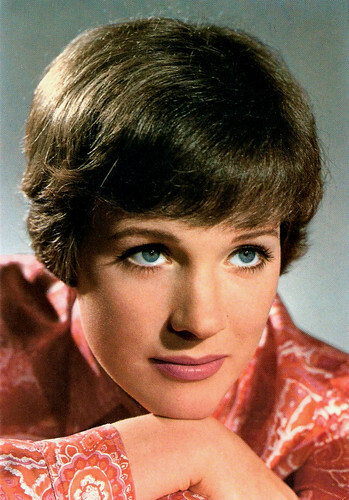
Italian postcard by Rotalcolor, Milano, no. 299.
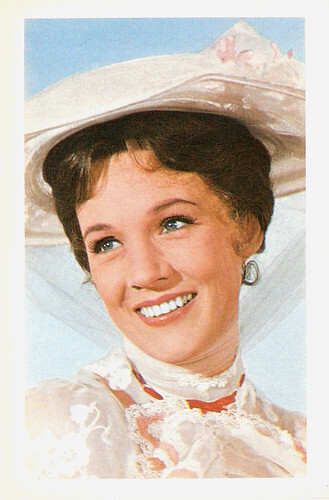
Vintage postcard. Photo: still from Mary Poppins (1964).
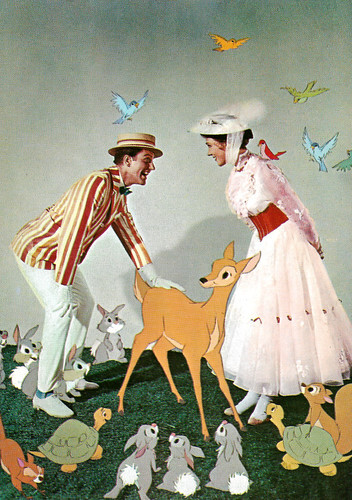
French postcard by Les Presses de Belleville, Paris, no. 105. Photo: Walt Disney Productions. Julie Andrews and Dick Van Dyke in Mary Poppins (Robert Stevenson, 1964). Caption: The film that won 5 Oscars.
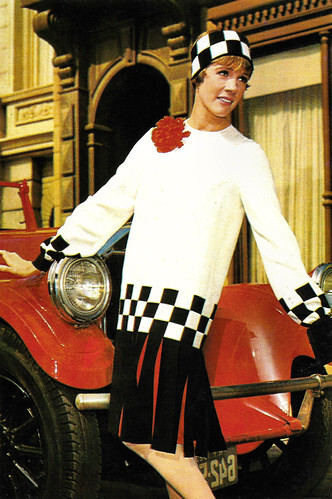
Romanian postcard by Casa Filmului Acin, no. 191. Julie Andrews in Thoroughly Modern Millie (George Roy Hill, 1967).
Big break
Julie Andrews was born Julia Elizabeth Wells in Walton-on-Thames, England, in 1935. Her mother, music hall performer Barbara Wells (née Morris), was married to Edward C. ‘Ted’ Wells, a teacher of metal and woodworking, but Andrews was conceived as a result of an affair her mother had with a family friend. With the outbreak of World War II, Barbara and Ted Wells went their separate ways. Ted Wells assisted with evacuating children to Surrey during the Blitz, while Barbara joined Ted Andrews in entertaining the troops. Barbara and Ted Wells were soon divorced and Barbara remarried to Ted Andrews in 1939.
Julie had lessons at the Cone-Ripman School, an independent arts educational school in London, and with the famous concert soprano and voice instructor Lilian Stiles-Allen. She continued her academic education at the Woodbrook School, a local state school in Beckenham. Julie performed spontaneously and unbilled on stage with her parents for about two years beginning in 1945.
She got her big break when her stepfather introduced her to Val Parnell, whose Moss Empires controlled prominent venues in London. Andrews made her professional solo debut at the London Hippodrome singing the difficult aria Je Suis Titania from Mignon as part of a musical revue called 'Starlight Roof' in 1947. She played the Hippodrome for one year.
In 1948 she became the youngest solo performer ever to be seen in a Royal Command Variety Performance. Julie followed her parents into radio and television and reportedly made her television debut on the BBC program 'RadiOlympia Showtime' in 1949. She garnered considerable fame throughout the United Kingdom for her work on the BBC radio comedy show Educating Archie (1950- 1952).
In 1954 on the eve of her 19th birthday, Julie Andrews made her Broadway debut portraying 1920s flapper Polly Browne in the already highly successful London musical 'The Boy Friend'. To the critics, Andrews was the stand-out performer in the show. In November 1955 Andrews was signed to appear with Bing Crosby in what is regarded as the first made-for-television movie, High Tor.
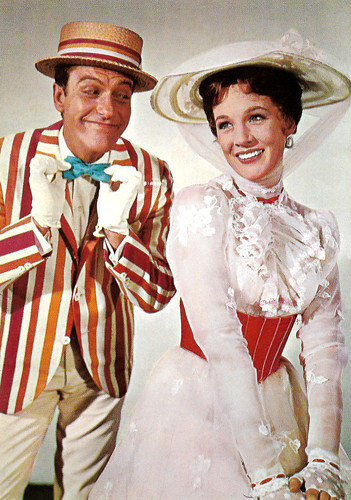
French postcard by Les Presses de Belleville, no. 101. Photo: Walt Disney Productions. Julie Andrews and Dick Van Dyke in Mary Poppins (Robert Stevenson, 1964).
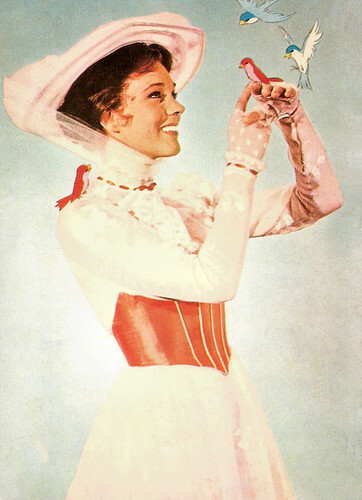
French postcard by Les Presses de Belleville, no. 107. Photo: Walt Disney Productions. Still from Mary Poppins (1964).
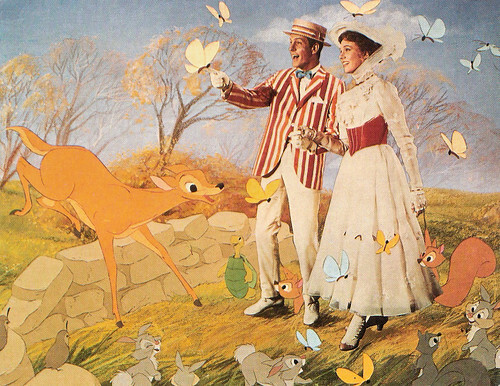
French postcard. Photo: Walt Disney Productions. Julie Andrews and Dick Van Dyke in Mary Poppins (Robert Stevenson, 1964).
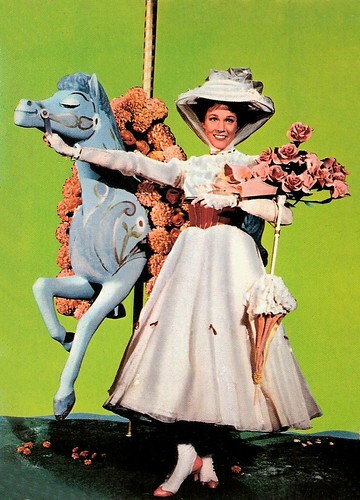
Spanish postcard by Ediciones Tarje Fher / Ediciones Mandolina, 1964. Photo: Walt Disney Productions. Still from Mary Poppins (1964).
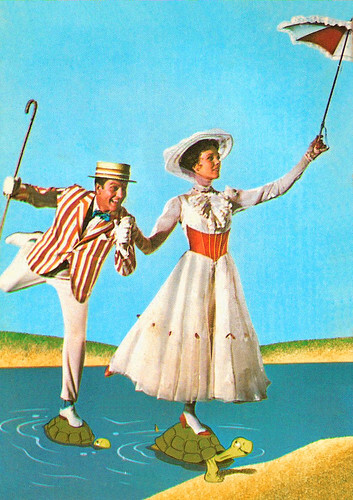
Spanish postcard by Ediciones Tarje Fher / Ediciones Mandolina, 1964. Photo: Walt Disney Productions. Still from Mary Poppins (1964) with Dick van Dyke.
Oscars and Golden Globes
In 1956 Julie Andrews appeared in the Frederick Loewe and Alan Jay Lerner musical 'My Fair Lady' as Eliza Doolittle to Rex Harrison 's Henry Higgins. Producer Moss Hart had mercilessly drilled her for 48 hours to help her get her lines, songs and dialect in proper working order. Richard Rodgers was so impressed with her talent that concurrent with her run in My Fair Lady she was featured in the Rodgers and Hammerstein television musical, Cinderella (Ralph Nelson, 1957). Cinderella was broadcast live and attracted an estimated 107 million viewers.
She married set designer Tony Walton in 1959 in Weybridge, Surrey. They had first met in 1948 when Andrews was appearing at the London Casino in the show Humpty Dumpty. The couple filed for a divorce in 1967.
Alan Jay Lerner and Frederick Loewe - also the composers of My Fair Lady - developed the role of Queen Guinevere in their musical Camelot (1960) with Andrews in mind. The result, Camelot, with Richard Burton , was another Broadway triumph However, studio head Jack Warner decided Andrews lacked sufficient name recognition for her casting in the film version of My Fair Lady; Eliza was played by the established film actress Audrey Hepburn instead. As Warner later recalled, the decision was easy, "In my business, I have to know who brings people and their money to a movie theatre box office. Audrey Hepburn had never made a financial flop."
Andrews played the title role in Disney's Mary Poppins (Robert Stevenson, 1964), a lavish musical fantasy that combined live-action and animation. Walt Disney had seen a performance of Camelot and thought Andrews would be perfect for the role of the British nanny who is "practically perfect in every way!" Andrews initially declined because of pregnancy. With her husband, she headed back to the United Kingdom in 1962 for the birth of daughter Emma Katherine Walton. But Disney politely insisted. As a result of her performance in Mary Poppins, Andrews won the 1964 Academy Award for Best Actress and the 1965 Golden Globe Award.
She and her Mary Poppins co-stars also won the 1965 Grammy Award for Best Album for Children. As a measure of ‘sweet revenge’, as Poppins songwriter Richard M. Sherman put it, Andrews closed her acceptance speech at the Golden Globes by saying, "And, finally, my thanks to a man who made a wonderful movie and who made all this possible in the first place, Mr. Jack Warner." Next, she appeared opposite James Garner in The Americanization of Emily (Arthur Hiller, 1964), which she has described as her favourite film.
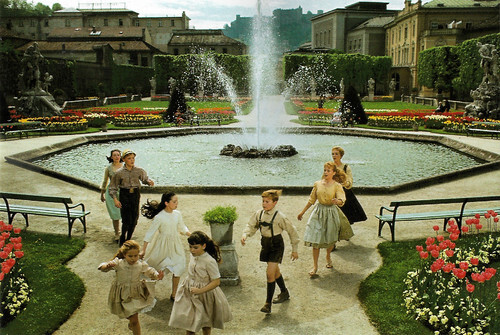
Austrian postcard by Colorama Verlag, Salzburg. Julie Andrews in The Sound of Music (Robert Wise, 1965). Caption: Salzburg - Home of the Sound of Music. Its characteristically large, symmetrical flower-beds make Mirabell Gardens a good example of a typical baroque park. Some of the lovely choreographed singing scenes of the movie were filmed here.
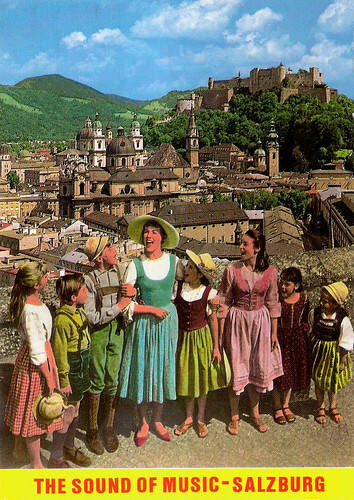
Austrian postcard by MM-Verlag, Salzburg, no. FS 3000. Photo: publicity still for The Sound of Music (Robert Wise, 1965).
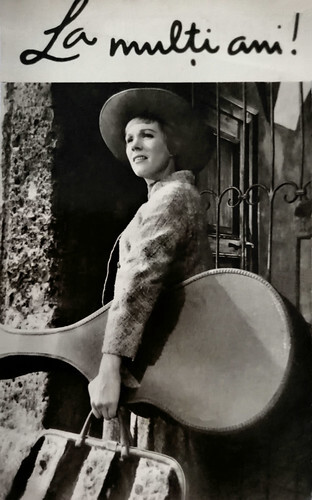
Romanian calendar card by Casa Filmui Acin. Collection: Alina Deaconu. Julie Andrews in The Sound of Music (Robert Wise, 1965).
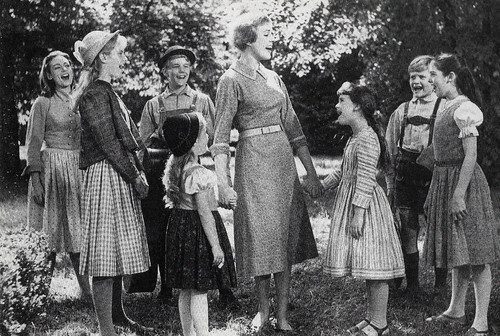
Belgian postcard by Raider Bounty Joepie. Julie Andrews in The Sound of Music (Robert Wise, 1965).
The Sound of Music
Now, Julie Andrews was a real star, and it was her star power that helped make her third film, The Sound of Music (Robert Wise, 1965), the highest-grossing film of its day and one of the highest-grossing of all time. For her role as Maria von Trapp, she won her second Golden Globe Award in 1966 and was nominated for the 1965 Academy Award.
After completing The Sound Of Music, Andrews appeared as a guest star on the NBC-TV variety series The Andy Williams Show, which gained her an Emmy nomination. She followed this with an Emmy Award-winning color special, The Julie Andrews Show in 1965.
By the end of 1967, Andrews had appeared in the television special Cinderella; the biggest Broadway musical of its time, 'My Fair Lady'; the largest-selling long-playing album, the original cast recording of 'My Fair Lady'; the biggest hit in Disney's history, Mary Poppins; the highest grossing movie of 1966, Hawaii (George Roy Hill, 1966); the biggest and second biggest hits in Universal's history, Thoroughly Modern Millie (George Roy Hill, 1967) and the espionage thriller Torn Curtain (Alfred Hitchcock, 1967); and the biggest hit in 20th Century Fox's history The Sound of Music.
Then, Andrews appeared in Star! (Robert Wise, 1968), a biopic of Gertrude Lawrence, and Darling Lili (Blake Edwards, 1970), co-starring Rock Hudson, but both films bombed at the box office. The problem was that audiences identified her with singing, sugary-sweet nannies and governesses, and could not accept her in dramatic roles.
She married American director Blake Edwards in 1969. Hal Erickson at AllMovie : "By marrying Edwards and aligning herself with him creatively, then, Andrews was also consciously or unconsciously bucking to change her image." They adopted two children from Vietnam: Amy in 1974 and Joanna in 1975.
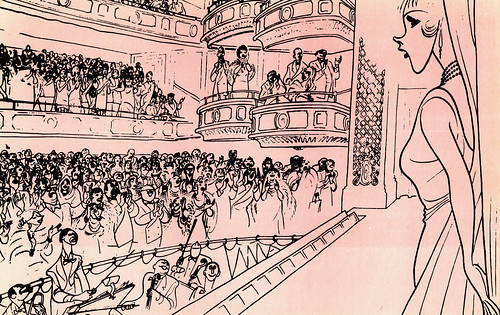
Vintage American postcard. Caricature by Al Hirschfeld. Caption on the back: “JULIE ANDREWS as the STAR! Drawn by the distinguished American artist, Al Hirschfeld, during a visit to the set of the Robert Wise Film, STAR !, directed by Robert Wise, produced by Saul Chaplin and released by 20th Century Fox.” Collection: Marlene Pilaete.
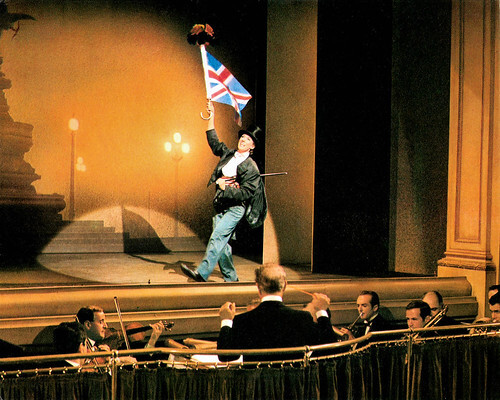
Italian photo by Rotograph, Roma. Photo: 20th Century Fox. Publicity still for Star! (Robert Wise, 1968).
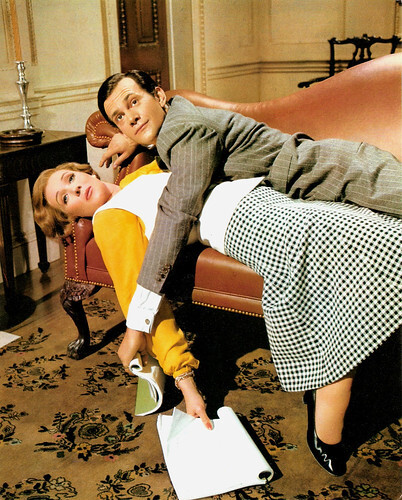
Italian photo by Rotograph, Roma. Photo: 20th Century Fox. Publicity still for Star! (Robert Wise, 1968) with Daniel Massey.
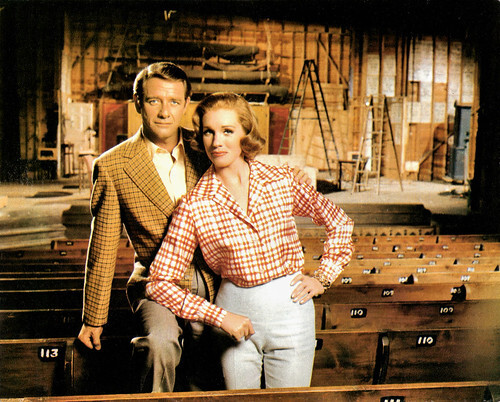
Italian photo by Rotograph, Roma. Photo: 20th Century Fox. Publicity still for Star! (Robert Wise, 1968) with Richard Crenna.
Bared breasts
Julie Andrews continued working in television. In 1969 she shared the spotlight with singer Harry Belafonte for an NBC-TV special, An Evening with Julie Andrews and Harry Belafonte. In 1971 she appeared as a guest for the Grand Opening Special of Walt Disney World, and that same year she and Carol Burnett headlined a CBS special, Julie and Carol At Lincoln Center.
In 1972–1973, Julie Andrews starred in her own television variety series, The Julie Andrews Hour, on the ABC network. The show won seven Emmy Awards, but was cancelled after one season. Between 1973 and 1975, Andrews continued her association with ABC by headlining five variety specials for the network. She guest-starred on The Muppet Show in 1977 and appeared again with the Muppets on a CBS-TV special, Julie Andrews: One Step Into Spring, which aired in 1978.
Then, she returned to the cinema with an appearance in 10 (1979), directed by her husband Blake Edwards. He helped to keep her on the rise by directing her in subsequent roles that were entirely different from anything she had done before. There was the film star Sally Miles who bared her breasts on-screen in S.O.B. (1981), and the woman (Victoria Grant) playing a man (Count Victor Grezhinski) playing a woman in Victor Victoria (1982).
At IMDb , Tommy Peter writes: “The sheer novelty of seeing Julie Andrews in these roles, not to mention her brilliant performances in both of them, undoubtedly helped make them successes”. Her roles in Victor/Victoria earned Andrews the 1983 Golden Globe Award for Best Actress, as well as a nomination for the 1982 Academy Award for Best Actress, her third Oscar nomination.
Victor/Victoria was followed by Edwards's François Truffaut remake, The Man Who Loved Women (Blake Edwards, 1983) with Andrews as the lover of sculptor Burt Reynolds and the excellent mid-life crisis comedy-drama That's Life! (Blake Edwards, 1986), starring Andrews and Jack Lemmon. In 1987, she starred in an ABC Christmas special, Julie Andrews: The Sound Of Christmas, which went on to win five Emmy Awards. Two years later she was reunited for the third time with Carol Burnett for a variety special which aired on ABC in 1989.
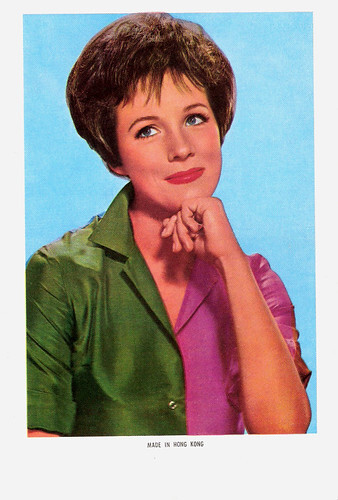
Vintage postcard made in Hong Kong.
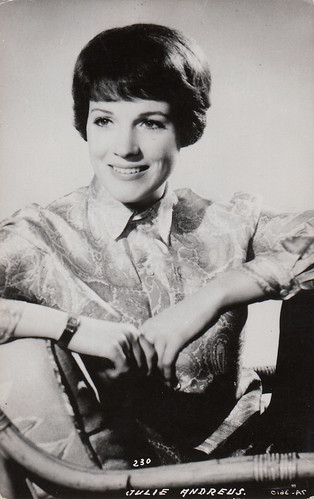
Mexican postcard by Sello, no. 230. Collection: Marlene Pilaete.
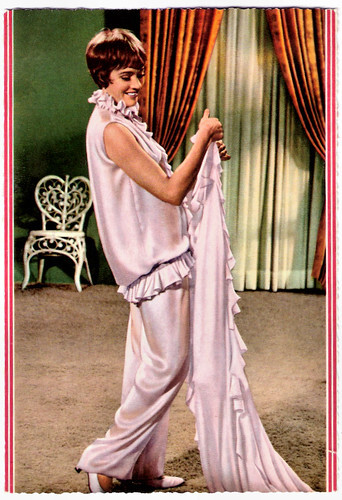
German postcard by Krüger, no. 902/410.
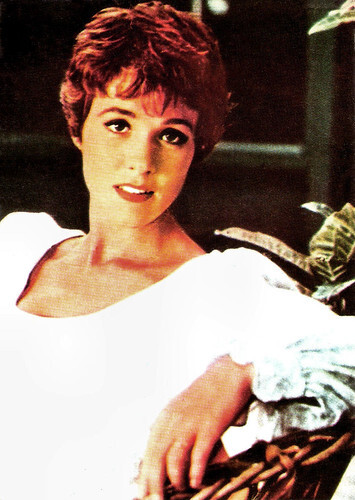
Romanian postcard by Filmului Acin, no. 43078.
Career Revival
In 1991 Julie Andrews made her television dramatic debut in the ABC made-for-TV movie, Our Sons (John Erman, 1991), co-starring Ann-Margret. The following year she starred in her first television sitcom, Julie (1992), which co-starred James Farentino.
In 1995 she starred in the stage musical version of Victor/Victoria, her first appearance in a Broadway show in 35 years. She was forced to quit the show towards the end of the Broadway run in 1997 when she developed vocal problems. She subsequently underwent surgery to remove non-cancerous nodules from her throat and was left unable to sing.
In 1999 she was reunited with James Garner for the TV film, One Special Night (Roger Young, 1999). In the 2000 New Year's Honours, Andrews was made a Dame Commander of the Order of the British Empire (DBE). She had a career revival when she appeared in The Princess Diaries (Garry Marshall, 2001), her first Disney film since Mary Poppins (1964). She starred as Queen Clarisse Marie Renaldi and reprised the role in a sequel, The Princess Diaries 2: Royal Engagement (Garry Marshall, 2004). In The Princess Diaries 2, Andrews sang on film for the first time since having throat surgery.
Andrews continued her association with Disney when she appeared as the nanny in two 2003 made-for-television movies based on the Eloise books, a series of children's books by Kay Thompson about a child who lives in the Plaza Hotel in New York City. The same year she made her debut as a theatre director, directing a revival of The Boy Friend, the musical in which she made her 1954 Broadway debut. In 2004 Andrews performed the voice of Queen Lillian in the animated blockbuster Shrek 2 (2004), reprising the role for its sequels, Shrek the Third (2007) and Shrek Forever After (2010).
She narrated Enchanted (Kevin Lima, 2007), a live-action Disney musical comedy that both poked fun and paid homage to classic Disney films such as Mary Poppins. In 2007 Andrews was honoured with the Lifetime Achievement Award at the Screen Actors Guild's awards and stated that her goals included continuing to direct for the stage and possibly produce her own Broadway musical.
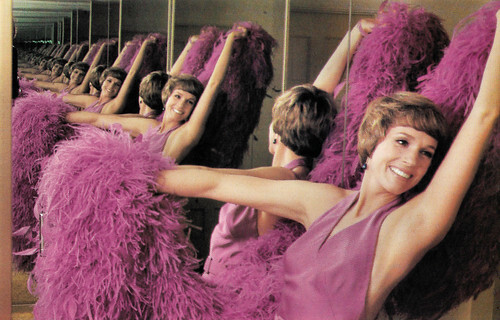
American postcard by Coral-Lee, Rancho Cordova, CA, Personality no. #60/1980. Photo: Douglas Kirkland / Contact, 1980.
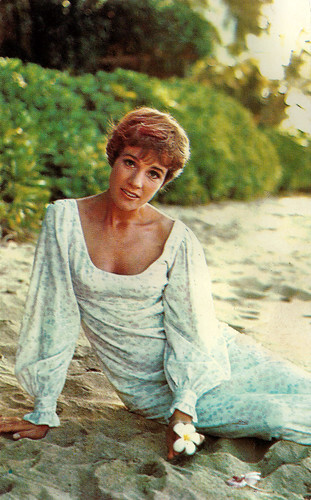
Romanian postcard by Casa Filmului Acin, no. 201.
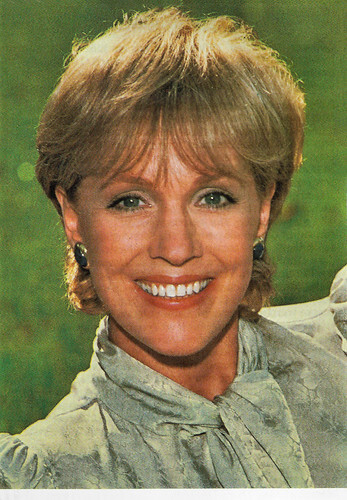
Dutch collectors card.
London come-back
Julie Andrews published Home: A Memoir of My Early Years (2008), which she characterised as 'part one' of her autobiography. Home chronicles her early years in UK's music hall circuit and ends in 1962 with her winning the role of Mary Poppins.
For a Walt Disney video release, she again portrayed Mary Poppins and narrated the story of The Cat That Looked at a King in 2004. In 2010, Andrews made her London come-back after a 21-year absence (her last performance there was a Christmas concert at the Royal Festival Hall in 1989).
She also maintained her status as a family film icon by voicing Gru's mother in the animated Despicable Me (Pierre Coffin, Chris Renaud, 2010), and playing opposite The Rock in Tooth Fairy (Michael Lembeck, 2010). Her husband Blake Edwards passed away in 2010 at the age of 88. In 2011, Andrews received a Grammy Lifetime Achievement Award and, with her daughter Emma, a Grammy for best-spoken word album for children (for A Collection of Poems, Songs and Lullabies).
At the age of 77, Andrews undertook her first tour of Australia and New Zealand in 2013. The tour was hosted by Nicholas Hammond who was a boy of 14 when they appeared together in The Sound of Music. In place of singing, she planned a series of speaking engagements in the five mainland state capitals.
Julie Andrews has long had something of a dual image, being both a family-friendly star and an icon for gays and lesbians. Andrews herself has acknowledged her strange status, commenting that "I'm that odd mixture of, on the one hand, being a gay icon and, on the other, having grandmas and parents grateful I'm around to be a babysitter for their kids."
Trailer Cinderella (1957). Source: Dylles (YouTube).
Original 1964 Mary Poppins Theatrical Trailer. Source: ThreeDogShampoo (YouTube).
Original Trailer of The Americanization of Emily (1964). Source: SupportingActor (YouTube).
Trailer of Torn Curtain (1966). Source: MovieTrailersGuy (YouTube).
Trailer of Star! (1968). Source: S7ilver (YouTube).
Julie Andrews guest stars on The Muppet Show (1977-1978) and sings The Lonely Goatherd. Source: Sparklesinbrum (YouTube).
Trailer SOB (1981). Source: JLEPSS96 (YouTube).
Trailer Victor/Victoria (1982). Source: GayMovieReviews (YouTube).
Sources: Hal Erickson (AllMovie), (IMDb), Wikipedia, and .

Italian postcard by Rotalcolor, Milano, no. 299.

Vintage postcard. Photo: still from Mary Poppins (1964).

French postcard by Les Presses de Belleville, Paris, no. 105. Photo: Walt Disney Productions. Julie Andrews and Dick Van Dyke in Mary Poppins (Robert Stevenson, 1964). Caption: The film that won 5 Oscars.

Romanian postcard by Casa Filmului Acin, no. 191. Julie Andrews in Thoroughly Modern Millie (George Roy Hill, 1967).
Big break
Julie Andrews was born Julia Elizabeth Wells in Walton-on-Thames, England, in 1935. Her mother, music hall performer Barbara Wells (née Morris), was married to Edward C. ‘Ted’ Wells, a teacher of metal and woodworking, but Andrews was conceived as a result of an affair her mother had with a family friend. With the outbreak of World War II, Barbara and Ted Wells went their separate ways. Ted Wells assisted with evacuating children to Surrey during the Blitz, while Barbara joined Ted Andrews in entertaining the troops. Barbara and Ted Wells were soon divorced and Barbara remarried to Ted Andrews in 1939.
Julie had lessons at the Cone-Ripman School, an independent arts educational school in London, and with the famous concert soprano and voice instructor Lilian Stiles-Allen. She continued her academic education at the Woodbrook School, a local state school in Beckenham. Julie performed spontaneously and unbilled on stage with her parents for about two years beginning in 1945.
She got her big break when her stepfather introduced her to Val Parnell, whose Moss Empires controlled prominent venues in London. Andrews made her professional solo debut at the London Hippodrome singing the difficult aria Je Suis Titania from Mignon as part of a musical revue called 'Starlight Roof' in 1947. She played the Hippodrome for one year.
In 1948 she became the youngest solo performer ever to be seen in a Royal Command Variety Performance. Julie followed her parents into radio and television and reportedly made her television debut on the BBC program 'RadiOlympia Showtime' in 1949. She garnered considerable fame throughout the United Kingdom for her work on the BBC radio comedy show Educating Archie (1950- 1952).
In 1954 on the eve of her 19th birthday, Julie Andrews made her Broadway debut portraying 1920s flapper Polly Browne in the already highly successful London musical 'The Boy Friend'. To the critics, Andrews was the stand-out performer in the show. In November 1955 Andrews was signed to appear with Bing Crosby in what is regarded as the first made-for-television movie, High Tor.

French postcard by Les Presses de Belleville, no. 101. Photo: Walt Disney Productions. Julie Andrews and Dick Van Dyke in Mary Poppins (Robert Stevenson, 1964).

French postcard by Les Presses de Belleville, no. 107. Photo: Walt Disney Productions. Still from Mary Poppins (1964).

French postcard. Photo: Walt Disney Productions. Julie Andrews and Dick Van Dyke in Mary Poppins (Robert Stevenson, 1964).

Spanish postcard by Ediciones Tarje Fher / Ediciones Mandolina, 1964. Photo: Walt Disney Productions. Still from Mary Poppins (1964).

Spanish postcard by Ediciones Tarje Fher / Ediciones Mandolina, 1964. Photo: Walt Disney Productions. Still from Mary Poppins (1964) with Dick van Dyke.
Oscars and Golden Globes
In 1956 Julie Andrews appeared in the Frederick Loewe and Alan Jay Lerner musical 'My Fair Lady' as Eliza Doolittle to Rex Harrison 's Henry Higgins. Producer Moss Hart had mercilessly drilled her for 48 hours to help her get her lines, songs and dialect in proper working order. Richard Rodgers was so impressed with her talent that concurrent with her run in My Fair Lady she was featured in the Rodgers and Hammerstein television musical, Cinderella (Ralph Nelson, 1957). Cinderella was broadcast live and attracted an estimated 107 million viewers.
She married set designer Tony Walton in 1959 in Weybridge, Surrey. They had first met in 1948 when Andrews was appearing at the London Casino in the show Humpty Dumpty. The couple filed for a divorce in 1967.
Alan Jay Lerner and Frederick Loewe - also the composers of My Fair Lady - developed the role of Queen Guinevere in their musical Camelot (1960) with Andrews in mind. The result, Camelot, with Richard Burton , was another Broadway triumph However, studio head Jack Warner decided Andrews lacked sufficient name recognition for her casting in the film version of My Fair Lady; Eliza was played by the established film actress Audrey Hepburn instead. As Warner later recalled, the decision was easy, "In my business, I have to know who brings people and their money to a movie theatre box office. Audrey Hepburn had never made a financial flop."
Andrews played the title role in Disney's Mary Poppins (Robert Stevenson, 1964), a lavish musical fantasy that combined live-action and animation. Walt Disney had seen a performance of Camelot and thought Andrews would be perfect for the role of the British nanny who is "practically perfect in every way!" Andrews initially declined because of pregnancy. With her husband, she headed back to the United Kingdom in 1962 for the birth of daughter Emma Katherine Walton. But Disney politely insisted. As a result of her performance in Mary Poppins, Andrews won the 1964 Academy Award for Best Actress and the 1965 Golden Globe Award.
She and her Mary Poppins co-stars also won the 1965 Grammy Award for Best Album for Children. As a measure of ‘sweet revenge’, as Poppins songwriter Richard M. Sherman put it, Andrews closed her acceptance speech at the Golden Globes by saying, "And, finally, my thanks to a man who made a wonderful movie and who made all this possible in the first place, Mr. Jack Warner." Next, she appeared opposite James Garner in The Americanization of Emily (Arthur Hiller, 1964), which she has described as her favourite film.

Austrian postcard by Colorama Verlag, Salzburg. Julie Andrews in The Sound of Music (Robert Wise, 1965). Caption: Salzburg - Home of the Sound of Music. Its characteristically large, symmetrical flower-beds make Mirabell Gardens a good example of a typical baroque park. Some of the lovely choreographed singing scenes of the movie were filmed here.

Austrian postcard by MM-Verlag, Salzburg, no. FS 3000. Photo: publicity still for The Sound of Music (Robert Wise, 1965).

Romanian calendar card by Casa Filmui Acin. Collection: Alina Deaconu. Julie Andrews in The Sound of Music (Robert Wise, 1965).

Belgian postcard by Raider Bounty Joepie. Julie Andrews in The Sound of Music (Robert Wise, 1965).
The Sound of Music
Now, Julie Andrews was a real star, and it was her star power that helped make her third film, The Sound of Music (Robert Wise, 1965), the highest-grossing film of its day and one of the highest-grossing of all time. For her role as Maria von Trapp, she won her second Golden Globe Award in 1966 and was nominated for the 1965 Academy Award.
After completing The Sound Of Music, Andrews appeared as a guest star on the NBC-TV variety series The Andy Williams Show, which gained her an Emmy nomination. She followed this with an Emmy Award-winning color special, The Julie Andrews Show in 1965.
By the end of 1967, Andrews had appeared in the television special Cinderella; the biggest Broadway musical of its time, 'My Fair Lady'; the largest-selling long-playing album, the original cast recording of 'My Fair Lady'; the biggest hit in Disney's history, Mary Poppins; the highest grossing movie of 1966, Hawaii (George Roy Hill, 1966); the biggest and second biggest hits in Universal's history, Thoroughly Modern Millie (George Roy Hill, 1967) and the espionage thriller Torn Curtain (Alfred Hitchcock, 1967); and the biggest hit in 20th Century Fox's history The Sound of Music.
Then, Andrews appeared in Star! (Robert Wise, 1968), a biopic of Gertrude Lawrence, and Darling Lili (Blake Edwards, 1970), co-starring Rock Hudson, but both films bombed at the box office. The problem was that audiences identified her with singing, sugary-sweet nannies and governesses, and could not accept her in dramatic roles.
She married American director Blake Edwards in 1969. Hal Erickson at AllMovie : "By marrying Edwards and aligning herself with him creatively, then, Andrews was also consciously or unconsciously bucking to change her image." They adopted two children from Vietnam: Amy in 1974 and Joanna in 1975.

Vintage American postcard. Caricature by Al Hirschfeld. Caption on the back: “JULIE ANDREWS as the STAR! Drawn by the distinguished American artist, Al Hirschfeld, during a visit to the set of the Robert Wise Film, STAR !, directed by Robert Wise, produced by Saul Chaplin and released by 20th Century Fox.” Collection: Marlene Pilaete.

Italian photo by Rotograph, Roma. Photo: 20th Century Fox. Publicity still for Star! (Robert Wise, 1968).

Italian photo by Rotograph, Roma. Photo: 20th Century Fox. Publicity still for Star! (Robert Wise, 1968) with Daniel Massey.

Italian photo by Rotograph, Roma. Photo: 20th Century Fox. Publicity still for Star! (Robert Wise, 1968) with Richard Crenna.
Bared breasts
Julie Andrews continued working in television. In 1969 she shared the spotlight with singer Harry Belafonte for an NBC-TV special, An Evening with Julie Andrews and Harry Belafonte. In 1971 she appeared as a guest for the Grand Opening Special of Walt Disney World, and that same year she and Carol Burnett headlined a CBS special, Julie and Carol At Lincoln Center.
In 1972–1973, Julie Andrews starred in her own television variety series, The Julie Andrews Hour, on the ABC network. The show won seven Emmy Awards, but was cancelled after one season. Between 1973 and 1975, Andrews continued her association with ABC by headlining five variety specials for the network. She guest-starred on The Muppet Show in 1977 and appeared again with the Muppets on a CBS-TV special, Julie Andrews: One Step Into Spring, which aired in 1978.
Then, she returned to the cinema with an appearance in 10 (1979), directed by her husband Blake Edwards. He helped to keep her on the rise by directing her in subsequent roles that were entirely different from anything she had done before. There was the film star Sally Miles who bared her breasts on-screen in S.O.B. (1981), and the woman (Victoria Grant) playing a man (Count Victor Grezhinski) playing a woman in Victor Victoria (1982).
At IMDb , Tommy Peter writes: “The sheer novelty of seeing Julie Andrews in these roles, not to mention her brilliant performances in both of them, undoubtedly helped make them successes”. Her roles in Victor/Victoria earned Andrews the 1983 Golden Globe Award for Best Actress, as well as a nomination for the 1982 Academy Award for Best Actress, her third Oscar nomination.
Victor/Victoria was followed by Edwards's François Truffaut remake, The Man Who Loved Women (Blake Edwards, 1983) with Andrews as the lover of sculptor Burt Reynolds and the excellent mid-life crisis comedy-drama That's Life! (Blake Edwards, 1986), starring Andrews and Jack Lemmon. In 1987, she starred in an ABC Christmas special, Julie Andrews: The Sound Of Christmas, which went on to win five Emmy Awards. Two years later she was reunited for the third time with Carol Burnett for a variety special which aired on ABC in 1989.

Vintage postcard made in Hong Kong.

Mexican postcard by Sello, no. 230. Collection: Marlene Pilaete.

German postcard by Krüger, no. 902/410.

Romanian postcard by Filmului Acin, no. 43078.
Career Revival
In 1991 Julie Andrews made her television dramatic debut in the ABC made-for-TV movie, Our Sons (John Erman, 1991), co-starring Ann-Margret. The following year she starred in her first television sitcom, Julie (1992), which co-starred James Farentino.
In 1995 she starred in the stage musical version of Victor/Victoria, her first appearance in a Broadway show in 35 years. She was forced to quit the show towards the end of the Broadway run in 1997 when she developed vocal problems. She subsequently underwent surgery to remove non-cancerous nodules from her throat and was left unable to sing.
In 1999 she was reunited with James Garner for the TV film, One Special Night (Roger Young, 1999). In the 2000 New Year's Honours, Andrews was made a Dame Commander of the Order of the British Empire (DBE). She had a career revival when she appeared in The Princess Diaries (Garry Marshall, 2001), her first Disney film since Mary Poppins (1964). She starred as Queen Clarisse Marie Renaldi and reprised the role in a sequel, The Princess Diaries 2: Royal Engagement (Garry Marshall, 2004). In The Princess Diaries 2, Andrews sang on film for the first time since having throat surgery.
Andrews continued her association with Disney when she appeared as the nanny in two 2003 made-for-television movies based on the Eloise books, a series of children's books by Kay Thompson about a child who lives in the Plaza Hotel in New York City. The same year she made her debut as a theatre director, directing a revival of The Boy Friend, the musical in which she made her 1954 Broadway debut. In 2004 Andrews performed the voice of Queen Lillian in the animated blockbuster Shrek 2 (2004), reprising the role for its sequels, Shrek the Third (2007) and Shrek Forever After (2010).
She narrated Enchanted (Kevin Lima, 2007), a live-action Disney musical comedy that both poked fun and paid homage to classic Disney films such as Mary Poppins. In 2007 Andrews was honoured with the Lifetime Achievement Award at the Screen Actors Guild's awards and stated that her goals included continuing to direct for the stage and possibly produce her own Broadway musical.

American postcard by Coral-Lee, Rancho Cordova, CA, Personality no. #60/1980. Photo: Douglas Kirkland / Contact, 1980.

Romanian postcard by Casa Filmului Acin, no. 201.

Dutch collectors card.
London come-back
Julie Andrews published Home: A Memoir of My Early Years (2008), which she characterised as 'part one' of her autobiography. Home chronicles her early years in UK's music hall circuit and ends in 1962 with her winning the role of Mary Poppins.
For a Walt Disney video release, she again portrayed Mary Poppins and narrated the story of The Cat That Looked at a King in 2004. In 2010, Andrews made her London come-back after a 21-year absence (her last performance there was a Christmas concert at the Royal Festival Hall in 1989).
She also maintained her status as a family film icon by voicing Gru's mother in the animated Despicable Me (Pierre Coffin, Chris Renaud, 2010), and playing opposite The Rock in Tooth Fairy (Michael Lembeck, 2010). Her husband Blake Edwards passed away in 2010 at the age of 88. In 2011, Andrews received a Grammy Lifetime Achievement Award and, with her daughter Emma, a Grammy for best-spoken word album for children (for A Collection of Poems, Songs and Lullabies).
At the age of 77, Andrews undertook her first tour of Australia and New Zealand in 2013. The tour was hosted by Nicholas Hammond who was a boy of 14 when they appeared together in The Sound of Music. In place of singing, she planned a series of speaking engagements in the five mainland state capitals.
Julie Andrews has long had something of a dual image, being both a family-friendly star and an icon for gays and lesbians. Andrews herself has acknowledged her strange status, commenting that "I'm that odd mixture of, on the one hand, being a gay icon and, on the other, having grandmas and parents grateful I'm around to be a babysitter for their kids."
Trailer Cinderella (1957). Source: Dylles (YouTube).
Original 1964 Mary Poppins Theatrical Trailer. Source: ThreeDogShampoo (YouTube).
Original Trailer of The Americanization of Emily (1964). Source: SupportingActor (YouTube).
Trailer of Torn Curtain (1966). Source: MovieTrailersGuy (YouTube).
Trailer of Star! (1968). Source: S7ilver (YouTube).
Julie Andrews guest stars on The Muppet Show (1977-1978) and sings The Lonely Goatherd. Source: Sparklesinbrum (YouTube).
Trailer SOB (1981). Source: JLEPSS96 (YouTube).
Trailer Victor/Victoria (1982). Source: GayMovieReviews (YouTube).
Sources: Hal Erickson (AllMovie), (IMDb), Wikipedia, and .
Published on September 10, 2023 22:00
September 9, 2023
Hans Albers
Jovial, pleasantly plump Hans Albers (1891-1960) was a superstar of German cinema between 1930 and 1945. He was also one of the most famous German singers of the twentieth century. His song 'Auf der Reeperbahn nachts um halb eins' (On the Reeperbahn at half past midnight) is the unofficial anthem of Hamburg’s neighbourhood of St. Pauli, famous for its brothels, music and nightclubs.
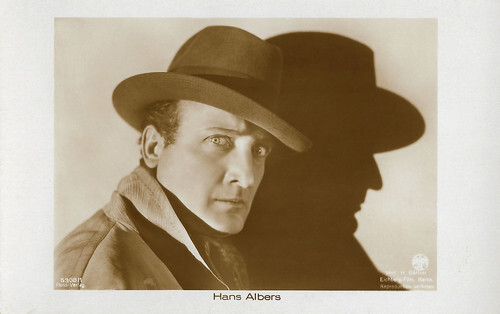
German postcard by Ross Verlag, no. 5308/1. Photo: H. Gärtner / SF / Eichberg-Film, Berlin. Hans Albers in Der Greifer/The Snatcher (Richard Eichberg, 1930).
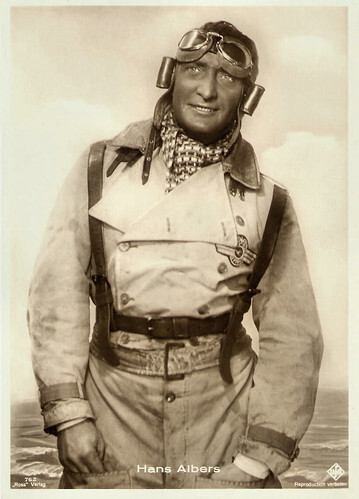
German Postcard by Ross Verlag, no. 762. Photo: Ufa.
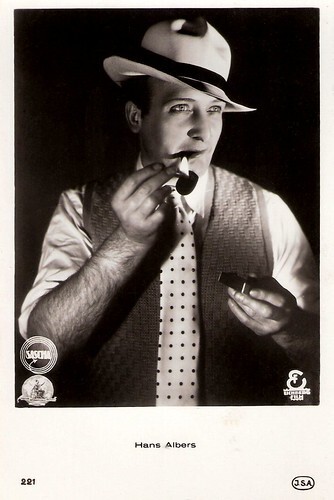
Dutch postcard by J.S.A., no. 221.
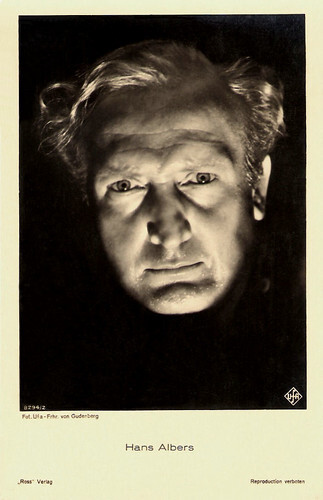
German Postcard by Ross Verlag, no. 8294/12, 1933-1934. Photo: Frhr. von Gudenberg / Ufa.
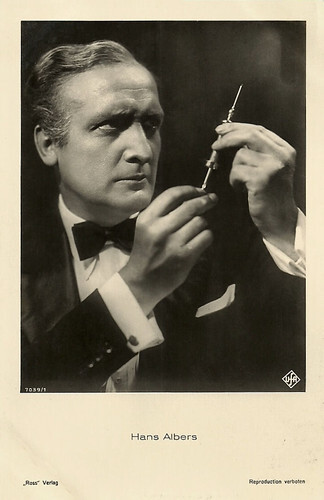
German postcard. by Ross Verlag, no. 7039/1, 1932-1933. Photo: Ufa. Publicity still for Der weiße Dämon/The White Demon (Kurt Gerron, 1932).
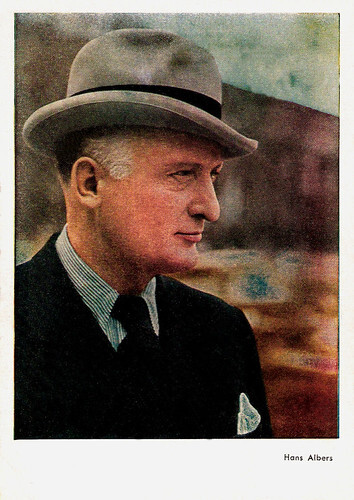
German postcard by Verlag und Drückerei Erwin Preuss, Dresden-Freital in the series Die neue farbige Filmstarkarte, Series 1, no. 13. Photo: Charlott Serda.
Blonde Hans
Hans Philipp August Albers was born in the North German port city of Hamburg in 1891. He was the son of a butcher and grew up in the Hamburg district of St. Georg. He was seriously interested in acting by his late teens and took acting classes without the knowledge of his parents.
He debuted as a stage actor in Bad Schwandau, followed by engagements in Frankfurt, Güstrow, Cologne and Hamburg. His first film part was in Jahreszeiten des Lebens/Seasons of Life (Franz Hofer, 1915).
Albers interrupted his career to serve in World War I, where he was badly wounded. After the war ‘der blonde Hans’ started as a comedic actor in various Berlin theatres. He appeared on-stage to great acclaim with Max Reinhardt 's Deutsches Theater. Albers' breakthrough performance was that of a waiter in Ferdinand Bruckner's play 'Verbrecher' (Criminals).
His film roles ranged from Demetrius in Ein Sommernachtstraum/A Midsummer Night's Dream (Hans Neumann, 1924) to the title character in Rasputins Liebesabenteuer/Rasputin (Martin Berger, 1928). In Weimar Berlin, he began a relationship with half-Jewish actress Hansi Burg in 1925. She was the daughter of his acting teacher Eugen Burg .
Albers stopped working in theatre to distance himself from the Hitler regime, but the Nazis forced him in 1935 to end his relationship with Hansi Burg, who in 1938 emigrated to England via Switzerland. They secretly remained a couple with him even managing to send her financial support. In 1944 Eugen Burg would be killed in the concentration camp Theresienstadt. Hansi Burg returned to Germany and Albers in 1946. Hans and Hansi would live together until his death in 1960.
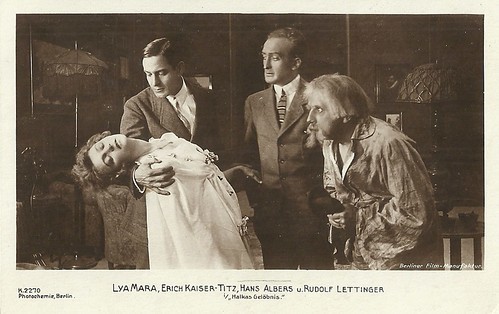
German postcard by Photochemie, Berlin, no. K. 2270. Photo: Berliner Film-Manufaktur. Lya Mara, Erich Kaiser-Titz, Hans Albers and Rudolf Lettinger in the German silent film Halkas Gelöbnis (H. Fredall, 1918). This postcard is one of a set of three cards that Photochemie issued on the film.
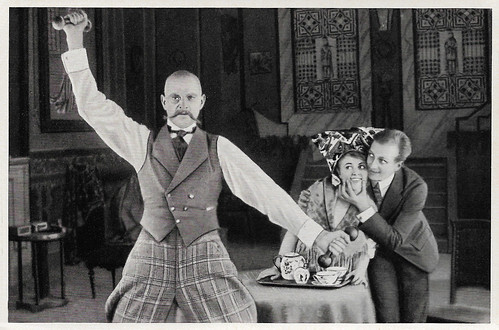
German collectors card by Ross Verlag in the series Vom Werden Deutscher Filmkunst - Der Stumme Film, picture no. 38, group 43. Photo: Paul Westermeier, Hanne Brinkmann and Hans Albers in Baroneßchen auf Strafurlaub/Little Baroness on Punishment Holiday (Otto Rippert, 1917). Caption: "Paul Westermeier 'hantelt', Hans Albers darf in einer kleinen Nebenrolle Hanne Brinkmann in die Wange kneifen". (Paul Westermeier 'works out', Hans Albers - in a small secondary role - is allowed to pinch Hanne Brinkmann in the cheek.)
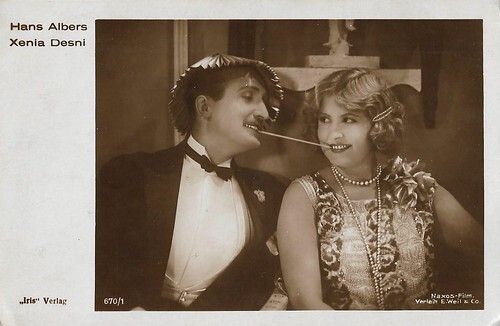
Austrian postcard by Iris Verlag, no. 670/1. Photo: Naxos-Film / Austrian distr. E. Weil. Hans Albers and Xenia Desni in the German silent film comedy Nixchen (Kurt Blachnitzky, 1926).
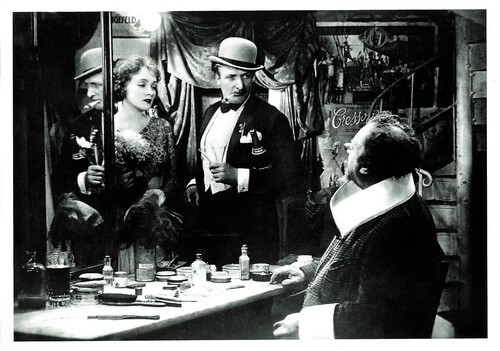
German postcard by Film und Fotografie, no. A 85. Photo: Sammlung Eickemeyer, Berlin. Emil Jannings, Hans Albers and Marlene Dietrich in Der blaue Engel/The Blue Angel (Josef von Sternberg, 1930).
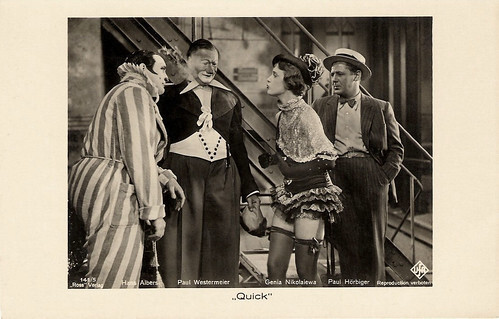
German postcard by Ross Verlag, no. 141/5, 1931-1932. Photo: Ufa. Publicity still with Paul Hörbiger , Paul Westermeier and Genia Nikolaieva in Quick (Robert Siodmak, 1931).
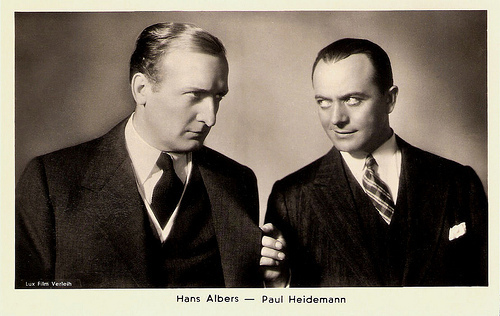
With Paul Heidemann . Austrian Postcard by Iris Verlag, no. 6699. Photo: Lux Film Verleih.
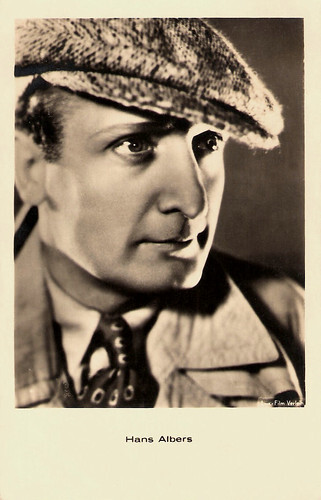
Austrian Postcard by Iris Verlag, no. 6269. Photo: Lux Film Verleih.
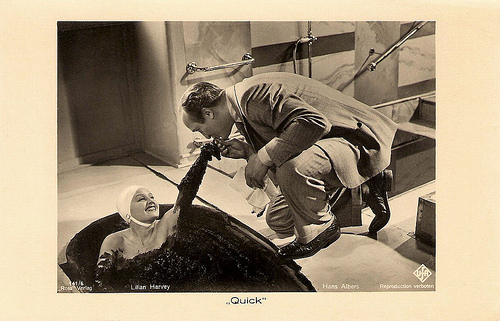
German postcard by Ross Verlag, no. 141/6. Photo: Ufa. Lilian Harvey and Hans Albers in Quick (Robert Siodmak, 1931). Collection: Geoffrey Donaldson Institute.
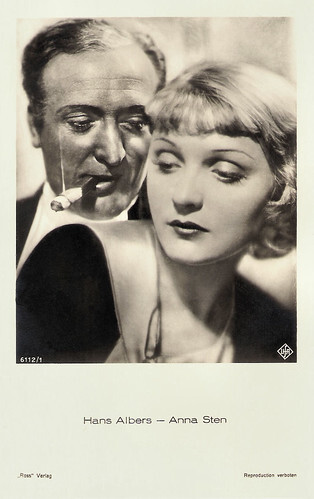
German postcard by Ross Verlag, no. 6112/1, 1931-1932. Photo: Ufa. Anna Sten and Hans Albers in Bomben auf Monte Carlo (Hanns Schwarz, 1931).
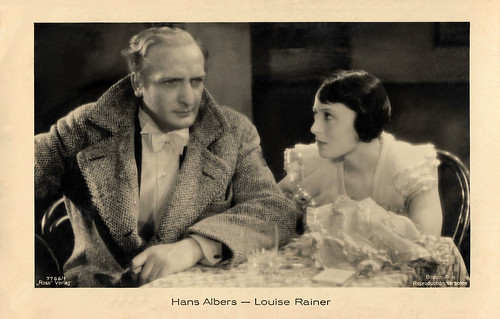
German postcard by Ross Verlag, no. 7766/1, 1932-1933. Photo: Boston-Film. Hans Albers and Luise Rainer in Heut' kommt's drauf an/Today it depends (Kurt Gerron, 1933). This film, now considered lost, was the second film with Luise Rainer.
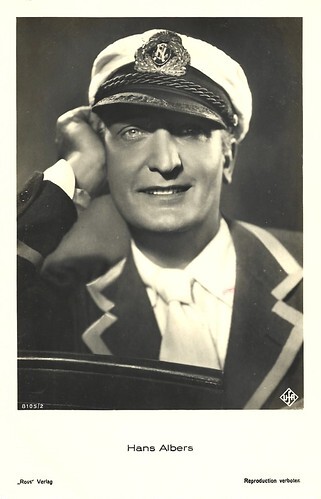
German postcard by Ross Verlag, no. 8105/2, 1933-1934. Photo: Ufa. Hans Albers in Ein gewisser Herr Gran (Gerhard Lamprecht, 1933).
Big-mouthed strong man
After roles in over one hundred silent films, Hans Albers starred in the first German talkie, the romance Die Nacht gehört uns/The Night Belongs to Us (Carl Froelich, 1929) with Charlotte Ander .
He then played big-mouthed strong man Mazeppa alongside Emil Jannings and Marlene Dietrich in Der blaue Engel/The Blue Angel (Josef von Sternberg, 1930), the film which made Dietrich an international star.
Albers himself shot to fame with Der Greifer/The Snatcher (Richard Eichberg, 1930) about three crooks who are planning a jewel robbery. Albers enhanced his star status with similar daredevil roles in the 1930s.
He was probably at his best when teamed up with Heinz Rühmann , as in Bomben auf Monte Carlo/Bombs Over Monte Carlo (Hanns Schwarz, 1931) and Der Mann, der Sherlock Holmes war/The Man Who Was Sherlock Holmes (Karl Hartl, 1937).
In the latter film Albers and Rühmann play two confidence tricksters who pretend to be the famous duo Holmes & Dr. Watson and the police, gangsters and girls believe them beyond any doubt. Another success was the comedy Quick (Robert Siodmak, 1932) in which he played a clown opposite Lilian Harvey .
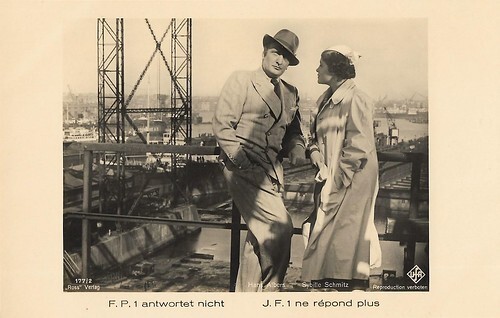
German postcard by Ross Verlag, no. 7518/1, 1932-1933. Photo: Ufa. Sybille Schmitz and Hans Albers in F.P.1 antwortet nicht/F.P.1 Doesn't Answer (Karl Hartl, 1932).
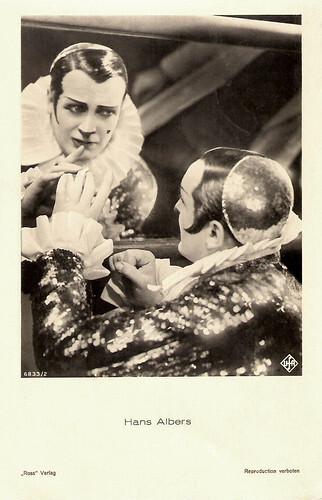
German Postcard by Ross Verlag, no. 6833/2, 1931-1932. Photo: Ufa.
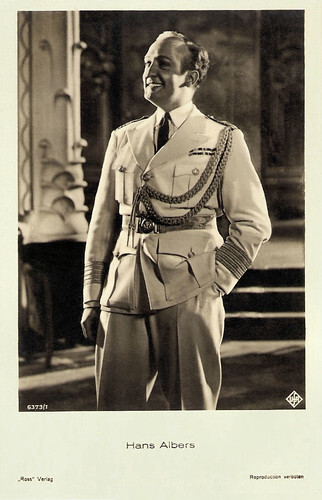
German postcard by Ross Verlag, no. 6373/1, 1931-1932. Photo: Ufa.
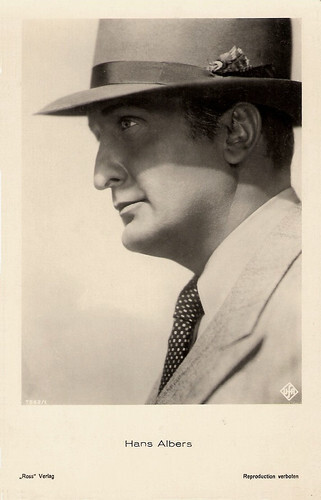
German Postcard by Ross Verlag, no. 7562/1, 1932-1933. Photo: Ufa.
Massive hits
Many of Hans Albers' songs from his films became massive hits and some even remain popular to this day. While Albers himself never supported the Nazi regime, he became the most popular actor of the Third Reich.
Albers was paid a considerable sum of money to star in Ufa's big-budgeted anniversary picture Münchhausen/The Adventures of Baron Munchausen (Josef von Baky, 1943) but was always careful not to give the impression that he was endorsing the National Socialist regime. Joseph Goebbels, Reich Minister of Propaganda in Nazi Germany had commissioned this lavish production as a commemoration of the 25th anniversary of Ufa, the government-run German film association.
More importantly, it was also to be a rival of the great fantasy films which had come from the Allied nations, such as The Wizard of Oz (Victor Fleming, 1939) and The Thief of Bagdad (Ludwig Berger, Michael Powell, Tim Whelan, 1940). On IMDb , Ron Oliver writes: "In that, it succeeds brilliantly and needs no comparison to any other film."
In 1943 Albers also starred in another classic, Große Freiheit Nr. 7/Great Freedom No. 7 (Helmut Käutner, 1943) with Ilse Werner . The film was banned by the censorship of the Third Reich because the story was considered too 'anti-heroic' and demoralising how German sailors and women were portrayed. The film could only be shown outside Germany.
IMDb reviewer Jan Onderwater comments: "From directing till script, from acting till (Agfa colour) photography this is a brilliant film, with everyone involved giving the best of their talents. What we see is a compelling drama, well balanced, psychologically well conceived and at the same time a film that is great fun to watch over and over again. In this film, there are only people and their lives who are not up to standard Nazi definition."
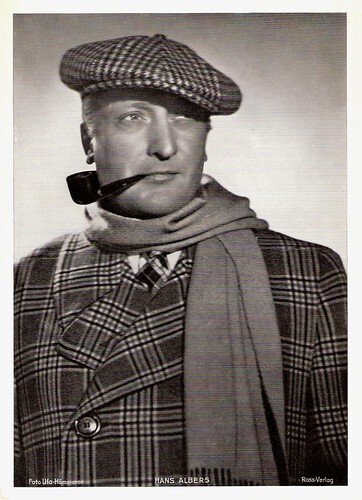
Big card by Ross Verlag. Photo: Ufa / Hämmerer.
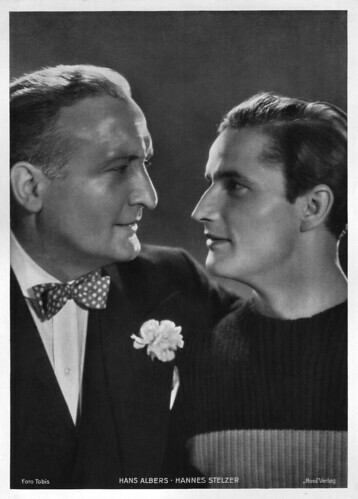
Big German collectors card by Ross Verlag. Photo: Tobis. Hans Albers and Hannes Stelzer in Fahrendes Volk/Travelling people (Jacques Feyder, 1938).
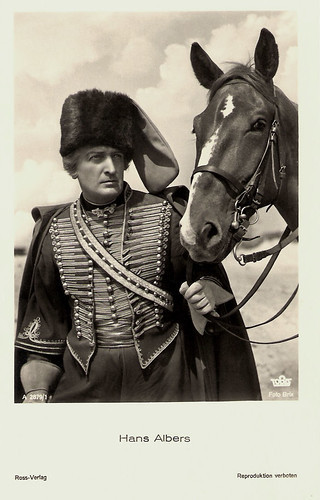
German Postcard by Ross Verlag, no. A 2879/112, 1939-1940. Photo: Brix / Tobis. Publicity still for Trenck, der Pandur/Trenck the Pandur (Herbert Selpin, 1940).
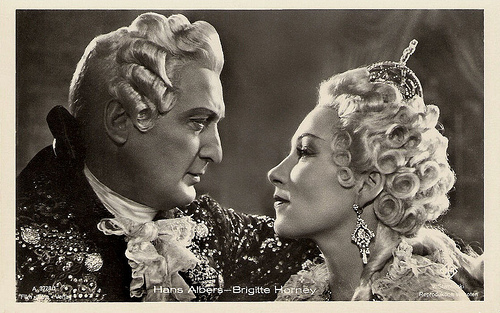
German postcard by Film-Foto-Verlag, no. A 3728/1, 1941-1944. Photo: V. Swolinski / Ufa. Publicity still for Munchhausen/The Adventures of Baron Munchausen (Josef von Baky, 1943) with Hans Albers and Brigitte Horney .
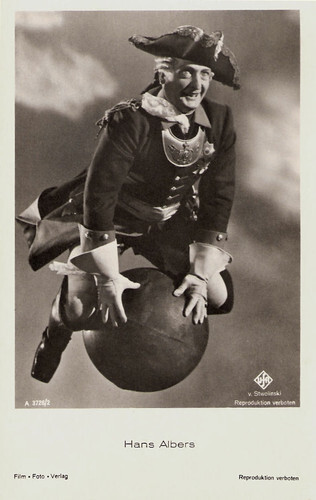
German postcard. Film-Foto-Verlag, no. A 3728/2, 1941-1944. Photo: von Stwolinski / Ufa. Publicity still for Münchhausen/The Adventures of Baron Munchhausen (Josef von Baky, 1943).
St. Pauli
After World War II, Hans Albers matured into character parts to some public and critical acclaim, but he never again enjoyed the huge stardom of the 1930s and early 1940s. One of his better roles of this period was an ageing industry tycoon in Vor Sonnenuntergang/Before Sundown (Gottfried Reinhardt, 1956), which won the Golden Globe as Best Foreign Film of the Year.
On IMDb reviewer Diger Jantzen notes: "Hans Albers' performance is heartbreaking from the start until the end and it is clearly one of his best serious performances ever." Albers' final film was the crime comedy Kein Engel ist so rein/No Angel Is That Pure (Wolfgang Becker, 1960) with Sabine Sinjen .
Today he is probably more known for his music than his films, and his music is still widely-known in modern Germany, even among young people. Many of Albers' songs were humorous tales of drunken, womanising sailors on shore leave, with double entendres such as "It hurts the first time, but with time, you get used to it" in reference to a girl falling in love for the first time. Albers' songs were often peppered with expressions in Low German, which is spoken in Northern Germany.
His most famous song is by far 'Auf der Reeperbahn nachts um halb eins' (On the Reeperbahn at half past midnight) which has become the unofficial anthem of the colourful neighbourhood of St. Pauli. The Hans-Albers-Platz, one block south of the Reeperbahn, has a statue of Albers, by the German artist Jörg Immendorff. Outside of Northern Europe, however, Albers remains virtually unknown, although the image of an older man in a seaman's cap and raincoat playing accordion and singing may be recognised by many outside of Germany, even if they don't know that this image is based on Hans Albers.
As a case in point, McDonald's used such an image in an American television ad campaign in 1986. In reality, Albers had no experience on the water, this being restricted to a one-day trip to Helgoland. Hans Albers died in Kempfenhausen, Bavaria, in 1960. After his death, the Wilhelmplatz, a square in St. Pauli, was named after him. In 1989, Hans Albers was the subject of a biographical docudrama, In Meinem Hertzen Schatz/In My Heart's Treasure.
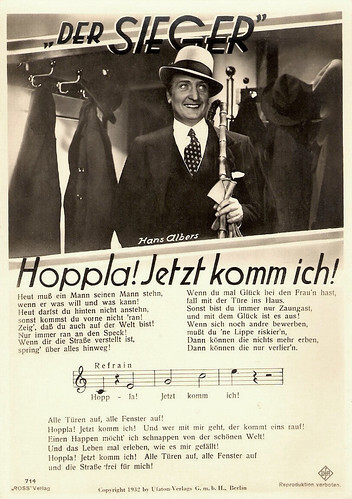
German Postcard by Ross Verlag, no. 714, 1932. Photo: Ufa.
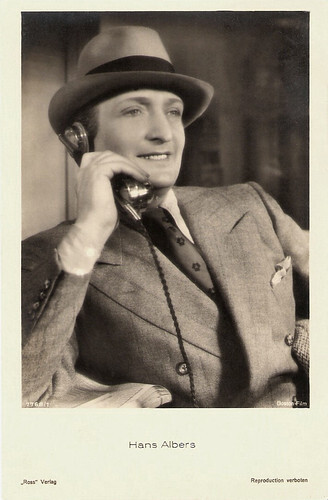
German postcard by Ross Verlag, no. 7768/1, 1932-1933. Photo: Boston-Film.
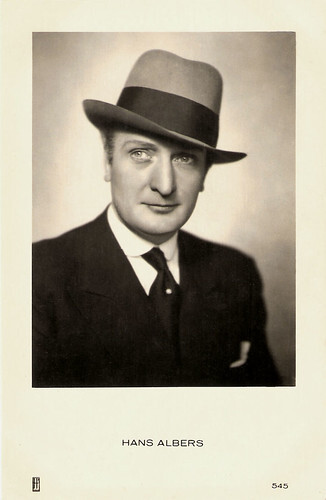
Dutch Postcard by JosPe, no. 545.
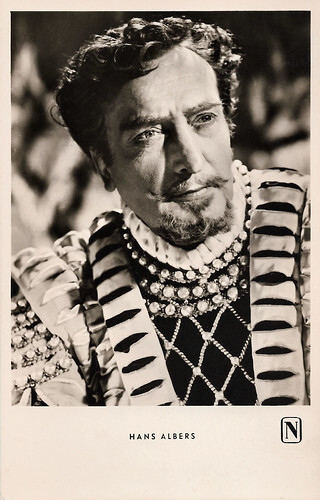
West German postcard by Kunst und Bild, Berlin, no. A 441. Photo: Nationalfilm. Hans Albers in Barbe-Bleue/Blaubart/Bluebeard (Christian-Jacque, 1951).
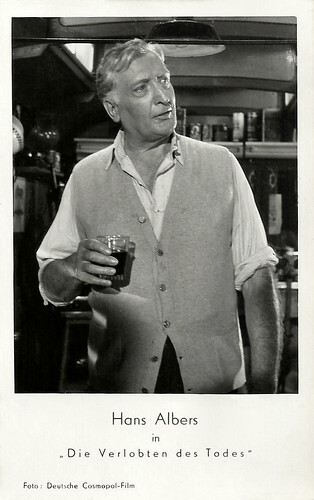
German postcard. Photto: Deutsche Cosmopol-Film. Publicity still for Die Verlobten des Todes/I fidanzati della morte (Romolo Marcellini, 1957).
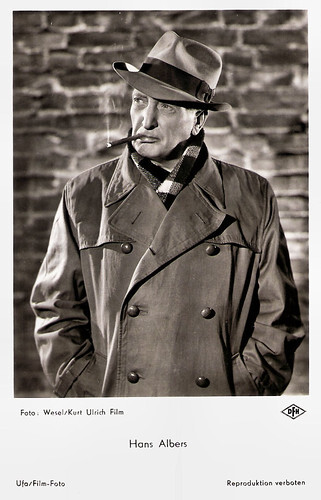
West German postcard by Ufa/Film-Foto, Berlin-Tempelhof, no. FK 3987. Photo: Wesel / Kurt Ulrich Film / DFH. Hans Albers in Der Greifer/The Ripper (Eugen York, 1958).
Sources: Hal Erickson (AllMovie), Thomas Staedeli (Cyranos), Filmportal.de, Wikipedia and .

German postcard by Ross Verlag, no. 5308/1. Photo: H. Gärtner / SF / Eichberg-Film, Berlin. Hans Albers in Der Greifer/The Snatcher (Richard Eichberg, 1930).

German Postcard by Ross Verlag, no. 762. Photo: Ufa.

Dutch postcard by J.S.A., no. 221.

German Postcard by Ross Verlag, no. 8294/12, 1933-1934. Photo: Frhr. von Gudenberg / Ufa.

German postcard. by Ross Verlag, no. 7039/1, 1932-1933. Photo: Ufa. Publicity still for Der weiße Dämon/The White Demon (Kurt Gerron, 1932).

German postcard by Verlag und Drückerei Erwin Preuss, Dresden-Freital in the series Die neue farbige Filmstarkarte, Series 1, no. 13. Photo: Charlott Serda.
Blonde Hans
Hans Philipp August Albers was born in the North German port city of Hamburg in 1891. He was the son of a butcher and grew up in the Hamburg district of St. Georg. He was seriously interested in acting by his late teens and took acting classes without the knowledge of his parents.
He debuted as a stage actor in Bad Schwandau, followed by engagements in Frankfurt, Güstrow, Cologne and Hamburg. His first film part was in Jahreszeiten des Lebens/Seasons of Life (Franz Hofer, 1915).
Albers interrupted his career to serve in World War I, where he was badly wounded. After the war ‘der blonde Hans’ started as a comedic actor in various Berlin theatres. He appeared on-stage to great acclaim with Max Reinhardt 's Deutsches Theater. Albers' breakthrough performance was that of a waiter in Ferdinand Bruckner's play 'Verbrecher' (Criminals).
His film roles ranged from Demetrius in Ein Sommernachtstraum/A Midsummer Night's Dream (Hans Neumann, 1924) to the title character in Rasputins Liebesabenteuer/Rasputin (Martin Berger, 1928). In Weimar Berlin, he began a relationship with half-Jewish actress Hansi Burg in 1925. She was the daughter of his acting teacher Eugen Burg .
Albers stopped working in theatre to distance himself from the Hitler regime, but the Nazis forced him in 1935 to end his relationship with Hansi Burg, who in 1938 emigrated to England via Switzerland. They secretly remained a couple with him even managing to send her financial support. In 1944 Eugen Burg would be killed in the concentration camp Theresienstadt. Hansi Burg returned to Germany and Albers in 1946. Hans and Hansi would live together until his death in 1960.

German postcard by Photochemie, Berlin, no. K. 2270. Photo: Berliner Film-Manufaktur. Lya Mara, Erich Kaiser-Titz, Hans Albers and Rudolf Lettinger in the German silent film Halkas Gelöbnis (H. Fredall, 1918). This postcard is one of a set of three cards that Photochemie issued on the film.

German collectors card by Ross Verlag in the series Vom Werden Deutscher Filmkunst - Der Stumme Film, picture no. 38, group 43. Photo: Paul Westermeier, Hanne Brinkmann and Hans Albers in Baroneßchen auf Strafurlaub/Little Baroness on Punishment Holiday (Otto Rippert, 1917). Caption: "Paul Westermeier 'hantelt', Hans Albers darf in einer kleinen Nebenrolle Hanne Brinkmann in die Wange kneifen". (Paul Westermeier 'works out', Hans Albers - in a small secondary role - is allowed to pinch Hanne Brinkmann in the cheek.)

Austrian postcard by Iris Verlag, no. 670/1. Photo: Naxos-Film / Austrian distr. E. Weil. Hans Albers and Xenia Desni in the German silent film comedy Nixchen (Kurt Blachnitzky, 1926).

German postcard by Film und Fotografie, no. A 85. Photo: Sammlung Eickemeyer, Berlin. Emil Jannings, Hans Albers and Marlene Dietrich in Der blaue Engel/The Blue Angel (Josef von Sternberg, 1930).

German postcard by Ross Verlag, no. 141/5, 1931-1932. Photo: Ufa. Publicity still with Paul Hörbiger , Paul Westermeier and Genia Nikolaieva in Quick (Robert Siodmak, 1931).

With Paul Heidemann . Austrian Postcard by Iris Verlag, no. 6699. Photo: Lux Film Verleih.

Austrian Postcard by Iris Verlag, no. 6269. Photo: Lux Film Verleih.

German postcard by Ross Verlag, no. 141/6. Photo: Ufa. Lilian Harvey and Hans Albers in Quick (Robert Siodmak, 1931). Collection: Geoffrey Donaldson Institute.

German postcard by Ross Verlag, no. 6112/1, 1931-1932. Photo: Ufa. Anna Sten and Hans Albers in Bomben auf Monte Carlo (Hanns Schwarz, 1931).

German postcard by Ross Verlag, no. 7766/1, 1932-1933. Photo: Boston-Film. Hans Albers and Luise Rainer in Heut' kommt's drauf an/Today it depends (Kurt Gerron, 1933). This film, now considered lost, was the second film with Luise Rainer.

German postcard by Ross Verlag, no. 8105/2, 1933-1934. Photo: Ufa. Hans Albers in Ein gewisser Herr Gran (Gerhard Lamprecht, 1933).
Big-mouthed strong man
After roles in over one hundred silent films, Hans Albers starred in the first German talkie, the romance Die Nacht gehört uns/The Night Belongs to Us (Carl Froelich, 1929) with Charlotte Ander .
He then played big-mouthed strong man Mazeppa alongside Emil Jannings and Marlene Dietrich in Der blaue Engel/The Blue Angel (Josef von Sternberg, 1930), the film which made Dietrich an international star.
Albers himself shot to fame with Der Greifer/The Snatcher (Richard Eichberg, 1930) about three crooks who are planning a jewel robbery. Albers enhanced his star status with similar daredevil roles in the 1930s.
He was probably at his best when teamed up with Heinz Rühmann , as in Bomben auf Monte Carlo/Bombs Over Monte Carlo (Hanns Schwarz, 1931) and Der Mann, der Sherlock Holmes war/The Man Who Was Sherlock Holmes (Karl Hartl, 1937).
In the latter film Albers and Rühmann play two confidence tricksters who pretend to be the famous duo Holmes & Dr. Watson and the police, gangsters and girls believe them beyond any doubt. Another success was the comedy Quick (Robert Siodmak, 1932) in which he played a clown opposite Lilian Harvey .

German postcard by Ross Verlag, no. 7518/1, 1932-1933. Photo: Ufa. Sybille Schmitz and Hans Albers in F.P.1 antwortet nicht/F.P.1 Doesn't Answer (Karl Hartl, 1932).

German Postcard by Ross Verlag, no. 6833/2, 1931-1932. Photo: Ufa.

German postcard by Ross Verlag, no. 6373/1, 1931-1932. Photo: Ufa.

German Postcard by Ross Verlag, no. 7562/1, 1932-1933. Photo: Ufa.
Massive hits
Many of Hans Albers' songs from his films became massive hits and some even remain popular to this day. While Albers himself never supported the Nazi regime, he became the most popular actor of the Third Reich.
Albers was paid a considerable sum of money to star in Ufa's big-budgeted anniversary picture Münchhausen/The Adventures of Baron Munchausen (Josef von Baky, 1943) but was always careful not to give the impression that he was endorsing the National Socialist regime. Joseph Goebbels, Reich Minister of Propaganda in Nazi Germany had commissioned this lavish production as a commemoration of the 25th anniversary of Ufa, the government-run German film association.
More importantly, it was also to be a rival of the great fantasy films which had come from the Allied nations, such as The Wizard of Oz (Victor Fleming, 1939) and The Thief of Bagdad (Ludwig Berger, Michael Powell, Tim Whelan, 1940). On IMDb , Ron Oliver writes: "In that, it succeeds brilliantly and needs no comparison to any other film."
In 1943 Albers also starred in another classic, Große Freiheit Nr. 7/Great Freedom No. 7 (Helmut Käutner, 1943) with Ilse Werner . The film was banned by the censorship of the Third Reich because the story was considered too 'anti-heroic' and demoralising how German sailors and women were portrayed. The film could only be shown outside Germany.
IMDb reviewer Jan Onderwater comments: "From directing till script, from acting till (Agfa colour) photography this is a brilliant film, with everyone involved giving the best of their talents. What we see is a compelling drama, well balanced, psychologically well conceived and at the same time a film that is great fun to watch over and over again. In this film, there are only people and their lives who are not up to standard Nazi definition."

Big card by Ross Verlag. Photo: Ufa / Hämmerer.

Big German collectors card by Ross Verlag. Photo: Tobis. Hans Albers and Hannes Stelzer in Fahrendes Volk/Travelling people (Jacques Feyder, 1938).

German Postcard by Ross Verlag, no. A 2879/112, 1939-1940. Photo: Brix / Tobis. Publicity still for Trenck, der Pandur/Trenck the Pandur (Herbert Selpin, 1940).

German postcard by Film-Foto-Verlag, no. A 3728/1, 1941-1944. Photo: V. Swolinski / Ufa. Publicity still for Munchhausen/The Adventures of Baron Munchausen (Josef von Baky, 1943) with Hans Albers and Brigitte Horney .

German postcard. Film-Foto-Verlag, no. A 3728/2, 1941-1944. Photo: von Stwolinski / Ufa. Publicity still for Münchhausen/The Adventures of Baron Munchhausen (Josef von Baky, 1943).
St. Pauli
After World War II, Hans Albers matured into character parts to some public and critical acclaim, but he never again enjoyed the huge stardom of the 1930s and early 1940s. One of his better roles of this period was an ageing industry tycoon in Vor Sonnenuntergang/Before Sundown (Gottfried Reinhardt, 1956), which won the Golden Globe as Best Foreign Film of the Year.
On IMDb reviewer Diger Jantzen notes: "Hans Albers' performance is heartbreaking from the start until the end and it is clearly one of his best serious performances ever." Albers' final film was the crime comedy Kein Engel ist so rein/No Angel Is That Pure (Wolfgang Becker, 1960) with Sabine Sinjen .
Today he is probably more known for his music than his films, and his music is still widely-known in modern Germany, even among young people. Many of Albers' songs were humorous tales of drunken, womanising sailors on shore leave, with double entendres such as "It hurts the first time, but with time, you get used to it" in reference to a girl falling in love for the first time. Albers' songs were often peppered with expressions in Low German, which is spoken in Northern Germany.
His most famous song is by far 'Auf der Reeperbahn nachts um halb eins' (On the Reeperbahn at half past midnight) which has become the unofficial anthem of the colourful neighbourhood of St. Pauli. The Hans-Albers-Platz, one block south of the Reeperbahn, has a statue of Albers, by the German artist Jörg Immendorff. Outside of Northern Europe, however, Albers remains virtually unknown, although the image of an older man in a seaman's cap and raincoat playing accordion and singing may be recognised by many outside of Germany, even if they don't know that this image is based on Hans Albers.
As a case in point, McDonald's used such an image in an American television ad campaign in 1986. In reality, Albers had no experience on the water, this being restricted to a one-day trip to Helgoland. Hans Albers died in Kempfenhausen, Bavaria, in 1960. After his death, the Wilhelmplatz, a square in St. Pauli, was named after him. In 1989, Hans Albers was the subject of a biographical docudrama, In Meinem Hertzen Schatz/In My Heart's Treasure.

German Postcard by Ross Verlag, no. 714, 1932. Photo: Ufa.

German postcard by Ross Verlag, no. 7768/1, 1932-1933. Photo: Boston-Film.

Dutch Postcard by JosPe, no. 545.

West German postcard by Kunst und Bild, Berlin, no. A 441. Photo: Nationalfilm. Hans Albers in Barbe-Bleue/Blaubart/Bluebeard (Christian-Jacque, 1951).

German postcard. Photto: Deutsche Cosmopol-Film. Publicity still for Die Verlobten des Todes/I fidanzati della morte (Romolo Marcellini, 1957).

West German postcard by Ufa/Film-Foto, Berlin-Tempelhof, no. FK 3987. Photo: Wesel / Kurt Ulrich Film / DFH. Hans Albers in Der Greifer/The Ripper (Eugen York, 1958).
Sources: Hal Erickson (AllMovie), Thomas Staedeli (Cyranos), Filmportal.de, Wikipedia and .
Published on September 09, 2023 22:00
Paul van Yperen's Blog
- Paul van Yperen's profile
- 13 followers
Paul van Yperen isn't a Goodreads Author
(yet),
but they
do have a blog,
so here are some recent posts imported from
their feed.



